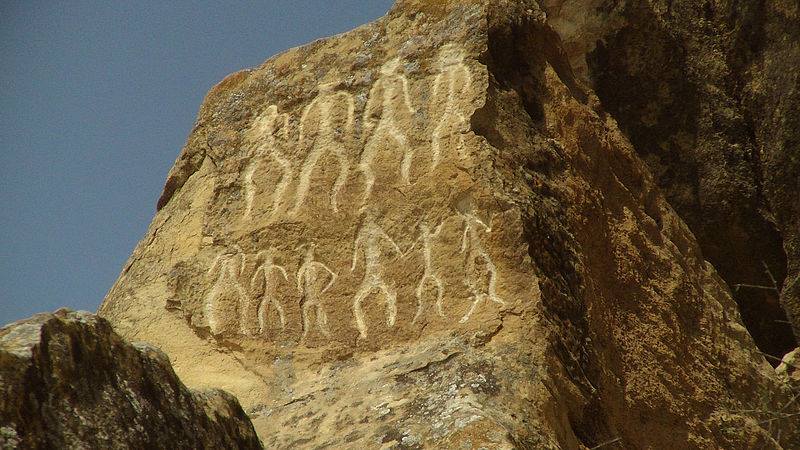
The historical lands of Azerbaijan, which covered the Great Caucasus Mountains in the north, the Alagez mountain range with a basin of Lake Goycha and Eastern Anatolia in the west, the Caspian Sea in the east, and the boundaries of Sultania, Zanjan, and Hamadan in the south, are one of the centers of ancient culture and the cradle modern civilization. On this territory – on the historical lands of Azerbaijan – the Azerbaijani people have created a rich and original culture, including the traditions of statehood. The historical pronunciation of the name « Azerbaijan » was different. Since ancient times, from the beginnings of civilization, this name sounded like Andirpatian, Atropatena, Adirbidzhan, Azirbidzhan, and, finally, Azerbaijan. Writing in a modern form – « Azerbaijan », is based on ancient historical, anthropological, ethnographic, and written sources.
Objects discovered during archaeological excavations, as well as ethnographic materials collected during expeditions, made it possible to study traditions and customs, material and spiritual culture, ancient forms of government, family relationships in Azerbaijan.
To date, the most ancient archaeological and paleontological materials have been discovered, indicating that primitive people lived on the territory of Azerbaijan more than 1.7-1.8 million years ago.
The territory of Azerbaijan is extremely rich in archaeological monuments, proving the presence of the most ancient settlements of primitive people in this region.
Archaeological finds were discovered in the caves of Azykh, Taglar, Damjily, Dashsalakhly, Gazma (Nakhichevan), as well as in other monuments, including a part of the lower jaw of the Azykh man (Azykhantrop), who lived 300-400 thousand years ago – in the Ashelian period, prove entry of the territory of Azerbaijan into the area of formation of primitive man.

For this rare find, the territory of Azerbaijan has been put on the map « Ancient inhabitants of Europe ».
The people of Azerbaijan, at the same time, are one of the peoples with the most ancient traditions of statehood. Azerbaijan has approximately 5 thousand years of statehood history. The first state formations or ethnopolitical associations on the territory of Azerbaijan were created since the end of the 4th, beginning of the 3rd millennium BC in the Urmia basin. The ancient Azerbaijani states that emerged here have played an important role in the military-political history of the entire region. It was during this period that Azerbaijan was closely connected with the states of Sumer, Akkad, and Assyria, which left a deep mark in world history, located in the valleys of the Tigris and Euphrates, as well as with the Hittite state in Asia Minor.
In the 1st millennium BC – 1 millennium AD on the lands of Azerbaijan there were such powerful states as Manna, the Scythian kingdom, Atropatena and Albania. These states played an important role in enhancing the culture of public administration, in the cultural and economic history of the country, as well as in the process of forming a single people.
At the beginning of our era, Azerbaijan entered one of the most difficult periods of its history: in the 3rd century Azerbaijan was occupied by the Iranian Sassanid Empire, and in the 7th century by the Arab Caliphate. The conquerors resettled a large population of Iranian and Arab origin to the country.
In the first centuries of our era, the Turkish ethnic groups, which made up the bulk of the country’s population and are more organized and strong from a military-political point of view, played an important role in the formation of a single people. Among the Turkish ethnic groups, the Oghuz Turks predominated.
Since the first centuries of our era, the Turkic language has become the main means of communication between small peoples and ethnic groups living in the territory of Azerbaijan. In addition, the Turkic language also played a connecting role between the north and south of the country. At that time, this factor was of great importance in the process of forming a single people, since during the described period there was not yet a single religious worldview – a monotheistic religion covering the entire territory of Azerbaijan. Worshiping the main God of the Turks, the God of Tanra, has not yet managed to completely supplant other religious beliefs. Zoroastrianism, fire worship, worship of the Sun, Moon, Heaven, Earth, stars, etc. were still preserved. In the north of the country, in some parts of the territory of Albania, especially in its western regions, Christianity spread. However, the independent Albanian Church acted in conditions of intense rivalry with the Armenian and Georgian churches.

With the adoption of the Islamic religion in the 7th century, a radical change took place in the historical predestination of Azerbaijan.
The Islamic religion gave a strong impetus to the formation of a single people and its language, played a decisive role in accelerating this process. The emergence of a single religion between the Turkic and non-Turkic ethnic groups was the reason for the formation of common customs and traditions throughout the territory of Azerbaijan, through which they were settled, the expansion of family ties and closer interaction. The Islamic religion united all Turkic and non-Turkic ethnic groups, who adopted it, under a common Turkic-Islamic flag against the Byzantine Empire and the Armenian and Georgian feudal lords under its patronage, who sought to include the entire South Caucasus in the sphere of influence of Christianity.
From the middle of the 9th century, the ancient traditions of the Azerbaijani statehood were revived again. A new political revival began in Azerbaijan: on the lands of Azerbaijan, where Islam was spread, the states of Sajids, Shirvanshahs, Salarids, Ravvadids and Sheddadids arose.
With the emergence of independent states, there was a revival in all areas of political, economic and cultural life. A period of revival began in the history of Azerbaijan.
The emergence of local states (Sajids, Shirvanshahs, Salarids, Ravvadids, Shaddadids, Sheki state), after 600 years of Sassanian and Arab domination and the transformation of Islam into the main monotheistic religion throughout the country played an important role in the ethnic evolution of the Azerbaijani people and the formation of a single language and culture.
At the same time, in the historical conditions of the frequent change of feudal dynasties that ruled Azerbaijan, the Islamic religion was important for the unification of the entire Azerbaijani population – both the various Turkic tribes that played a major role in the formation of our people and the non-Turkic ethnic groups that mixed with them, in the form united force against foreign invaders.
After the fall of the Arab Caliphate, starting from the middle of the 9th century, the role of the Turkic-Islamic empires increased in the Caucasus, as well as throughout the Near and Middle East. States ruled by the Sajids, Shirvanshahs, Salarids, Ravvadids, Shaddadids, Sheki rulers, Seljuk, Eldeniz, Mongols, Elkhanids-Hulaguids, Chobanids, Jelairids, Timurids, Ottomans, Karakoyunlu, Akkoyunludis, other Muslims left a deep mark not only in the history of the statehood of Azerbaijan but also in the entire Near and Middle East. For a long time, Azerbaijan was the central region of many of these states, and Tabriz was the capital.
In the XV-XVIII centuries, as well as in the subsequent period, the culture of the statehood of Azerbaijan was even more enriched. At this time, the vast eastern empires of Karakoyunlu, Akkoyunlu, Safavids, Afshars, and Qajars were ruled directly by Azerbaijani dynasties.
This important factor had a positive impact on the internal and international relations of Azerbaijan, expanded the field of military-political influence of our country and people, and, consequently, the sphere of activity of the Azerbaijani language, created favorable conditions for the further development of the material and spiritual culture of the Azerbaijani people. Along with the fact that during the period described, the Azerbaijani states played an important role in international relations and the military-political life of the Near and Middle East, they also very actively participated and played a mediating role in relations between Europe and the East.
During the reign of the great statesman of Azerbaijan Uzun Hasan (1468-1478), the Akkoyunlu empire turned into a powerful military-political factor in the entire Near and Middle East. The culture of the statehood of Azerbaijan has received even greater development. Uzun Hasan pursued a policy of creating a strong, centralized state covering all Azerbaijani lands. For this purpose, on his behalf, « Ganun-name » was published. By order of the great sovereign, the Koran was translated into the Azerbaijani language, and the outstanding scientist of that time, Abu Bakr al-Tehrani, was entrusted with writing the Oghuz chronicle « Kitabi-Diyarbekiriyye ».

At the end of the 15th – beginning of the 16th centuries, the Azerbaijani statehood entered a new stage in its historical development. The grandson of Uzun Hasan, the outstanding statesman Shah Ismail Khatai (1501-1524) continued the work started by his grandfather and managed to unite all the northern and southern lands of Azerbaijan under his rule. A single centralized Azerbaijani state arose – the Safavid state with its capital in Tabriz. During the reign of the Safavids, the culture of state administration in Azerbaijan increased even more. The Azerbaijani language, along with Persian, became the state language on the territory of a huge empire. As a result of successful reforms, domestic and foreign policies carried out by Shah Ismail, Shah Tahmasib, Shah Abbas, and other Safavid sovereigns, the Safavid state turned into one of the most powerful empires of the Near and Middle East.
The outstanding Azerbaijani commander Nadir Shah Afshar (1736-1747), who came to power after the fall of the Safavid state, further expanded the borders of the former Safavid Empire. This great ruler of Azerbaijan, a native of the Afshar-Turkic tribe, seized North India, including Delhi in 1739.
However, after the death of Nadir Shah, the vast empire ruled by him collapsed. And in the second half of the 18th century, Azerbaijan split into small states – khanates and sultanates.
At the end of the 18th century, the Azerbaijani Turkic Qajar dynasty (1796-1925) came to power in Iran. The Qajars began to pursue a policy aimed at subordinating the central authority of all territories that were once under the rule of their ancestors Karakoyunlu, Akkoyunlu, Safavids, and, finally, Nadir Shah, including the Azerbaijani khanates.
This is how the era of long-term wars began between the Qajars and the Russian Empire, which was striving to seize the South Caucasus.
Thus, Azerbaijan turned into an arena of bloody wars between the two great powers.
According to the Gulistan (1813) and Turkmenchay (1828) treaties, Azerbaijan was divided between two empires: Northern Azerbaijan was annexed to Russia, and South Azerbaijan – to Iran.
Thus, in the subsequent history of Azerbaijan, new concepts appeared: « North (or Russian) Azerbaijan » and « South (or Iranian) Azerbaijan ».
To create support for itself and a Christian stronghold in the South Caucasus, Russia began to massively resettle the Armenian population from neighboring regions to the occupied Azerbaijani lands, in particular, the mountainous regions of Karabakh, the territories of the Erivan and Nakhichevan khanates.
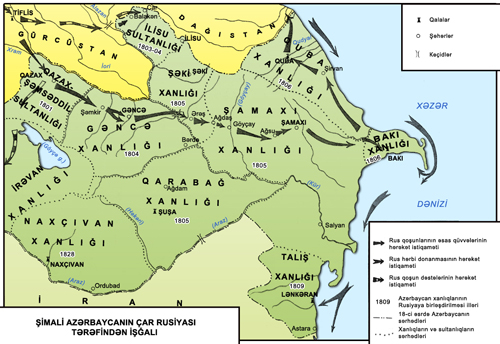
General Pashkevich even gave specific instructions on where exactly they should be resettled. In March 1828, the Iravan and Nakhichevan khanates of Azerbaijan were liquidated, and the so-called “Armenian region” was created on their territory for the resettled Armenians. Thus, the foundation was laid for the future Armenian state on the lands of Azerbaijan.
In addition, in 1836, Tsarist Russia liquidated the independent Albanian Church and subordinated it to the Gregorian Church. Thus, favorable conditions were created for the Gregorianization and Armenianization of the ancient Azerbaijani Christian-Albanian population. The foundation was laid for new territorial claims of Armenians to Azerbaijanis. Not satisfied with this, tsarist Russia resorted to an even more vile policy: it raised the Armenians armed by it against the Turkic-Muslim population and provoked a mass slaughter of Azerbaijanis. The period of genocide of the Azerbaijani people and the entire Turkic-Muslim population of the South Caucasus began.
The liberation struggle in Northern Azerbaijan ended in unprecedented tragedies. Here, the Dashnak-Bolshevik government of S. Shaumyan, which seized power in Baku and its environs, committed a terrible genocide against the Azerbaijani people in March 1918. Fraternal Turkey extended a helping hand to Azerbaijan. The liberation movement was victorious. On May 28, 1918, the first democratic republic in the East, the Azerbaijan Democratic Republic, was established in Northern Azerbaijan.
The Azerbaijan Democratic Republic, which was the first parliamentary republic in the history of the Azerbaijani people, was at the same time an example of a democratic, legal and secular state in the entire East, including the Turkic-Islamic world.
During the period of the Azerbaijan Democratic Republic, the history of parliamentarism is divided into two periods: the first period lasted from May 27 to November 19, 1918. During these six months, the Azerbaijani parliament, which consisted of 44 representatives of Muslim Turks and functioned under the name of the National Council of Azerbaijan, made important historical decisions. The first parliament on May 28, 1918, proclaimed the independence of Azerbaijan, took over the government, and adopted the historic Declaration of Independence.
The second, or Baku period in the history of parliamentarism of the Azerbaijan Democratic Republic lasted from December 7, 1918, to April 27, 1920 – only 17 months.
The law on the establishment of the Baku State University, adopted by the parliament on September 1, 1919, should be specially noted. The opening of the national university was the most important historical merit of the leaders of the Republic to their native people. Although the Azerbaijan Democratic Republic subsequently fell, Baku State University played an irreplaceable role in preserving its ideas and in restoring independence.
During the existence of the Azerbaijan Democratic Republic, 155 parliamentary sessions were held, ten of which took place during the functioning of the National Council of Azerbaijan (May 27-November 19, 1918), and 145 – the Azerbaijani parliament (December 7, 1918 – April 27, 1920).
More than 270 bills were submitted to the parliament for discussion, about 230 of which were adopted. The laws were discussed in the midst of heated and business-like debates and were adopted only after the third reading.

Despite the fact that the Azerbaijan Democratic Republic existed for only 23 months, it proved that even the most brutal colonial and repressive regimes are not able to destroy the ideals of freedom and traditions of state independence of the Azerbaijani people.
As a result of the military aggression of Soviet Russia, the Azerbaijan Democratic Republic fell. An end was put to the independent statehood in Northern Azerbaijan. On April 28, 1920, the establishment of the Azerbaijan Soviet Socialist Republic (Azerbaijan SSR) on the territory of the Azerbaijan Democratic Republic was announced.
Immediately after the Soviet occupation, the process of destruction of the system of independent state administration, created during the existence of the Azerbaijan Democratic Republic, began.
The « Red Terror » reigned throughout the country. Anyone who could resist the strengthening of the Bolshevik regime immediately became a victim of the « Red Terror » under the name of an « enemy of the people », « counterrevolutionary » or « saboteur ».
Thus, after the March 1918 genocide, a new genocide against the Azerbaijani people actually began. The only difference was that this time the most famous representatives of the people were destroyed – outstanding figures of the Azerbaijan People’s Republic, generals and senior officers of the National Army, progressive intelligentsia, famous scientists. This time, the Bolshevik-Dashnak regime, in a pre-planned manner, destroyed only the cream of the people and sought to behead them. In fact, this genocide was much more merciless and terrible than the March one.
The convocation of the 1st Congress of Soviets of the Azerbaijan SSR on May 6, 1921, completed the Sovietization of Northern Azerbaijan. On May 19, the first Constitution of the Azerbaijan SSR was adopted.
After depriving the Azerbaijani people of their independent power, the plunder of their wealth began. Private ownership of land was abolished. All the natural resources of the country were nationalized, more precisely, they were considered state property. For the management of the oil industry, the Oil Committee of Azerbaijan was specially created, the leadership of which was entrusted to A.P. Serebrovsky, directed by V.I.Lenin. Thus, VI Lenin, who wrote in a telegram sent back on March 17, 1920, to the Military-Revolutionary Council of the Caucasian Front, “The capture of Baku is very, very important for us” and thereby gave an indication of the conquest of Northern Azerbaijan, achieved his goal. Baku oil passed into the hands of Soviet Russia.
In the 30s, brutal repressions were carried out throughout Azerbaijan. In 1937 alone, 29 thousand people were repressed. During this period, Azerbaijan lost dozens of such thinkers, rare representatives of the intelligentsia, such as Huseyn Javid, Mikail Mushvig, Ahmed Javad, Salman Mumtaz, Ali Nazmi, Tagi Shahbazi, and others. The mental potential of the people and its worthy representatives were destroyed. After this terrible blow, the Azerbaijani people could not recover for decades.
In 1948-1953, a new stage of mass deportation of Azerbaijanis from Western Azerbaijan (from the territory called the Armenian SSR), which was their original homeland, began. Armenians have strengthened even more in the lands of Western Azerbaijan. Their quantitative superiority in this territory was ensured.
Despite the important successes achieved thanks to the creative genius of the Azerbaijani people, due to a number of objective and subjective reasons, negative tendencies began to appear in many sectors of the Azerbaijani economy – both in industry and agriculture – in the 1960s.
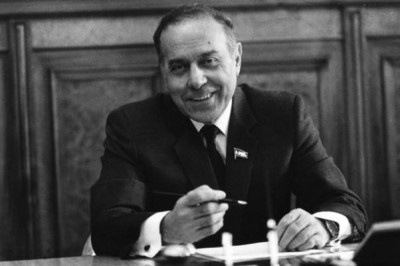
In this difficult situation in which the republic found itself, an important change took place in the Azerbaijani leadership. In 1969, Heydar Aliyev’s first period of leadership in Azerbaijan began. In a difficult historical situation of the domination of the totalitarian regime, Heydar Aliyev, with the aim of turning Azerbaijan into one of the most advanced republics of the Soviet Union, embarked on a program of broad reforms in all spheres of life.
The great politician first sought the adoption at the level of the Politburo of the Central Committee of the Communist Party of the Soviet Union, at plenums of the Central Committee, congresses of the Communist Party of favorable decisions on important issues for his homeland and people in various sectors of the economy (including agriculture) and culture, and then mobilized our entire people to implement these decisions, day and night he fought tirelessly for the prosperity of his native Azerbaijan. At the head of his plans was the transformation of Azerbaijan into a self-sufficient and highly developed country in terms of science and technology (in the terminology of that time, into an administrative and economic unit). In short, Heydar Aliyev started the path leading to the independence of our Motherland back then.
In 1970-1985, in a short historical period, hundreds of factories, factories, and industries were created throughout the republic. 213 industrial establishments were launched. Azerbaijan occupied one of the leading places in the Soviet Union in many industries. 350 types of products manufactured in Azerbaijan were exported to 65 countries of the world.
The tremendous historical significance of all these magnificent creative works carried out during the first period of Heydar Aliyev’s leadership in Azerbaijan was that national pride, national self-awareness were awakened in our people, feelings of freedom and independence were raised. In essence, this meant the entry of the Azerbaijani people in the 70s of the XX century into a new stage – the stage of national upsurge.
The last stage in the history of the Azerbaijani statehood, which began during the collapse of the USSR with the adoption of the Constitutional Act on the State Independence of the Republic of Azerbaijan on October 18, 1991 after the collapse of the USSR, continues to this day successfully.
Throughout their entire history, the Azerbaijani states went through periods of rising and fall, were subjected to internal disintegration and external occupation. Azerbaijan has always maintained peaceful and calm relations with its neighbors. However, the Armenians who settled in Western Azerbaijan constantly encroached on the Azerbaijani lands, took advantage of the situation to seize new territories.

Since 1988, the Armenian armed forces have implemented a plan to evict Azerbaijanis living in 126 settlements of Nagorno-Karabakh, which was an integral part of Azerbaijan. On May 8, 1992, the Armenians captured Shusha, and on October 2, 1992 – Khojavend.
It was during this period, on the night of February 25-26, 1992, that the most tragic event of the 20th century took place – the Armenian armed forces, together with the soldiers of the 366th motorized rifle regiment of the former Soviet army, completely destroyed the city of Khojaly, in which 6,000 Azerbaijanis lived.
Thus, since 1988, as a result of the military aggression of the Armenian armed formations, 20% of Azerbaijani lands are the territory of Nagorno-Karabakh and 7 adjacent regions (Lachin – May 18, 1992, Kelbajar – April 2, 1993, Aghdam – July 23, 1993, Jebrail – August 23, 1993, Fizuli – August 23, 1993, Gubadli – August 31, 1993, Zangilan – October 29, 1993) was occupied, 700 thousand Azerbaijanis were forced to leave their homes and temporarily resettled mainly in more than 1600 objects in 62 cities and districts.
In the conditions of the strengthening of the popular movement in March 1992, A. Mutalibov, who led the republic, resigned. The created void in power has further weakened the defense capability of the Republic of Azerbaijan.

As a result, in May 1992, the Armenian military associations also captured Shusha. Thus, the Armenians actually occupied the territory of the entire Nagorno-Karabakh. The next step was the occupation of Lachin, the region connecting Armenia with Nagorno-Karabakh. The struggle for power, which continued during the rule of the Popular Front of Azerbaijan, dealt a heavy blow to the defense of the republic. In April 1993, Kelbajar was occupied. In June, a deep political crisis was evident in Azerbaijan. At the demand of the people, Heydar Aliyev came to power.
With the return of Heydar Aliyev to power, a turning point in the fate of our country took place, the flaring up civil war was averted. This day went down in the history of the Azerbaijani people as the « Day of National Salvation ».
On May 12, 1994, a ceasefire agreement was signed between Azerbaijan and Armenia. However, despite this, the Armenian armed formations often violated it, subjecting the civilian population to shelling.
On the night of April 2, 2016, the military conflict that unfolded between the Armed Forces of Azerbaijan and Armenia became the largest confrontation on the contact line since the armistice was signed.
The April battles ended with the victory of the Armed Forces of Azerbaijan, the heights around the village of Talish were liberated, as well as the Seisulan point of the Terter region, the Lele-Tepe height and the Chojuk village of Marjanly, the Jebrail region, the Gulistan village of the Goranboy region and the roads in the direction of the Madagiz village of the Terter region.
The violation of the state border in the direction of the Tovuz region in July 2020, the settlement of Lebanese Armenians in the territories we occupied showed that there was no point in conducting peace negotiations. The sabotage that Armenia wanted to commit in August in the Goranboy direction and the creation of volunteer military formations made a new war absolutely necessary.

A new history was written for Azerbaijan as a result of the counter-offensive of the Azerbaijani army, which began on September 27, 2020, with the provocations of the Armenian armed forces against Azerbaijan.
After another provocation of the Armenian armed forces on the line of contact, in accordance with the warning of President Ilham Aliyev, Azerbaijan began military punishment of the enemy. During the ongoing rapid counteroffensive, a number of strategic heights were liberated from occupation, the settlement of Sugovushan and the village of Talysh in the Terter region of the Jebrail region, the village of Hadrut in the Fizuli region, the Zangilan region, the Gubadli region and, finally, the city of Shusha.
The 44-day war led to the complete victory of Azerbaijan and the surrender of Armenia. During this period, about 300 villages, 5 cities, 4 settlements, numerous strategic heights were liberated. The enemy’s equipment was completely destroyed, and his manpower was seriously damaged. The Patriotic War, which lasted only 44 days, led not only to the liberation of our territories but also to the end of the occupation, as well as the settlement of the conflict, which lasted almost 30 years.

The objective of archaeology is to study ancient peoples’ appearance, their development and formation. Archaeology attempts to familiarize modern humans with the ancient past of humankind through the material finds of cultural remnants.
Comprehensive evidence of a material culture that is related to the time of the first inhabitants was found during archaeological excavations in the territory of Azerbaijan. As a result, Azerbaijan was included in the list of countries which hosted the first sites of ancient people. The most ancient artefacts related to the appearance of the first primitive people in Azerbaijan from 1.7-1,8 million years ago have recently been found in the country.
Within the last fifty years the complex research, conducted in Azerbaijan, discovered the patterns of material culture and comprehensive scientific materials for the exploration of the history of the appearance, formation and evolution of ancient people. On the basis of discovered scientific materials the distant past, the initial stages of evolution of the first people and the characteristic features of the patterns of the material culture of our ancestors are being studied and explored.
Scientific research conducted by Azerbaijani and German scientists proved that primitive people appeared on the territory of Azerbaijan 2 million years ago. Yet in the period before 1950, the notion of the settlement of ancient people in Azerbaijan had been rejected. Yet in recent years the archaeological research conducted by Azeri archaeologists proved the groundlessness of such statements and the existence and formation of ancient people on the territory of the country by means of scientific materials. At the same time, the civilization was of a specific kind on the territory of Azerbaijan.
The comprehensive research conducted on the territory of Karabakh registered extensive camps of the Paleolithic era and carried out further scientific exploration.
The scientific research conducted pointed out that it took thousands of years for the ancient inhabitants of Azerbaijan to create implements and to develop them further. Research shows that primitive people mainly settled in the natural caverns, on riverbanks, in caves and other places with favourable conditions.
Rich archaeological camps of different stages of the Stone Age were discovered on the territory of Karabakh during exploration work that was conducted in connection with the Paleolithic era in Azerbaijan. The archaeological survey conducted by the archaeological expedition of the Institute of History under the National Academy of Sciences under the leadership of M.M.Guseynov in the Guruchay and Kondelenchay river valleys discovered cave-dwelling camps at Azykh and Taghlar in May of 1960.
It was discovered that karst caves were typical of the mountainous regions of Karabakh. However, the most comprehensive patterns of material culture were registered only in the Azykh and Taghlar caves in the region.
Multi-layer Azykh Paleolithic camps located in one of the most picturesque places on the left bank of the river Guruchay, at a height of 900 above sea level 16 kilometres were found in Fuzuli on the Tugh lowland.
As a result of scientific research that was held in Azerbaijan, it was not only proven that primitive people lived in Azerbaijan, but also that Azerbaijan is one of the places with the most ancient of civilizations and that primitive people settled and lived here for a long time. Therefore, the complex scientific research that was conducted in Karabakh had rather important scientific relevance.
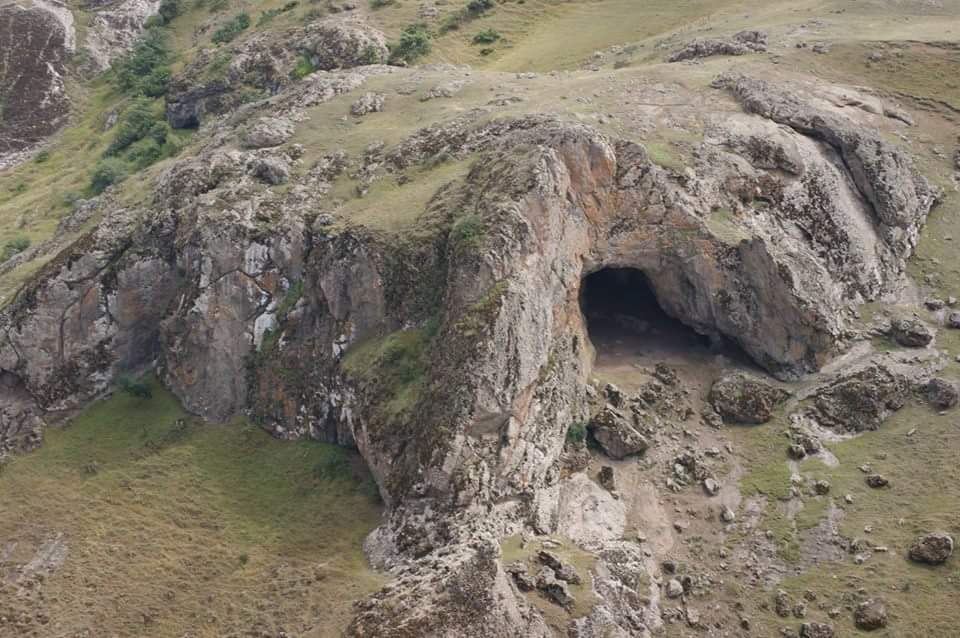
Comprehensive archaeological materials on patterns of the material culture of Olduvay, Ahsel, Mustye, Orinyak, Solyutre, Madlen, Azil, Mezolit, Neolit, Kur-Araz and dyed dishes found in Araz Quruchay, Arpachay, Terterchay, Vileshchay, Zuvandchay and other valleys were also discovered by way of archaeological research.
The patterns of material culture that were found in the ancient dwelling places in Azerbaijan informs us about the cave life of primitive people, the production of implements, hunting, the first acquaintance with fire, primitive dwellings, rock carvings and the ancient history of Garabagh. At the same time, the material sources further teach us about ancient history and the stages of the formation and settlement of primitive people and the first inhabitants in this area.
Complex scientific research conducted in the dwelling places of the first inhabitants of Azerbaijan proved the existence of primitive people in Azerbaijan. The long formation and settlement of ancient people were proven through scientific evidence.
The Paleolithic archaeological expedition of the Institute of History under the Academy of Sciences of Azerbaijan led by Mamedali Guseynov conducted complex archaeological digs in the Azykh Paleolithic cave in June of 1960-1986. During this work, 10 archaeological layers were found and studied in the sediments of the camp.
- The first and second layers contained remnants of the material culture of the Bronze Age and neolith;
- The third layer revealed the patterns of material culture related to the culture of musty;
- No archaeological materials were found in the fourth layer;
- Materials related to the Middle Acheulian period were found in the fifth layer;
- The sixth layer revealed materials of the Old Acheulian Age;
- The 7th-10th layers discovered materials of the culture of Guruchay.

Ancient artifacts found in deep layers of the earth are of great scientific importance as they inform us about the first settlements of ancient people who lived in caves. Guruchay valley played a great role in the life of ancient Azykh dwellers.
The inhabitants of the Azykh cave collected river stones from the Guruchay river and brought them to the cave for creating tools. At the same time, the dwellers of ancient Azykh were engaged in hunting and gathering. During complex scientific research it was discovered that in the Paleolithic Age, Guruchay had favorable conditions for primitive people to live in. The patterns of material culture found during archaeological research in the seventh-tenth level of layers promoted the discovery of a rather new archaeological culture. Therefore, considering the specific features of technology and typology of the preparation of labor instruments in the 7-10th layers, the newly discovered patterns of material culture were entitled the archaeological culture of Guruchay.
During the scientific study of stone products from lower layers of earth, the number of development stages was determined in the culture of Guruchay. The working implements of the initial stage of archaeological culture were crude and primitive, while later the technique of their production improved and a number of new instruments were produced at that time.
Most of the artifacts that were found in the 7-10th layers of Azykh cave were produced outside of the dwelling place and were then brought to the cave as finished. That means that the ancient inhabitants of the Azykh cave had lived in the Guruchay valley before moving to the cave. They produced artIfacts in the Guruchay valley at that very period. Therefore, the production wastes from making the implements were not found in the cave.
During the scientific research conducted by Azerbaijani scientists, it was discovered that the artifacts of the Guruchay culture that were found in the 7-10th layers of the ancient cave Azykh had much in common with Orduvay culture and Dmanisi Paleolithic camps’ archaeological materials of East Africa.
It was proven that after the long development stage of the archaeological culture of Guruchay it was replaced by ancient Acheulian culture in the Azykh camp of ancient dwellers. Along with the discovery of the Acheulian materials of layer 4, the new culture of stone implements from the river was developed on the basis of the archaeological culture of Guruchay.

The ancient culture of the Azykh camp was characterized by manual choppers, crude implements, and disk-shaped nuclear. Over 2,000 stone products and thousands of hunted animals’ bones were found during the archaeological digs of the Acheulian layer (fourth layer). Production wastes, nuclear and river stones made up the remaining part of the stone tools. Artifacts found in the layer related to the ancient Acheulian culture included crude cutting tools, manual choppers, and horse-comb-like instruments.
The remnants of stone working were discovered along with implements showing that the ancient inhabitants of Azykh created implements in their dwelling places.
The rich patterns of fauna were discovered in the fourth layer of the Azykh camp along with the stone artifacts. Different jaw and skull bones dominated the fauna remnants. It was established that ancient people mostly hunted cave bears and giant deer.
The richness of the material culture remainders found in the ancient Acheulian layer testified that primitive people resided for a long time in the Azykh cave during the Auchelian period. The fact showed that the culture of the ancient Acheulian period was replaced with the Middle Acheulian culture. Only labor instruments favorable for hunting were found in the fifth layer of the cave.
The fauna remainders found in the Middle Acheulian period layer showed that hunting reached its peak at that time. During the ancient Acheulian period, primitive people hunted 11 species of animals while in the Middle Acheulian period this figure reached 45 species of animals and birds. The number of bones found in the fifth layer exceeded 200 thousand.
Along with the labor instruments a human chew was also found during the archaeological digs conducted in the fifth layer of the Azykh camp. The human chews found in the Azhykh dwelling of ancient people, on one hand, resembled Pithecanthropus especially that of Mauer man, and on the other hand, the pre-Neanderthal man found in the Paleolithic camp of Kondel-arago in France.
During the researches, scientists discovered that the chew found in the Caucasus and the Near East was one of the most ancient human beings and belonged to the 18-22-year-old woman, and this human being resided in the territory of Europe 350-400 thousand years ago.
The archaeological digs conducted in the third layer of the Azykh Paleolithic camp discovered over 3 thousand stonewares and 100 thousand fauna remnants. Sharp-pointed and horse-comb instruments of mustye culture dominated the stonewares of the Azykh camp.
The bones found in the campus mainly contained those of the wild horse, primitive goat, wild young horse, Caucasus goat, boar, cave bear, rhinoceros, and other animals. Most of the bones found were burnt on the fire.
Such scientists as M.M.Guseynov, D.V.Hadjiyev, A.V.Mamedov, A.G.Djafarov, N.S.Shirinov, V.V.Velichko, V.M.Hadjiyev, S.D.Aliyev, M.B.Suleymanov were engaged in the complex exploration of the Azykh campus.
The international scientific community highly appreciates the scientific researches undertaken in the Azykh Paleolithic campus by Azerbaijani experts. The scientists of France, Italy, Germany, Russia, Spain, Georgia, and other countries came to Baku within the last 40 years and familiarized themselves with the remainders of the material culture found in Azykh cave.
The study of material culture patterns found in the Paleolithic campuses on the territory of Azerbaijan was conducted on the international level. The scientists of France, Italy, Spain, Russia, Azerbaijan, Georgia and Holland taking that as a basis prepared the international INTAS-2000 program and started its implementation. Over 10 monographs and 200 scientific articles of Azeri scientists devoted to the scientific analysis of material culture patterns found in the Azykh Paleolithic cave were published within the last forty years.
Yet despite all these facts, a number of Armenian scientists try to falsify even the history of Azykh campus.
Sh. Mykyrtychyan wrote in his book « The architectural and historical monuments of Nagorny Karabakh » issued in Yerevan in 1988 that the monument of an Armenian woman was found in Azykh campus and its clothes resembled that of modern Armenian women.

Sh. Mykyrtychyan, by saying such ridiculous words seeks the history of Armenia in the Acheulian period. Yet there were not any monument that resembled the figure of a woman. A naturally created stalagmite column was found there. This column was formed from a mixture of limewater 2 million years ago.
Armenian press published information entitled « Digs continue in Azykh cave of Nagorny Karabakh » in August of 2003. That very information contained completely false, absurd thoughts that were far from science. The information stated that the digs were conducted by paleontologists. Yet only archaeologists carried out the digs there, while paleontologists studied only animal bones found during the digs. The information also stated that the chew found by M.Guseynov on the campus is 50-100 thousand tears pls. That is also an absurdity.
Azeri scientists proved that the chew was 350-400 thousand years old through the introduction of scientific facts and this figure was approved at the international scientific conference.
It is known to everyone that Azeri scientists conducted complex archaeological operations in the Paleolithic campus of Azykh and their results were highly appreciated by the prominent scientists of the international community.
During the long-term archaeological digs in Azykh campus, Azeri scientists studied 80% of the cultural layers of the cave. Therefore, both digging and exploration work in this area must be regarded as the gravest crime against humanity. Perhaps in 100 years, a new exploration method will emerge and the remnants of Azykh cave may be taken and used as a pattern. On the other hand, hundreds of thousands of material culture patterns found during archaeological digs in Azykh are kept in Baku and every scientist is able to familiarize with them.
To date, Taghlar cave is considered the richest archaeological monument of the musty culture in the Near East, the Caucasus, and Azerbaijan. The campus locates in the Tugh lowland, on the left bank of the Guruchay river in Garabagh.
The archaeological digs conducted by M.Guseynov and A.Djafarov in the Taghlar mustye campus revealed over 10 thousand stonewares and 100 thousand hunted animals.
The Taghlar cave is the only cave in the Near East and the Caucasus that enables to study and explore the features of new labor instruments formation and their long-lasting development. At the same time, the archaeological researches conducted in Taghlar campus reveals the specific properties of the mustye culture of our country.
The complex archaeological researches proved that Garabagh is the historic land of Azerbaijan through scientific facts.
The resolution of urgent problems of our democratic country makes it important to identify ourselves by shedding light on some of the dark pages of our history and to bring up a new generation of young intellectuals. Despite the past obstacles, we have managed to reveal the valuable pages of our history and to introduce them to the people. Each representative of our nation is full of pride when they study its historical past and cultural heritage.
Heydar Aliyev
The people of Azerbaijan, who gained their independence at the end of the 20th century, have a rich and ancient history.
Bordering the Major Caucasus in the north, the Alagoz Mountains and East Anadolu, including the Goycha Lake in the west, the Caspian Sea in the east and the borders of Sultaniyye-Zendjan-Hamedan in the south, the historical lands of Azerbaijan are some of the most ancient cultural sites of modern civilization. Azerbaijani people, the second-largest Turkic nation after the Anadolu Turks, have maintained a rich culture and traditions in their lands.
We’ve inherited a great culture. Each citizen of Azerbaijan must try to deserve this heritage and feel the responsibility for the past, present and future of our country, which has a great historical past, the rich culture and high moral traditions.
Heydar Aliyev
The historical lands of Azerbaijan are located in the region of the Caspian-Mediterranean Sea-Iranian plateau, where most ancient civilizations emerged and developed.

Ancient ethnic societies, the predecessors of the Azeri nation, made a great contribution to the formation of ancient cultural civilizations, established in the region, including the Shumer-Babil culture and to political and military life as well as the history of ancient state establishments of the Near and Middle East. This fact has been proven by scientific research, and especially by way of archaeological excavations that have been conducted in our country and other surrounding states.
The territory of Azerbaijan is rich with archaeological monuments testifying to the fact that our country is one of the most ancient cradles of civilization. Archaeological finds, discovered in the Azykh, Taghlar, Damdjylly, Dashsalahly, and Gazma (Nakhichevan) caves and other historical sites, including the lower jaw of the Ashol man — Azykhantrop, who lived 300-400,000 years ago, also prove Azerbaijan to be one of the sites of the formation of ancient human beings.
Due to this finding, the territory of Azerbaijan has been included on the map of the most ancient inhabitants of Europe.
The population of Azerbaijan, one of the most ancient cradles of humanity, created a high culture since the Paleolithic Age. In the periods of Mesolithic and Neolithic, the population of Azerbaijan led a sedentary lifestyle and engaged in farming, cattle-breeding and other handicrafts. The cultural and economic progress of Azerbaijan expanded even at that time long ago. The Kur-Araz civilization, formed in the late 4th millennium -3rd millennium BCE, spread to other regions of the South Caucasus, East Anatolia and North Caucasus.
Rich material patterns of culture, especially of grain, cropping tools and housing instruments, as well as various kinds of handicraft products, show that the Azerbaijani people created one of the ancient sedentary civilizations.
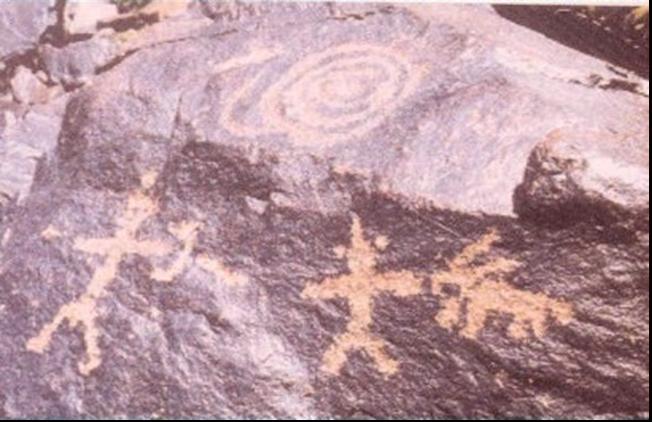
At the same time, the people of Azerbaijan have the most ancient traditions of state system establishment. Its historical age is nearly 5 million years. The first state establishments or ethnic-political units appeared in the Urmia Lake basin in the late 4th-early 3rd millennium BCE. The most ancient states established in that area played a significant role in the military and political life of the whole region. Ancient Shumer, Akkard and Ashshur states, established in Dejle and Ferat valleys and even the Hittite state in Minor Asia had close contact with each other at that time.
The most ancient states of Azerbaijan were following active foreign policies and successfully defended their lands from foreign invaders. One of the ancient tribes of Azerbaijan – Guti even defeated their strong neighbor-Akkard state and expanded their borders to the Iranian plateau and ruled these areas for nearly one hundred years. Along with making use of the state organization rules of Akkards and Shumers, whom they subdued, they also spread the advanced state organization culture of ancient Azerbaijan to these countries.
Ancient state organizations of Azerbaijan Lullubi and Kuti, that ruled the territories beginning with the Urmiya lake sometimes covering Dejle and Ferat valleys till Iran plateau played an important role in the history of the ancient state organization of the East.
Unlike other ancient eastern countries, kuties elected their leaders and the power was not hereditary. Kuti leaders ruled the country through their successors. Successors were free in the governing. Evidently, all these factors contributed to the long-ruling of ancient states of Azerbaijan on the areas covering Dejle and Ferat valleys till Iran plateau.
With time passed, the culture of state organization became more highly developed and new improved and larger states were established.
Late 1 Millenium B.C.- early 1 Millenium A.C. Azerbaijan was notable for the establishment of such strongly organized states like Manna, Skif, Atropatena and Albania. These states played a great role in the development of the state organization of Azerbaijan, the economic and cultural history of the country and in the formation of a single nation.
Manna which established in the early 1st millennium B.C. and followed the traditional state organization of Azerbaijan was an important stage in the history of the state organization of Azerbaijan. The state, which appeared in the Urmia basin-the site of ancient states, occupied a significant place in the history of the world state organizations not only for its antiquity but for the high level of development.
Manna, which annexed other small local states in the Urmiya basin expanded from the Araz river on the north (and even far to the north of it) till the Caspian Sea on the north-east.
Manna took an active part in all the events in the region and led successful fights with its strong neighbours Ashshur and Uratly, attempting to occupy Azeri lands. Skifs and Kimmers, residing in Azerbaijan at that time also took an active part in the struggle against Ashshur and Urat occupants.
The power of the leaders of Manna was absolute and hereditary. Yet despite that, the leaders ruled the country under the support of the council of the elders and that proves that Azerbaijan has ancient traditions of ruling through consultations.
Manna that existed for nearly 300 years on the south of our lands and led to the repeated attacks of strong neighbours is an important historical factor proving that our country had strong traditions of state organization since ancient times.
Kimmers and Skits as well as Saks and massagets, which were of the same community as the skits started to play an important role in the military and political life of Azerbaijan late 8th century-early 7th century B.C. These tribes which were the most ancient inhabitants of Eurasia flowed to the south from the passes of the Caucasus mountains and Derbent and after consolidating on the southern foothills of the Major Caucasus in North Azerbaijan and spread to the south to the area of Manna and the east of Anadolu.
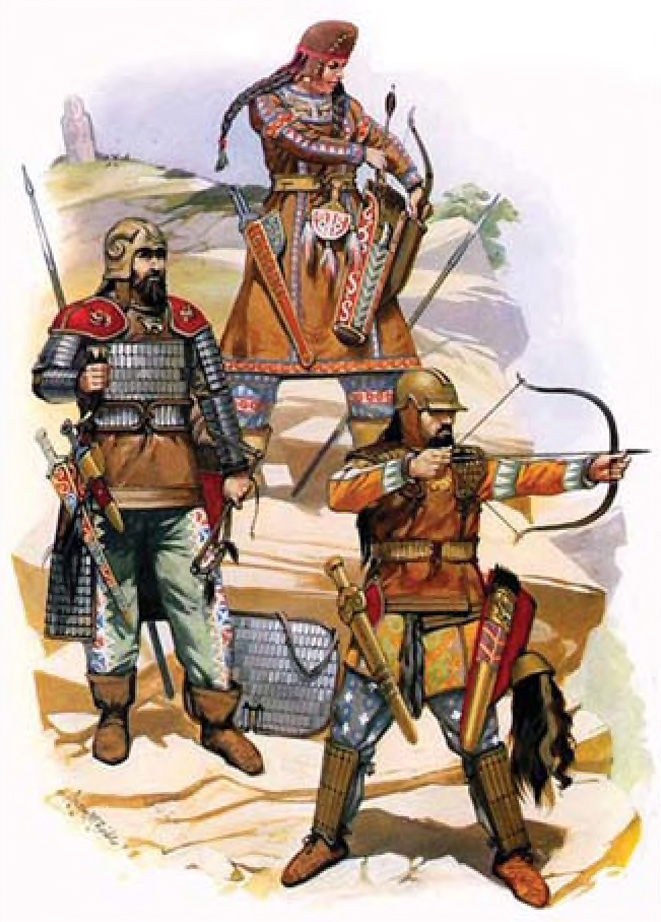
Along with other tribes, the communities of Georgian Turks also existed within the Kimmer-Skith-Sak communities. The records of the forefather of history Herodot (5th century B.C), based on his own observations also prove that. He wrote that skiths fed on horse milk; their kindred massagets dressed in a similar way and led a similar lifestyle. They worshipped the God of the Sun and sacrificed the horse- the quickest animal on the Earth to the God of the Sun moving fastest in the Sky.
The Skits established the strong Skythian state and contributed to the formation of a single nation on the territory of the country. The Skithian-Massaget leaders gained success in the defence of the lands of Azerbaijan from foreign invaders.
The Massaget state inflicted a hard defeat on the strongest empire of that period-the empire of Iran-Ahameni. Ahameni ruler Kir the Second, which invaded large territories in the Near and Middle East, after occupying south lands of Azerbaijan made an attempt to annex the north part of our country and for this purpose, he made a proposal to the widow of a Massaget ruler Tomiris. However, aware of the mean plans of Kir and attaching great importance to the fame of the country and its independence, Tomiris declined his proposal and swearing to the God of the Sun rushed into the fight and smashed down much stronger troops in 530 B.C. Unconquerable Kir himself was killed in this battle. The victory over Kir the Second, that turned such strong states as Media Empire, Lidia, Babilistan into ruins, occupied large areas from Central Asia to the boundaries of Egypt including Parfiya and thus attached the name Kir the Great, was one of the most joyous events in the History of Azerbaijan.
In the period of the Skithian state favourable conditions were created for the interaction between Azeri culture and the culture of skyths widely spread in Eurasia. The ancient culture of Azerbaijan started to develop rapidly and became even richer. Material patterns of culture, discovered during archaeological digs and names of places that had survived since the Skithian-Sak-Massagets times clearly prove this fact.
Despite the development of complicated political and military events and the occupation policy of neighbour countries that attached great military and strategic importance to Azeri lands, rich in natural resources our country still developed their traditions of state organizations and even entriched them. Thus, neither the long-term occupation regime of the Ahameni-Iran empire nor the invasions of Macedonian Alexander could destroy the culture of the state organization in ancient Azerbaijan.
The state organization of Azerbaijan restored immediately after the death of Macedonian Alexander. The state of Atropatena appeared in the south of our country while Albania emerged in the north. All the historical lands of Azerbaijan were included in these two local states.
The state of Atropatena covered the south part of the country. In fact, the state organization of Azerbaijan restored even before the invasions of Alexander. The southern lands of Azerbaijan forming a separate satrapate along with other lands of collapsed Midia Empire were ruled independently by Ahameni Atropat even in times of Ahameni government. This part of Azerbaijan was called Midia-Atropatena, Midia Minor and Midia of Atropat by name of Atropat and sometimes Atropatia or Atropatena at that time.
Far-seeing politician and famous military leader Atropat the Third led a major attacking force of Ahameni put forward against Alexander. These forces were mainly composed of military groups concentrated on the north and south of Azerbaijan. After the defeat by Atropat, the Third Alexander acquainted with the commanding talent of Atropat abandoned the idea of facing him and tried to approach the Azeri leader. Thus, the invasions of Macedonian Alexander bypassed Azerbaijan. Later Atropat even deepening rapprochement with the Macedonian ruler, married one of his close relatives thus transforming Atropatena into the first state independent of Greece Macedonia for the first time in the entire East.
Restoration of independent state traditions in Azerbaijan promoted big progress in all spheres of economic and cultural life in the southern regions of the country. The strong state Atropatena played a great role in the international contacts of the whole region and maintained wide trade relations with the Caucasus, Volga region, Central Asia, India, Asia Minor, Mesopotamia, the basins of the Black Sea and the Mediterranean Sea. The country’s own currency dominated the inner market.
The interaction between Eastern and Greek state organizations also had a positive impact on the state organization of Atropatena. That caused the widespread of the Greek language in the country and the improvement of legal standards along with other fields. The rules of the state organization even perfected at that time.
The rulers of Atropatena, making a profit from the traditions of state organization existing in Greece and Ancient East as well as Azerbaijan managed to consolidate their government. Due to that Atropatena preserved its independence in the fight with Parfia and Selevki states and uniting with Pafians smashed down the Roman troops that entered the country. At that time the troops of Atropatena were thought the strongest forces of the entire region. Atropatena advanced 40 thousand infantrymen and 10 thousand cavalries in the battle with Roman invaders.
Wide relations were established between Atropatena, which was a strong military and political force in the Near and Middle East and the Roman Empire. Roman Empire attached great importance to Atropatena as part of its eastern policy. The envoys of Atropatena visited Rome and hold talks with ancient emperor Octavian August (27 B.C.-14 A.C.) The Roman Emperor entrusted the rulers of Atropatena to govern the neighbour Armenian kingdom. Armenian tsars beware of their military and political power of Atropatena tried to sever ties with this country. For this purpose, Armenian Tsar Tigran married off his daughter to Atropatena ruler Mitridat. Later Armenian kingdom became dependent of Atropatena and was governed by Atropatena rulers.
Albania that appeared on the north of the country covered territories from the Caucasus mountains including the south of Derbent (Derbend with adjacent regions) to the River River Araz on the south, from the Goycha lake basin and upper Qabyrry (Iori) and Qanykh (Alazan) to the north-the lands of Azerbaijan on the Caspian Seashore. Gabala and later Barda (after the fifth century) were the centres of this mighty state.
The material and moral culture of Northern Azeri lands even strengthened in times of Albania. Azeri alphabet then called Albanian emerged and schools opened during that period. The country accounted for over 30 cities-the important commercial and cultural centres.
Albania which located at the junction of the North and South and East and West and the site of interaction of different, ethnic societies religions and cultures continued to develop specific and rich culture.
Turkic ethnic communities, residing in the country and increasing in the number played a great role in the life of the country. Christianity was spreading in the country along with worshipping of the Moon, the Sun, the only God-Allah. Independent Albanian church directly reported to Rome from the religious point of view.
The traditions of the state organization in Azerbaijan improved in the times of Albania. Albanian rulers were the worldly and religious leaders of the country. They, simultaneously, made laws and were the commanders of the country’s military troops. The number of military troops exceeded 80 thousand people (60 thousand infantrymen and 22 thousand cavalry).
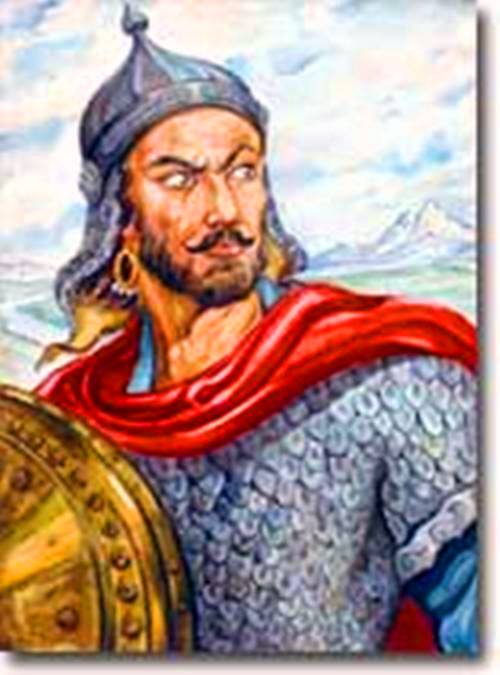
A discussion council operated in the palace of Albanian rulers. Albanian leaders themselves controlled the council and religious meetings. Like Atropatena, Albania also had its state currency. Albania which had quite a strong and perfect state organization in its time successfully fought the Parfia and the Roman Empire which threatened the independence of the country. The troops of the Roman Empire trying to occupy the country had been inflicted hard defeats by Albanian fighters more than once. The Roman Empire had to abide by the military and political power of Albania and mutual relations were established between the two countries. Albanian envoys also visited Rome and met with Emperor Oktavian August.
The country maintained wide trade relations and political contacts with other countries as well.
Albanian ruler, prominent state official Djavanshir led wise, far-seeing and active foreign policy against such strong neighbours as Byzantium, Sasanies, Khalifate and Caspian Empires that attempted to occupy the country, and managed to preserve the independence of the country owing to his leadership talent and brave heroism.
The heroism of such military leaders as Djavanshir and Babek has become a school of patriotism and embodiment of the unity of the nation and integrity of Motherland.
Heydar Aliyev
Albania which interacted with regional countries and had a power of military-political and cultural influence also maintained wide contacts with the Mediterranean countries including the Roman Empire. The first sources, including patterns of rich material culture, found during archaeological digs prove the development of wider contacts between the north part of Azerbaijan and foreign countries in times of Albania. International ways of communicating the Near East with the Caspian khagans and Eastern Europe and passing via Albania positively influenced the foreign trade contracts of the country as well.
Within the first years, A.C. our country survived the hardest period of its history: in the third century it was occupied by the Sasani-Iranian Empire, in the seventh century by the Arabian caliphate.
Newcomers settled on the most fertile lands and strategically important regions. They were granted wide privileges. The strangers initiated the policy of terminating the local residents of Azerbaijan. However, the Iranian and Arabic tyranny, lasting for 600 years could not destroy ancient traditions of state organization in Azerbaijan. The process of formation of the Azeri nation continued even in conditions of constant unbearable invasions and persecution.

Despite the invaders’ attempt to assimilate the local population, the internal relations especially commercial ones developed between all regions of the country due to the fact that entire Azerbaijan had been part of the said empire within a long period of its history. Significant progress was achieved in the establishment of ethnic-political and cultural unification of north and south, east and west regions of Azerbaijan. The process of establishment of a single nation intensified at that time.
The ethnic community of Turks dominating the local population in the first hundred years A.C. and were much stronger and organized from the military and political point of view played a great role in the formation of a single nation. Oghuz Turks prevailed over other tribes within the community.
Like other Turkic tribes, the first oghuzs also came and settled in the South Caucasus, including Azeri lands by the pass of Derbend once Turkic « Iron Gate » and by other mountain passes of the Major Caucasus (one of the mountain passes of Gakh district of Azerbaijan is still called Hun-Y.M.). The first information on Dede Gorgut’s grave locating in in Derbend and the name Bayat connected with the name of the land of Bayat’s (Oghuz tribes bayat) related to Dede Gorgut and attached to one of the tower gates prove this fact.
Ancient Turks and Oghuz settling on the wide areas of Eurasia tried to take control over this important pass « Iron Gates » communicating the north and south part of the land i.e. the Gypchag plain with the South Caucasus.
This is proved by facts placed in the oghuzname called « Kitabi-Diyarbekriyye », written by Abu Bekr al-Tehrani al-Isfahani by the order of the most prominent ruler of Oghuz Turks Aggoyunlus Uzun Hasan and the fact that Aggoyunclus and Garagoyunlus, giving birth to our nation, were among the most ancient inhabitants of the South Caucasus and Asia Minor. The said author thoroughly studying the origin of the great grandfather-the founder of Aggoyunlu state Gara Yuluk Osman finally came to the Oghuz khagan. He cited areas included in the great Turkic state, headed by Oghuz khagan and points out that this great ruler that had been the forefather of all Oghuz Turks died on the shore of the Goycha lake. The fact that Azeri lands had been part of the state ruled by Oghuz khagan and his death on the Goycha lakeshore proves the country to be one of the most ancient Oghuz-Turkic settlements.
The author of « Kitabi-Diyarbekriyye » wrote that Oghuz’s grandson Bayandyr khagan also lived « on the Karabakh winter camps and the pastures of the Goycha Sea, convened meetings there and divided the land between his sons depending on their talents and then died ». Abu Bekr al-Tehrani al-Isfahani confirmed that the twentieth grandfather of Aghgoyunlu Gara Yuluk Osman sungur bek had been the contemporary of the prophet Mohamed. He took part in the war with godless on the borders near the pastures of the Alagoz and Goycha lakes and was killed in one of the battles. Saktur khan, the fourteenth grandfather of Gara Yuluk Osman was brave in battles for Alindja tower and managed to snatch it out from the godless. Gypchag khan, which was the contemporary of Harun ar-Rashid, also held wars with the godless for the tower of Alindja and released it after defeating the enemy.
These facts, the historical reality, coinciding with the chapters of « Kitabi-Dede-Gorgud » and with the events, occurring in times of the prophet Mohamed and caliphate occupation proved Azerbaijan to preserve its traditions of strong state organization and independence.
Unlike other nations and ethnic groups, Turkic tribes settled and dominated both northern and southern parts of Azerbaijan. Therefore, the Turkic language turned to the principal means of communication of national minorities and ethnic groups residing on the territory of Azerbaijan. The Turkic language also performed a function of a bridge communicating the north and the south of the country. This factor played a great role in the formation of a single nation at that time. At the said period the population of Azerbaijan did not have a single religion, worshipping the single God. Ancient curls had not come to the worshipping of the single God. Such trends as Zardushtlug, fire-worship, belief in the Sun, the Moon, the Sky, the Stars, the Ground, Water and others still dominated that period. Christianity was mainly spread in the north — a number of regions in Albania, mainly in western mountainous regions. But, Albanian church operated in conditions of sharp differences with neighbour Armenian and Georgian churches.
Under such complicated conditions, Turkic tribes which turned to the strongest leading military and political power were the main carriers of traditions of the state organization of Azerbaijan. In a period when monotheism was not yet been established Turkic ethnic communities and Turkic language fulfilled the function of the bridge in the whole country. Turkic ethnic communities also played a leading role in the preservation of traditions of independence and state organization of Azerbaijan.
The adoption of Islam in the VII century led to a significant turning point in Azerbaijan’s historical fate.
Islam stimulated the formation of unit people and language, had a decisive influence on this process. Religion unity among Turkish and non-Turkish ethnic communities caused the formation of unit traditions, expansion of relationship ties, deepening of the integration process throughout Azerbaijan. Islam unified Turkish and non-Turkish ethnic communities, adopted it, under unit Turkish-Islam flag against Byzantium, attempting to include the Southern Caucasus into the influence sphere of Christianity, Armenian and Georgian feudal lords under Bizantium protection.
Nevertheless, the Christian population of Albania stayed beyond of influence sphere of Islam during the Arabic occupation, as converting to Islam of people of monotheistic worship contradicted the principles of Islam. Thus, religious parting appeared in the country: Turkish-Moslem population, presented majority and spread throughout the country, including Albanians, adopted Islam, and Christian population presented minority and lived mainly in the western regions of the Country, including Albanians. The struggle of Armenian and Georgian churches for including Christian Albanians in the sphere of their religious-political and ethnic influence became stronger since this period. Azerbaijan turned into a confrontation point between Islam and Christianity. In time Christian Albanians of Western Azerbaijan, including mountain territories of Karabakh, became subject of Armenianization and Gregorianization. Christian Albanians, who lived in the northwest of Azerbaijan, were the target of the Georgian church.
Thus, the claim period of Armenian and Georgian feudal lords against Azerbaijan began as a result of religious parting in Albania. The purpose of neighbors’ policy was as follows: to include Christian Albanians to influence the sphere of Armenian and Georgian churches, Armenianize and Gergionize them, and at last to appropriate Azerbaijan lands, where they lived.
Ancient statehood traditions of Azerbaijan revived after the collapse of the Caliphate since the middle of the IX century. New political reviving began in Azerbaijan: states like Sadjis, Shirvanshahs, Salaris, Ravvadis, Shaddadis appeared in Azerbaijan territories, where Islam was spread.
Shaki state appeared in the east-west of the country — in the Azerbaijan lands till Tiflis (present Tbilisi), the borderline city of Islam in the aforesaid period. There was another Moslem state with the capital Tiflis — Tiflis emirate in the west of Shaki as well. Shaki rulers had the title of Albanian ruler and were heirs of Albania state. The territory of Shaki state in contradiction to other Azerbaijan states became an acute confrontation point between Islam and Christianity. Islam was spread in the territory of this state along with Christianity and its influence sphere was expanding. Shaki rulers struggled against the occupation of Georgian feudal lords in difficult conditions and successfully defended the northern-western borders of the Azerbaijan land.
Resurrection in all spheres of political, economic, and cultural life took place as a result of the birth of independent states. The Renaissance of Azerbaijan history started.
The Turkish language turned into the main communication means throughout the country with the collapse of the Arabic Caliphate and reviving of Azerbaijan statehood. This was a historic achievement, able to have a great influence on the further development of Azerbaijan. Unification of Azerbaijan lands under unit Azerbaijan-Turkish Sadjis state during the historical period, prolonged for more than half-century since 870s (879-941), had a positive influence on deepening of economic and cultural relations, eliminating of ethnic differences and speeding up of Azerbaijan-Turkish people formation.
Sadjis state covered wide territories from Zandjan to Darband, the Caspian shores to cities Ani and Dabil at the peak of its powers. All Azerbaijan territories were included in Sadjis state. Defeating of Armenian and Georgian feudal lords, supported by Byzantium, and driving them into the dependent state by Sadjis plaid an important role in preserving Azerbaijan’s territorial integrity and strengthening ethnic-political unity in the country territory. The masterpiece of Azerbaijan literature « Kitabi-Dada-Gorgud » epos was spread throughout the country just in this period.
« Kitabi-Dada-Gorgud » is heroic epos, blending heroism, not of one dzhigit, but all people. The main idea of it is to show the readiness of the young and old to sacrifice their life for defending native lands. The essence of the epos is the ideology of heroism. The importance of Azerbaijan citizens’ profiting from this ideology of heroism is clear In the view of significant problems solution, including strengthening of republic’s independence and sovereignty, defending territorial integrity facing our people at present.
Heydar Aliyev
Thus, the birth of local states like Sadjis, Shirvanshahs, Salaris, Ravvadis, Shaddadis, Shaki after 600 years Sasani and Arabic yoke, and turning of Islam into the main religion of the country occupied important part in ethnic evolution of the Azerbaijan people, the formation of unit language and culture.
At the same time Islam plaid a significant role in the unification of different Turkish and non-Turkish ethnic communities against strangers, which contributed to the formation of Azerbaijan people during to replacement of separate feudal dynasties, ruling Azerbaijan.
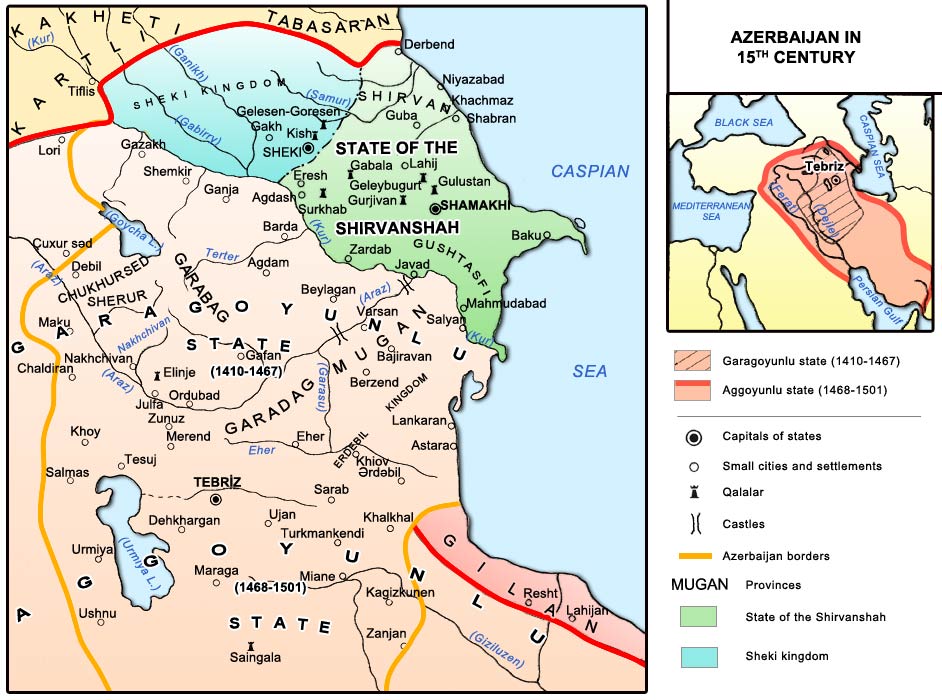 This smashed the occupation plans of the unit Christian bloc, which consisted of Armenian, Georgian, and Byzantium aggressors, taking advantage of Arabic Caliphate weaking. Slavian-Russian interventionists, making frequent attacks via the Caspian Sea, could not strengthen their position in Azerbaijan. The necessity of unification in the struggle against common enemy leads to the formation of unit religion, common traditions, and ceremonies, integration of population, which caused further strengthening of the ethnic-political union.
This smashed the occupation plans of the unit Christian bloc, which consisted of Armenian, Georgian, and Byzantium aggressors, taking advantage of Arabic Caliphate weaking. Slavian-Russian interventionists, making frequent attacks via the Caspian Sea, could not strengthen their position in Azerbaijan. The necessity of unification in the struggle against common enemy leads to the formation of unit religion, common traditions, and ceremonies, integration of population, which caused further strengthening of the ethnic-political union.
Nevertheless, durable stability did not establish due to the fact that none of the Azerbaijan countries, which appeared after the collapse of the Arabic caliphate, managed to turn into a durable, unit, and strong state, covering all territories of the country. Unit Christian bloc, consisted of Byzantium empire, Armenian and Georgian feudal lords, taking advantage of Caliphate’s weakening, directed all its force against Azerbaijan at this time. The significant turning point began in the history of the Near and Middle East just in this period – the XI century. The Great Saldjuc emperorship, covering wide territories from Central Asia to the Mediterranean Sea and from Darband’s passage to the Persian Gulf, appeared. Azerbaijan was included in the next Oghuz-Turkish state — Saldjuc emperorship.
Saldjuc period took a decisive part in Azerbaijan’s historic fate. Turkish-Islam union gained definitive victory over Christian bloc (Byzantium empire, Armenian and Georgian feudal lords), attempting to occupy Azerbaijan, with Sultan Alp Arslan’s defeat over the Byzantium empire in the Malazgird battle (August 26, 1071). It destroyed the plans of the Byzantium empire concerning the strengthening of its position in the Southern Caucasus and invasion scheme of Armenian and Georgian feudal lords
Thus, the plan on including of the Southern Caucasus into influence sphere of Christianity failure, Christian factor generally fell into a delay in this region.
Oghuz Turks, generally Turks definitely turned into the main ethnic-political factor in the whole Southern Caucasus and Southwest Asia as the result of saldjuc flow. Turkish-Islam factor plaid a definable role in the further history of the Near and Middle East, including the Caucasus for a long time.
New communities of Turks settled down in Azerbaijan during Saldjuc follow. Oghuz-saldjuc Turks of the same origin, adopted Islam, integrated with Azerbaijan Turks in a short time.
Thus, the formation of Azerbaijan people, whose genesis based on iskits (skits, skifs), saks, massagets, huns, bulgars, khazars, barsils, pechenegs, suvars, and especially oghuz turks (garagoyunlus, aghgoyunlus, saldjuck, etc), lived in different historical times (as B.C as A.D ), came to the end. Azeri-Turkic language became the main communication means in the whole Southern Caucasus. Simple and intelligible Azeri-Turkic language, ousting dialects, as well as Arabic and Persian, turned into the national language. Spreading of folk examples by ashugs’ (folk poet and singer) paved the way for the appearance of writing literature patterns in Azeri-Turkic language.
Azerbaijan nation is one of the nations distinguished by its peculiarity. Azerbaijanians made a great contribution to the treasures of the world culture as an integral part of human history during the past two thousand years. Our ancestors, using all primitives’ achievements in culture, created a rich specific cultural-spiritual heritage. As monuments, found in the territory of Azerbaijan in the result of an archaeological dig, so folk-lore and witing literature heritage, extant till nowadays testify this.
Heydar Aliyev
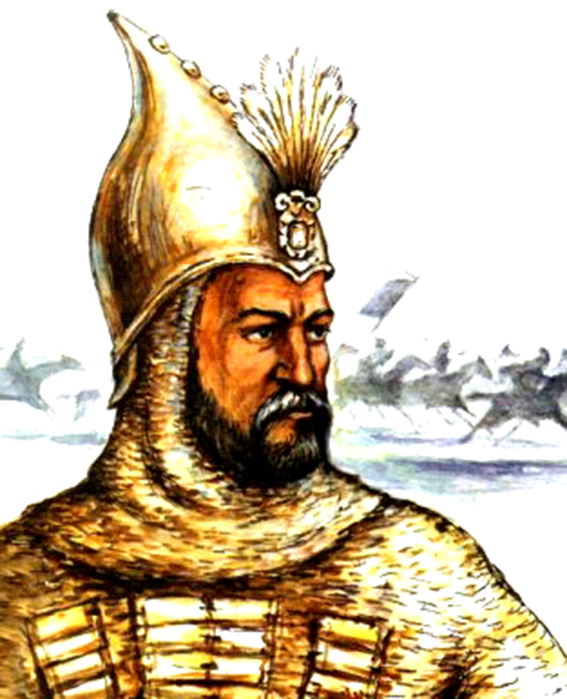
Shirvanshahs and Eldanizes states took an important role in the continuation and upgrade of Azerbaijan people’s statehood traditions after the collapse of the Great Saldjuc emperorship.
Eldanizes state, turning into one of the powerful countries of the Near and Middle East, plaid a significant role in Azerbaijan people’s ethnic-political history. Unification of all Azerbaijan lands within the unit state during Eldanizes ruling caused a strong update in all spheres of economic, political, and cultural life. Art, trade, science, and culture developed still more. Internal and external trade relations expanded, madrasas (religious schools) were opened, mosques and rare architecture monuments were erected. The Renaissance of Azerbaijan culture is famous for the creation of Khagani, Nizami, Ajami.
Thus, the role of Turkic-Islam empires became larger in the Caucasus, as well as the whole of Near and the Middle East after the collapse of the Arabic Caliphate in the mid-IX century. States, ruled by Sadjis, Shirvanshahs, Salaries, Ravvadis, Shaddadis, Saldjucs, Eldanizes, Mongols, Elkanis-Hulakus, Chobanis, Djalayirs, Teymuris, Ottomans, Garagoyunlus, Aghgoyunlus, Safavis, Afsharis, Gadjars, and other Turkic-Islam dynasties, left a deep trace in statehood history not only of Azerbaijan, but also the Caucasus, Near, and the Middle East.
Aghgoyunlu state became a powerful military and political factor in the whole of the Near and Middle East during the ruling years of Uzun Hasan (1468-1478), the Azerbaijan great statesman. The statehood culture of Azerbaijan developed still more. Uzun Hasan carried out a policy of establishment of a strong centralized state, covered Azerbaijan lands. A special « Code of law » was drawn up by is order. Azerbaijan was the central province of the majority of these states, while Tabriz — the capital for a long period. Most Turkic-Islam empires were ruled by Azeri-Turkic dynasties.
The statehood culture of Azerbaijan enriched still more in the XV-XVIII centuries. Large Garagoyunlu, Aghgoyunlu, Safavi, Afshar, and Gadjar empires of the East were directly ruled by Azerbaijan dynasties. This significant factor had a positive influence on the internal and international relations of Azerbaijan, expanded military and political influence sphere of the country, usage place of Azerbaijan language, created favorable conditions for the development of Azerbaijan people’s material and spiritual culture. Azerbaijan states took an active part in European-Est relations along with an important role in military and political life, international relations of the Near and Middle East in the aforesaid period.

Far-sighted statesman tried to improve the position of taxpayers, develop settled economy fields, put an end to state officials’ arbitrariness, and tribe heads’ military-political independence.
Uzun Hasan foresaw religious divergence and its effect on the state, the ethnic-political union of the country. Marring off her sister to Sheykh Djuneyd Safavi and daughter to Sheykh Heydar Safavi, he tried to prevent coming religious divergence and make peace between aghgoyunlus and safavis. Eminent military leader, closely observing changes in the world military science, tried to establish a strong regular army, increased the number of mercenaries, made preparations for fire-arm production and strong artillery foundation.
He invited armorers and military specialists from Italy for this purpose. Eminent statesmen paid special attention to the development of science and enlightenment. He gathered the most leading scientists of his time in the palace. About 60 scientists worked in the ruler’s private library. Scientific assemble, consisting of eminent scientists of that time, operated in Uzun Hasan’s palace. The Koran was translated into Azeri, « Kitabi-Diyarbakriya » was written by Abu Bakr Al-Tehrani, an eminent scientist of that time, by order of Uzun Hasan.
The role of Azerbaijan in the East-West relations encreased in the period of his ruling. Azerbaijan established wide diplomatic relations with European states along with traditional eastern countries. Azerbaijan envoys conducted diplomatic negotiations in the palaces of the Venetian Republic, Papcy, Neapol kingdom, Albania, Hungary, Poland, Germany, Burgundian duchy, Cyprus, Rodos, Trabzon emperorship, Moscovy princedom, and a number of eastern countries in the period of Uzun Hasan’s ruling. Uzun Hasan’s mother — Sara Khatun, the only female diplomat in the East at that time, a plaid important part in the negotiations, conducting with foreign states. The standing embassy of the Venetian Republic operated in the palace of Uzun Hasan, Tabriz. Azerbaijan plaid a significant role in the solution of international problems, representing common interests for the East and West.
Life and activity of Mahamad Jahan Pahlavan, Gizil Arslan, Uzun Hasan, Shah Ismayil Khatayi and other statesmen developed people’s love for native lands and statehood feelings, turned it into the most important purpose of life.
Heydar Aliyev
The new evolution stage began in the history of Azerbaijan statehood in the late XV-early XVI centuries. Shah Ismayil Khatayi(1501-1524), the Uzun Hasan’s grandson and eminent statesman, completed the work, begun by his grandfather, and managed to unify all Azerbaijan lands in the north and south under his ruling. He created a unit centralized Azerbaijan state — Azerbaijan statehood culture developed still more, Azeri became the official language at Safavis’ ruling. Safavis state with the capital Tabriz.
Safavi state turned into one of the powerful empires of the Near and Middle East as the result of successful reforms, internal and foreign policy, carried out by Shah Ismayil, Shah Tahmasib, Shah Abbas, and other Safavi rulers.
The mechanism of perfect state management was created for the ruling of the large Safavi empire. Safavi rulers got religious power along with temporal one. Central power was strengthened in this way.
The Supreme consultative assembly or Supreme kingdom council (Madjlisi-ala) operated in the palace. The perfect bureaucratic system was established for the regulation of central and local government bodies. The supreme divan (council) controlled all court cases throughout the country.
Safavis’ military forces turned into one of the most powerful armies as a result of reforms, carried out by Safavi rulers, particularly Shah Abbas. During Safavis’ ruling, the role of the Azerbaijan language increased throughout the Near and Middle East. Diplomatic negotiations with foreign envoys, as a rule, were conducted in Azeri.
Azerbaijan maintained diplomatic relations with many European states from the Black Sea and the Mediterranean Sea basin to Britain and the Scandinavian peninsula during Safavis’ ruling, continuing Aghgoyunlus’ foreign policy.
Negotiations with a number of western diplomats were conducted in the palaces of Shah Ismayil Khatayi, Shah Tahmasib, Shah Mahammad Khudabanda, Shah Abbas and other Safavi rulers to establish close mutual relations. Azerbaijan continued to play an important role in mutual relations between the East and West at Safavis as in the Aghgoyunlus’ period as well.
Eminent Azerbaijan military leader Nadir Shah Afshar (1736-1747), come to power after the collapse of the Safavi state, expanded the borders of the Safavi empire still more. This great ruler of Afshar-Turk origin occupied Northern Indian, including Dehli, in 1739. But Azerbaijan ruler’s plans on the establishment of the powerful centralizing state in these wide territories failed. The large empire collapsed after his death. Local states, striving for independence, appeared in the Azerbaijan territories still inter vivos of Nadir shah. Thus, Azerbaijan divided into small states like khanates and sultanates in II half of the XVIII century. The military-political decay stage of the country began. Though separate khans, trying to keep the ancient statehood traditions of Azerbaijan, attempted to unify the country, they did not have an effect.
Political disunity became deeper and foreigners got a suitable chance to occupy Azerbaijan. Azerbaijan dynasty Gadjars (1796-1925) came to power in Iran in the late XVIII century. They began to carry out subordination policy of all territories, once been under the power of their ancestors Garagoyunlus, Aghgoyunlus, Safavis, and Nadir Shah, to central power.
Thus, durable wars period between the Gadjars and Russia, trying to occupy the Southern Caucasus, began.
Azerbaijan turned into a bloody battlefield between two large states. Armenian and Georgian generals, leading military operations, took advantage of the situation and committed genocide against Azerbaijan civilians.
According to agreements by Gulustan (1813) and Turkmanchay (1828), Azerbaijan was divided between two empires: Northern Azerbaijan was attached to Russia, while Southern Azerbaijan to Iran, ruled by Gadjars.
Thus, new political-geographic expressions appeared in Azerbaijan: « Northern Azerbaijan » (« Russian Azerbaijan ») and « Southern Azerbaijan » (« Iranian Azerbaijan »). In contradictory to Southern Azerbaijan, under the power of an outdated shah regime, Northern Azerbaijan integrated into the comparatively leading culture-economical of Russia and Western Europe.
Azerbaijan people’s russification stage began in the north, while personification in the south.
Gulustan and Turkmanchay agreements, signed in 1813 and 1828, divided Azerbaijan, its historical lands, and people into two-part.
Heydar Aliyev
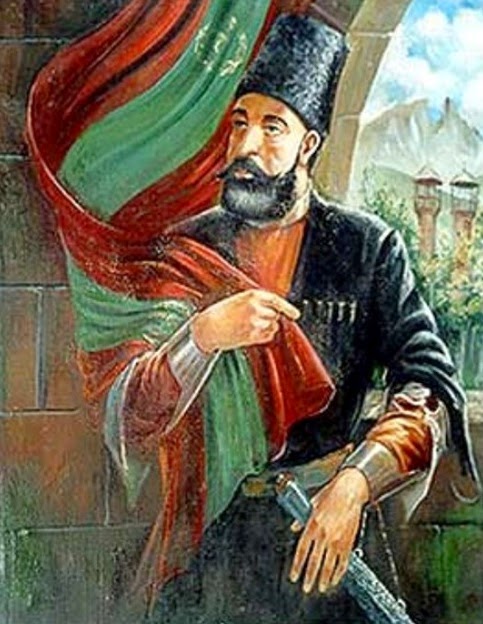
Russia began to conduct ousting policy of Azerbaijanians from the Caucasus to move forward the East, make its way to warm seas. First of all, it relied on the Christian population of the Caucasus, particularly Armenians, removed from Iran and Turkey, as well as Georgians. Russia began to convert the local Muslim population into Christianity by force.
Thus, the Christian factor revived in the Southern Caucasus with the beginning of large-scale occupations by Russia. The Tsar government attempted to resettle the Christian population from Russia into Azerbaijan territories.
As this policy failed at first, Russia resettled Armenians from neighbor countries into occupied Azerbaijan lands, particularly mountain regions of Karabakh, Iravan, and Nakhichevan khanates in order to create props in the Southern Caucasus. It established an artificial « Armenian province » in the western lands of Azerbaijan (former Iravan and Nakhichevan khanates), bordering with Turkey, with a special purpose. Thus, the basis of a future Armenian state was laid on the Azerbaijan lands.
Azerbaijan’s population of the northwest (at the border with Georgia) was subjected to converting to Christianity by the Georgian church. Georgian feudal lords, taking advantage of the situation, began to realize their dream concerning converting the Muslim population into Orthodoxy and their georgianification with the support of Russian colonists.
Besides, Russia abolished the independent Albanian church and subordinated it to the Armenian Gregorian church in 1836. So, a more favorable condition for converting Albanians into Gregorian faith and armeniafication was created. Basis of Armenians’ new territorial claims was laid. But Russia was not satisfied with it and armed Armenians against the Turkic-Moslem population that lead to genocide.
The colonial policy of czarism and its assistants met with the local population’s obstinate resistance. However, colonists managed to convert some Albanian-ingiloy villagers into Christianity due to the distribution of confiscated Azerbaijan bays’ lands and granting privileges. Colonists were not content with it and turned ancient Albanian churches into Orthodox churches, constructed new ones. This policy was carried out under the direct control of the Caucasian governor.
At the same time resettlement of the Christian population from Russia into Azerbaijan occupied a significant place in the policy of czarism along with converting of local people into Christianity. The purpose was to strengthen the role of the Christian factor in the Caucasus, including Azerbaijan.
The same policy was carried out by the reactionary Shah regime in the south lands of Azerbaijan.
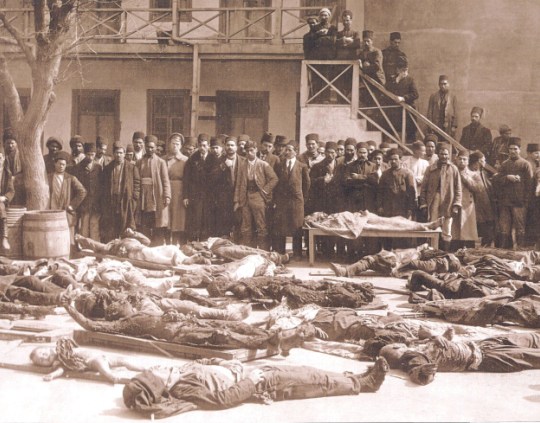
Azerbaijan people’s struggle for freedom strengthened in the north and south. Russia and Iran waged bloody wars with one another, became true allies to crush Azerbaijan people’s struggle for freedom, and not allow the unification of our states. Nevertheless, the Azerbaijan people did not stopped the struggle for independence against the Russian government and Iranian shah regime, stirred up rebellions, and met a loss.
Azerbaijan people fought for the newly independent and democratic state during the First Russian revolution (1905-1907) and the 1905-1911 years revolution in Iran.
Azerbaijan people rose to revive their national statehood traditions in the north and south during the First World War.
Struggle for freedom resulted in unexampled tragedies in Northern Azerbaijan. Sh. Shaumian’s Dashnak-Bolshevik government committed a terrible genocide against the Azerbaijan people in March 1918. Turkey held out its assisting hand to Azerbaijan. The freedom movement won. The Azerbaijan Democratic Republic, the first democratic republic in the East, was created in Northern Azerbaijan on May 28, 1918.
Independent and democratic Azadistan state (Freedom state) was established in South Azerbaijan in 1920. Sheikh Mahammad Khiyabani became head of the Azadistan National government. Wide national democratic reforms were carried out in both Azerbaijan states.
Thus, Azerbaijan people, taking advantage of the historical situation, originated from the First World War, managed to revive its ancient statehood traditions in the north and south, proved that it deserved and capable to live independently one more. Like in European countries, in Azerbaijan also application of democratic management rules specific to parliamentary republic started. It was a very big historical achievement of the Azerbaijani people.
AZERBAIJAN DEMOCRATIC REPUBLIC — THE FIRST PARLIAMENTARY REPUBLIC IN THE EAST
(May, 1918-April, 1920)

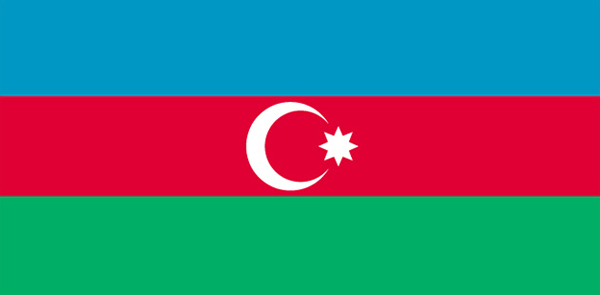
The cruelest and bloody regime in the entire history of civilization, Tsarist Russia, did not manage to destroy the traditions of the state system establishment of the Azeri people. The Russian Empire that enslaved Turkic-Muslim peoples and tried to destroy their national consciousness and ancient traditions of the state system establishment turned this policy into horrific bloodshed in the South Caucasus. This cruel policy involved ethnic cleansing of Turkic-Muslims of the South Caucasus in Azerbaijan, in order to gain access to the warm seas after destroying Iran and Turkey, thus reaching the most important target in Russian history – India. For this very purpose, Christian people of different origins were brought to Azerbaijan from various regions of the empire, in which the local population was then converted to Christianity and russified. Armenian-Muslim fighting was the most terrible of events of all those committed to the successful implementation of the aforementioned brutal policy. In other words, Azerbaijan became the site of the most terrible ordeal under the policy of Tsarist Russia nationalism.
Therefore, Azerbaijan, which has the most ancient traditions of the state system established in all of the former Russian Empire became the major center of the resistance movement against the cruel colonial regime of tsarism. The Azeri people, which were accustomed to ruling rather than being ruled, led the movement of national freedom of all Turkish-Muslim peoples of Russia under the command of the leading intellectuals of the country.
The late 19th-early 20th century was the period of the establishment of new relations that influenced all spheres of life of the Azerbaijani people. Social processes of that period turned the large industrial city of Baku into the economic center of the entire Caucasus region.
Heydar Aliyev

In the early 20th century, the Russian Empire initiated reforms in order to escape from the deep military, political and economic crises. At the same time, Azeri intellectuals protected by the great philanthropist H.Z.Taghiyev along with other requirements demanded the representation of the Turkic-Muslim population in the central government bodies, their participation in local executive and judicial bodies, and struggled for the prevention of discrimination and restrictions.
The Prominent lawyers Alimerdan bey Topchubashev, Shemsi Asadullayev, Ahmed bey Aghayev, Adil khan Ziyadkhanov, Ali bey Huseynzade and a number of other intellectuals of Azerbaijan were the leaders of this movement.
North Azerbaijan became the symbol of the struggle of all eastern people for freedom and the downfall of Tsarism. An idea to establish a political organization for uniting all Turkic-Muslim people of the Russian Empire in the struggle against Tsarism was generated in Azerbaijan in no way by accident.
The representative from Azerbaijan, Alimerdan bey Topchubashov conducted a report devoted to the situation and problems of Turks within the Russian Empire at the session that the world’s Muslims held in Nijni-Novgorod in 1905. The intellectuals of Azerbaijan took an active part in the development of the Program and Statute of the Union of All-Russian Muslims (Ittifagi-Muslimin).
As a result of a tense struggle conducted in complicated and difficult conditions, the well-known representatives of Azerbaijan Alimerdan bey Topchubashev, Ismayil khan Ziyadkhanov, Abdurrehim bey Hagverdiyev, Mamed Taghy Aliyev, and Asadullah bey Muradkhanov were elected the deputies of the First State Duma of the first Russian parliament. Two of these highly educated people were lawyers by profession: Alimerdan bey Topchubashov graduated from the University of Petersburg and Ismayil khan Ziyadkhanov was educated at Moscow University.

Alimerdan bey Topchubashev was elected the chair of the largest faction of the State Duma of Russia — the Muslim faction. The deputies of Azerbaijan speaking in Duma, criticized the policy of national bloodshed held by the Russian Empire in the South Caucasus, discrimination of Azeri and Muslim people, the policy of resettlement, enslaving of the people and defended the interests of not only Azeri people, but all Muslims of the Russian empire.
Thus, the Azeri deputy Ismayil khan Ziyadkhanov pointed out decisively in one of his speeches at the Duma session: « We (Azerbaijan) were occupied a century ago and we were deprived of every right. We were enslaved and our national wealth was stolen. We were prohibited to enter high school. Not one Turk was among the officials of the state bodies. We suffered from deprivation of land. However, on top of all this, peasants were moved to our land from Russia. You will establish settlements planned for Russian peasants on these lands that are stained with blood on the basis of the national bloodshed. This is nothing but the way of ruling based on the principle « split up and rule ». We have been walking on dead bodies in our motherland suffocating with blood for two years. Our patience has been exhausted ». The deputies of the Second State Duma Fatali Khan Khoyski, Khalil bek Khasmamedov, Mustafa Makhmudov, Mamed agha Shikhlinsky, and Zeunal Zeynalov also opposed tsarism in every way, including the policy of national and religious discrimination.
The Deputies of Azerbaijan made a great contribution to the struggle of all Turkic-Muslims against tsarism, thus creating much apprehension regarding tsarism, and along with other factors in the dismissal of the first and second Dumas. Therefore, Central Asia, Siberia, and other regions, mainly inhabited by Turk-Muslims, were not allowed to take part in the elections of the third Duma, and Baku city was deprived of the right to nominate its own candidate.
For this reason, the Muslim population of the entire South Caucasus was represented only by one deputy Khalil bey Khasmamedov in the State Duma. The fourth state Duma also included only one representative of the South Caucasus Muslims — Mamed Yusif Djafarov.
Almost all Azeri deputies elected to the State Duma were the ardent leaders of the national movement. The Duma Deputies Alimerdan bey Topchubashev, Ismayil khan Ziyadkhanov, Fatali khan Khoyski, Khalil bek Khasmamedov, and Mamed Yusif Djafarov were lawyers. Mamed agha Shakhtakhtinski was a student at the University of Sarbon and graduated from the faculty of philosophy of the Leipzig University.
Thus, in conditions of the collapse of the peoples’ prison Russian Empire during the Great Patriotic War Azeri people were prepared for the life of the independent state due to the mastering of the most up-date culture of governing and ancient traditions of state system establishment.
Unlike the southern regions, which preserved the part of the Iranian kingdom and ruled by the Gadjar Dynasty, North Azerbaijan was able to familiarize with the new traditions of democratic state organization and parliamentary system of the West through Russia and of Russia during its reign over Azerbaijan.
The intelligentsia of Azerbaijan, including Alimerdan bey Topchubashev and professional lawyers, acquired large experience in the rich parliamentary system of the State Duma of Russia. They were ready to create the most democratic republic ensured of all rights and liberties and completely differing from the absolute monarchy of Russia, leading to the cruel national tyranny which they despised. The concept of creating a democratic state was formed by the officials of the Azerbaijan People’s Republic in the time of their operating in the Russian State Duma. Therefore, the formation of the People’s Republic of Azerbaijan as a parliamentary state was caused by the historical reality. Following the overthrow of tsarism, the real development of events also led to this process.
The complicated sociopolitical processes developing in the 20th century led to profound changes in the society of Azerbaijan, our prominent state officials formed in new conditions were ready to react properly to the challenges and requirements of the century. A sound foundation had been created for the establishment of the People’s Republic of Azerbaijan.
Heydar Aliyev
The Romanovs dynasty was overthrown in Russia in February of 1917. The Temporary government which came to power created a Special Committee for the South Caucasus after the overthrow.

However, the government could not rule long. The South Caucasus Deputies elected to the Assembly of Entrepreneurs were not able to come to Petrograd and Moscow due to the revolution of October 1917. They established the highest governmental body- Transcaucasian Seym, in other words, the Transcaucasia Parliament in Tbilisi on February 14, 1918.
The Muslim Fraction of the Transcaucasia Seym was represented by 44 deputies that got the vote of more than 1 million Turkic-Muslim and Azerbaijani voters of the entire Caucasus during the elections to the Assembly of Entrepreneurs.
The Muslim Fraction of the Transcaucasia Seym, in fact, performed the functions of the Council of Transcaucasia Muslims, in other words of the Parliament of Transcaucasia Muslims.
The most interesting and natural matter of all was the fact that representatives of Azerbaijan were the most devoted members of the Transcaucasia Seym as well as of the State Dumas. The Transcaucasia Seym declared the independence of Transcaucasia and established the United Transcaucasia Republic by their very demand on April 9, 1918.
Yet due to the contradictions in the national interests both in internal and external policy the Transcaucasia Seym and the United Republic of Transcaucasia were not able to undertake concrete measures. As a result of that Georgian representatives left the Seym on May 25, 1918, and the next day May 26 declared the independence of Georgia.
Members of the Muslim Fraction of the Seym or new Muslim Council of Transcaucasia (in fact, the Parliament of Transcaucasia Muslims) held a separate session on May 27, at which they decided to declare the independence of Azerbaijan. The Council of Transcaucasia Muslims declared itself the National Council of Azerbaijan, in other words, the Parliament of Azerbaijan for the purpose. Thus, the first Parliament of Azerbaijan was set up and the first parliamentary Republic was established in Azerbaijan. The Presidium and the chair of the National Council of Azerbaijan were elected at that session held May 27, 1918, and M.A.Rasulzade became the chair of the National Council.
The historical session of the National Council of Azerbaijan chaired by Hasan bey Aghayev was held on May 28.
The session was attended by Hasan bey Aghayev (the chair), Mustafa Mahmudov (secretary), Fatali khan Khoyski, Khalil bey Khasmamedov, Nasib bey Usubbeyov, Mir Hidayet Seyidov, Nariman bey Narimanbeyov, Heybet Gulu Mamedbeyov, Mehdi bey Hadjinsky, Ali Asker bey Mahmudbeyov, Aslan bey Gardashov, Sultan Medjid Qanizade, Akber Agha Sheikhulislamov, Mehdi bey Hadjibabayev, Mamed Yusif Djafarov, Khudadat bey Melik Aslanov, Ragim bey Vekilov, Hamid bey Shahtakhtinsky, Firidun bey Kocherlinsky, Djamo bey Hadjynsky, Shefy bey Rustambeyov, Khosrov pasha Sultanov, Djafar Akhundov, Mehemmed Meherremov, Djavad Melik Yeganov and Hadjy Molla Selim Akhundzade that worked out the Declaration of Independence of Azerbaijan
The Declaration of Independence declared the establishment of the first parliamentary republic in the Turkic-Muslim world and in the entire East -the Democratic Republic of Azerbaijan. The Declaration of Independence of the National Council of Azerbaijan stated:
1. Since this day, Azerbaijan, covering the South-East Transcaucasia is a fully independent state.
2. The people of independent Azerbaijan are the source of government.
3. The People’s Republic of Azerbaijan will establish good relations with all nations, especially with neighboring countries.
4. The People’s Republic of Azerbaijan ensures the political rights and citizenship of all its residents within its bounds regardless of nationality, faith, class, estate, and sex.
5. The People’s Republic of Azerbaijan creates wide opportunities for the free development of all nations, residing within its bounds.
6. Azerbaijan will be headed by the Temporary Government, reporting to the National Council and the National Council, elected by the people, until the gathering of the Assembly of Entrepreneurs.
The historical declaration, developed by the National Council of Azerbaijan had fixed basic principles of the foreign and inner policy of the newly established The people’s Republic of Azerbaijan. All the principles stated in the Declaration-the principles of defining its own fate by the people of Azerbaijan, respecting the rights of people, living in peace with foreign countries and neighbor states increased the prestige of the People’s Republic of Azerbaijan in the international arena.
Heydar Aliyev
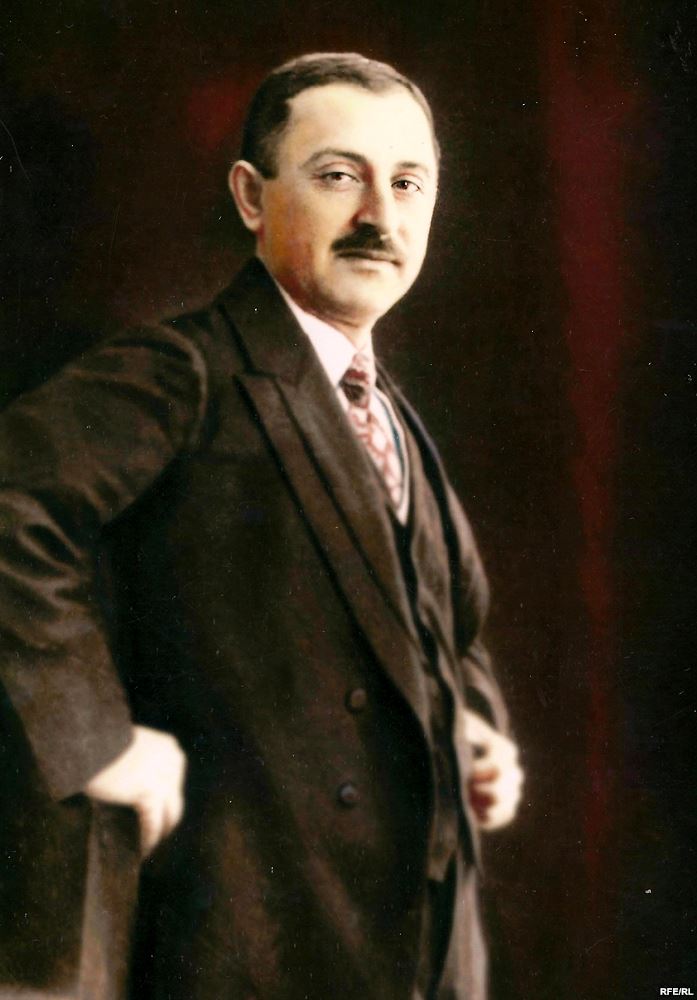
At the same time, the National Council of Azerbaijan also approved the composition of the first Temporary Government of the People’s Republic of Azerbaijan headed by neutral Fatali khan Khoyski.
The first temporary government included the following staff:
Fatali khan Khoyski-chair of the Council of Ministers and the Minister of internal affairs
Khosrov Pasha Sultanov-Military Minister
Mamed Gasan Hadjinsky-Minister of Foreign Affairs
Nasib bey Usubbeyov-Minister of Finance and National Education
Khalil bey Khasmamedov-Minister of Justice
Mammad Yusif Jafarov – Minister of Commerce and Industry
Akper Agha Sheykhulislamov-Minister of Agriculture and Labor
Khudavat bey Melik Aslanov-Minister of Roads and Post
Jamo bey Hadjinsky-state controller
Thus, in the complicated conditions of the Great Patriotic War and the overthrow of Romanovs’ absolutism the traditions of state system establishment restored in the form of the parliamentary republic on the northern lands of Azerbaijan.
The young state of Azerbaijan was established in too complicated internal and international conditions. The group of Dashnak-Bolsheviks usurped the government of Baku and initiated the genocide of the Turkic-Muslim population of the country. The groups of Armenian brigands, armed by the tsarist generals, continued the bloodshed of the Turkic-Muslim population of East Anadolu and West Azerbaijan. The despots of Azerbaijani people Shaumyan and Andronik acted conjointly. The people of Azerbaijan faced the threat of physical termination. The competition between foreign powers for control over the oil-rich Baku was nearing its end and the South Caucasus faced the next challenge -the threat of being occupated by Bolshevic Russia. The people of Azerbaijan found themselves at the crossroads whether to choose the national resurrection or to be fully removed from the ethnic political map of the South Caucasus through terminating. Under such conditions, the state officials that declared the independence of Azerbaijan led the people that were caught in the hard situation with no evident way out.
The National Council and the government moved its operation center to Ganja on June 16, 1918. Considering the real situation in the country, the National Council of Azerbaijan carried out two decisions in Ganja on June 17: to suspend its activity for a period of time; to transfer the ruling functions (both executive and legislative) to the newly established second Temporary government chaired by F.Khaoisky until the Assembly of Entrepreneurs is convened.
The government was composed of the chair of the Council of Ministers Fatali khan Khoisky, Ministers-Mamed Hasan Hadjinsky, Nasib bey Usubbeyov, Alimerdan bey Topchubashov, Behbud Agha Djavanshir, Khalil bek Khasmamedov, Khosrov Pasha bey Sultanov, Khudabat bey Rafibeyov, Khudadat bey Melik-Aslanov, Agha Ashurov, Abdul Ali bey Amirdjanov, Musa bey Rafiyev.
The National Council of Azerbaijan fearing losing the country’s independence, gained with such difficulty decided to convene the Entrepreneurs Assembly as soon as possible and by that time F. Khoisky must control the government himself and make no concessions to anyone. At the same time, the National Council of Azerbaijan also defined the concrete rights and powers of the F.Khoisky government. The government wouldn’t have the right to abolish the state independence of Azerbaijan and political liberties could not alter the revolutionary laws on problems of agriculture and other urgent matters. The government was free in the settlement of other matters. The temporary government had to convene the Assembly of Entrepreneurs at least within six months. Thus, the first Parliament of the Democratic Republic of Azerbaijan-the National Council started its activity. The first activity of the National Council of Azerbaijan lasting only for 20 days from May 27 till June 17 of 1918 held only 7 sessions and accepted two important resolutions: the first-Azerbaijan was declared the independent state and the Declaration of Independence was approved, the second-the first government of Azerbaijan led by F.Khoyski was formed in Ganja and Azerbaijan started to be ruled independently for the first time from 1813.
The republican state was established in one part of Azerbaijan-the North Azerbaijan.
The government of the Democratic Republic of Azerbaijan led by F.Khoisky that came to power on June 17, 1918, had to save the people of the country living intense international and inner conditions and in fact experiencing the torture of genocide from the most difficult bloody conditions of the history of the Azeri people.

The establishment of the Azeri state system was launched immediately. The government undertook decisive actions for evasion of established situation. The military state was declared in entire Azerbaijan on June 19. The image of a white crescent and white eight-point star on a piece of red cloths has accepted the flag of independent Azerbaijan on June 24. The Military Corps of Muslims turned into the independent Corps of Azerbaijan on June 26 and the commander of the said corpse was awarded the title of a general.
The Commander of the Corpse of Azerbaijan who had powers of the division commander initiated the fulfillment of the special instructions of the government and in fact, that meant the establishment of the Azeri Army.
Azeri-Turkic language was declared the state language on June 27. The state structure even expanded at that time. The government decided upon importing textbooks and inviting teachers from Turkey. The schools were modernized and new training courses for teachers and schools were established. Yelizavetpol and Karyagin have renamed their historical names Ganja and Jabrail again. The national army of Azerbaijan was mobilized. The decision of creation of the Commission for Emergency Investigation was carried out on June 15. The commission had to inquire in the matters of violent genocide against the Turk-Muslim population of the South Caucasus and the plunder of their property during World War Second and to bring to trial those implicated. The resolution of the government, in fact, led to the creation of the system of the National Security of Azerbaijan. Moreover, the government implemented significant measures for stabilization of the situation, the establishment of transport and post-telegraph networks controlled by it. The resolution on general military service was worked out on August 11. The order on the citizenship of the Democratic Republic of Azerbaijan was issued on August 23. However, the major objective of Khoysky’s government was to spread the power of the Azerbaijan Democratic Republic to all the regions of the country and to clean Baku and its suburbs from the enemies of the Azeri people.
The Islamic Army of the Caucasus supported by the group of Azeri volunteers released Baku as a result of a hard battle on September 15, 1918. The city was cleaned from the remnants of the Menshevik-dashnak government « the CentroCaspiy Dictatorship » which took control over the country following the bolshevik-dashnak regime of Shaumyan.
Within three months after the establishment of F.Khoyskiy’s administration, the government of the Democratic Republic of Azerbaijan moved to Baku on September 17, 1918. Baku was declared the capital of the country. The influence of the Democratic Republic of Azerbaijan expanded.
The state flag of the Democratic Republic of Azerbaijan was replaced with the image of a white crescent and eight-point star on the three-color banner on November 9. The construction works intensified in socio-political, economic, and cultural life. F. Khoisky adhering to the legal norms and rules of the parliamentarian state system initiated preparation works for the establishment of the Entrepreneurs’ Assembly. A special commission was created for the purpose: Though 6 months had not passed since the decree of June 17, 1918, of the National Council, as the government had the power to control the state independently, the National Council of Azerbaijan was created on the initiative and request of F.Khoisky on November 16, 1918. The National Council of Azerbaijan undertook the establishment of the Assembly of Entrepreneurs by the proposal of the chair of the government F.Khoisky.
An important resolution in the history of the Parliamentary structure of Azerbaijan was carried out at a session of the National Council of Azerbaijan chaired by M.A.Rasulzade on November 19, 1918. Though the government of the Democratic Republic of Azerbaijan acted in an extremely hard situation it managed to find the most democratic way of controlling the state. As not only Azerbaijanis lived in the country the session proposed the participation of other nations in the National Council of Azerbaijan as well. The council comprised 120 representatives of 1 representative from 24 thousand people. Of the 80 people were Muslims, 21 Armenians, 10 Russians, 1 German, and 1 Jew. As there was a small number of Georgians and Polishes who did not have a right to vote they were represented in the parliament only by 1 man.
According to the resolution of the session of the National Council of November 19, 1918, 44 Muslim representatives elected in the All-Russia Assembly of Entrepreneurs were directly included in the parliament, while the other 36 Muslim representatives and those of other nations had to be elected again. The new Parliament should have been formed by December 3, 1918.
Though not half of a year had passed since the genocide committed in March of 1918, 21 Armenians were able to participate in the Parliament of Azerbaijan. The step which was undertaken in such conditions proved the deep respect displayed by the human rights and the democratic nature of Azeri people.
This bright fact of our Parliamentary Democracy was revealed in the message of M.A.Rasulzade to the people on November 29, 1918, due to the establishment of the new parliament: « Let’s put aside the hostility and differences that bring us only misfortune and misery. History obliged us to live side by side. Let’s build our life sensibly and on the basis of humanism, let’s love and respect each other to remove easily the future troubles of the new life. Despite different national and religious belonging, all the citizens of Azerbaijan are the sons of the single Motherland. They must support and help each other to coexist peacefully in the native land and to reach happiness together. »
M.A.Rasulzade announced by his message that the new parliament to comprise national minorities and representatives of separate regions will rule the country and will determine its fate, form its government and protect its interests.
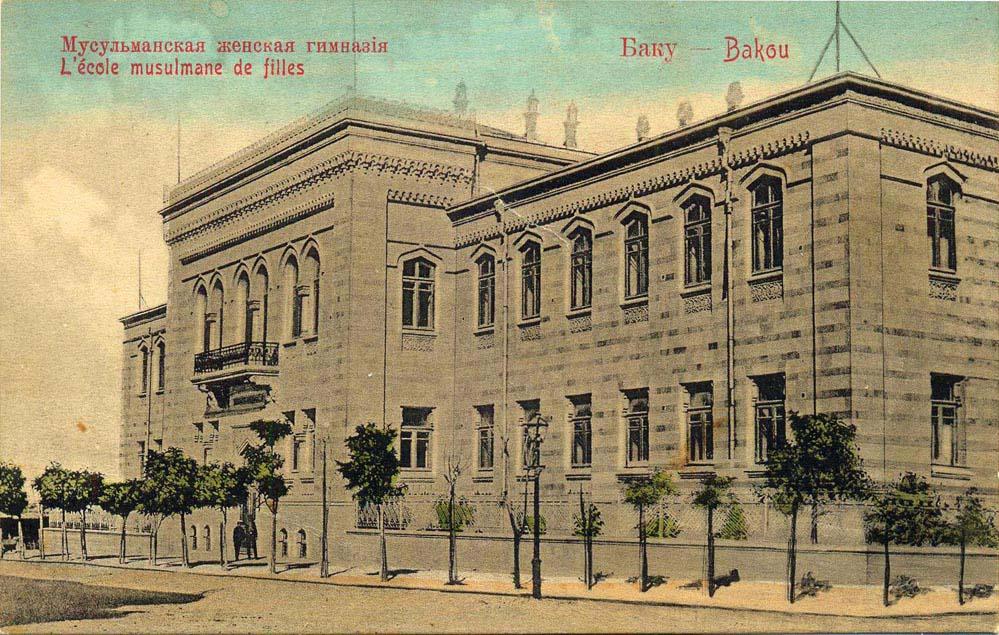 The ceremony of the opening of the Azeri Parliament was held in the building of the maiden seminary (currently, the Institute of Manuscripts after Fizuli) at 13:00 on December 7, 1918. That was the first parliament in the entire east formed on the basis of the most democratic principles of that time.
The ceremony of the opening of the Azeri Parliament was held in the building of the maiden seminary (currently, the Institute of Manuscripts after Fizuli) at 13:00 on December 7, 1918. That was the first parliament in the entire east formed on the basis of the most democratic principles of that time.
A.M.Rasulzade, the chair of the National Council of Azerbaijan delivered a wide congratulation speech at the opening ceremony of the Parliament.
By the suggestion of the Musavat fraction Alimerdan bey Topchubashev was appointed the chair of the parliament, Gasan bey Aghayev became his first deputy. As A.Topchubashev visited the peace conference in Paris, G.Aghayev headed the parliament. At the first session of the Parliament, the resignation of F.Khoisky’s government was ratified and the resolution on the establishment of a new government was carried out. F. Khoyski was again instructed to form the new government.
F. Khoyski introduced his program and the composition of the new government in the Parliament on December 26, 1918. The Parliament approved the program and accepted the government established by F.Khoisky.
Though Armenians were awarded 21 and Russians 10 places in the Parliament of Azerbaijan they did not take part in the opening ceremony thus serving a lesson in the initial stage of the activity of the Azeri Parliament. The Russian National Council operating in Baku did not recognize the fact of Azerbaijan’s separation from Russia as Azerbaijan established a way to the partition of the single and indivisible Russia though declaring itself independent and carried out a resolution of boycotting the Parliament of Azerbaijan.
Yet the Russian National Council was obliged to change its decision under the pressure of the country’s Russian citizens.
At that period Armenians, which did not reconciliate with the independence of Azerbaijan also supported the Russian National Council and did not take part in the session of the Parliament for nearly two months. They took the position of betrayal to Azerbaijan even after getting involved in the Parliament.
Moreover, the activity of 11 fractions and groups comprising less than 100 people in the Parliament also formed an obstacle to the establishment of the independent state in extremely hard and complicated internal and international conditions. A number of fractions and groups mostly preferred their own interests rather than that of the people. Thus, the socialist bloc of the Parliament screened by protecting of interests of the poor always propagandized the annexation of Azerbaijan to Soviet Russia attained the decision on opening the diplomatic mission of Soviet Russia in Azerbaijan and finally spoke for the intervention of the Red Army into the country that was nothing but the betrayal of the Democratic Republic of Azerbaijan.
Nevertheless, the parliament of the Democratic Republic of Azerbaijan traced in the history of the state system establishment of Azerbaijan and in the parliamentary traditions with its democratic measures and high-level legislative acts and resolutions accepted in the in a period of its 17 months uninterrupted activity.
The history of the Parliamentary system was divided into two stages through the period of the Democratic Republic of Azerbaijan: the first stage lasted from May 27, 1918, till November 19. Through the said period the Parliament of Azerbaijan acting as the National Council of Azerbaijan and comprising 44 Muslim representatives carried out critical historical resolutions. The first parliament declared the independence of Azerbaijan on May 28 of 1918, undertook the reign of the government, and worked out the declaration of independence.
The declaration of independence introduced to the Caucasus governor in Tbilisi by the National Council of Azerbaijan in such complicated conditions was the most prominent legal document of the Azeri democracy and parliamentary system and retains its significance even today.

The National Council of Azerbaijan was established on May 27, its activity was suspended on June 17 and all functions of the legislative and executive powers were delivered to the Temporary government on condition of the further gathering of the Constituent Assembly at least within 6 months. After the government of the Democratic republic moved to Baku on September 17, 1918, the National Council of Azerbaijan renewed its activity on November 16. It worked out the law on the establishment of the Parliament of Azerbaijan on December 3 of the same year and suspended its activity. Thus the Parliament of Azerbaijan operated in Tbilisi, Ganja, and Baku.
The second stage in the history of the parliamentary system of the Democratic Republic of Azerbaijan lasted only 17 months from December 7, 1918, till April 27, 1920. The first session was held on December 7 of 1918, the last on April 27, 1920. The Parliament conducted only 145 sessions within this period. At these sessions the Parliament of the Democratic Republic of Azerbaijan, adhering to the main principles and considering the definite historical conditions, carried out the important laws and resolutions for the establishment of the most up-date legal and democratic state with the ensured human rights and liberties and for protection of the country’s independence and territorial integrity. All these resolutions and laws aimed at the establishment of three branches of the government-legislative, executive, and judicial bodies.
The Parliament of Azerbaijan mainly directed its activity to the protection and preservation of the state independence and establishment of a single army in the hard and complicated international and inner state of the struggle of big countries for redistribution of the world in World War the first and the threat of occupation of the country. It should be noted that the Parliament members expressed unanimity of view in the discussion of laws and resolutions, worked out by the Parliament in this sphere.
Though acting in an extremely complicated situation the government of the Republic that tried to perpetuate the national resurrection of our people always attached a great deal of attention to the development of science, national education and enlightenment, and public health. Different schools, grammar schools, maiden schools, kindergartens, short-term teachers’ training courses, and libraries opened in all the regions of the country, villages were provided with clinics and veterinarian centers the struggle with infectious diseases was conducted.
One of the most important laws accepted by the Parliament was on the establishment of the State University of Baku on September 1, 1919. This step was one of the most significant actions of the government for the improvement of people’s welfare. Later the State University of Baku made a great contribution to the restoration of independence and perpetuation of the concepts of the Republic despite the overthrow of the Democratic Republic of Azerbaijan
The republican government and the parliament, which paid great attention to the development of science and education immediately started the training of national specialists in the said fields. At that period 100 young people of Azerbaijan were sent to study in foreign countries at the proposal of the government. The importance attached to this work is revealed in the fact that the Parliament created a special commission headed by M.E.Rasulzade and comprising five people (Mehdi bey Hadjynsky, Ahmed bey Repinov, Gara bey Garabeyov, Abdulla bey Efendiyev) to select those to be sent abroad on the competitive basis. By the resolution of the commission, 45 people were sent to France, 23 people to Italy, 10 people to England, 9 people to Turkey to study at high schools. 10 people to be sent to study in Russia could not go there due to the commencement of the civil war.
The Parliament of the Republic of Azerbaijan and the government had done much for introducing the young republic in the international arena in order to prevent the intervention of foreign countries. Due to that, the Parliament of the country carried out a resolution on the delegation led by the parliament chair A.M.Topchubashev to be sent to the peace conference in Paris on December 28, 1918. Though the prominent state official of the Republic A.M.Topchubashev removing hard obstacles attained the de-facto recognition of the republic by a number of big countries the intervention of the eleventh Red Army to the North Azerbaijan his activity remained half done.
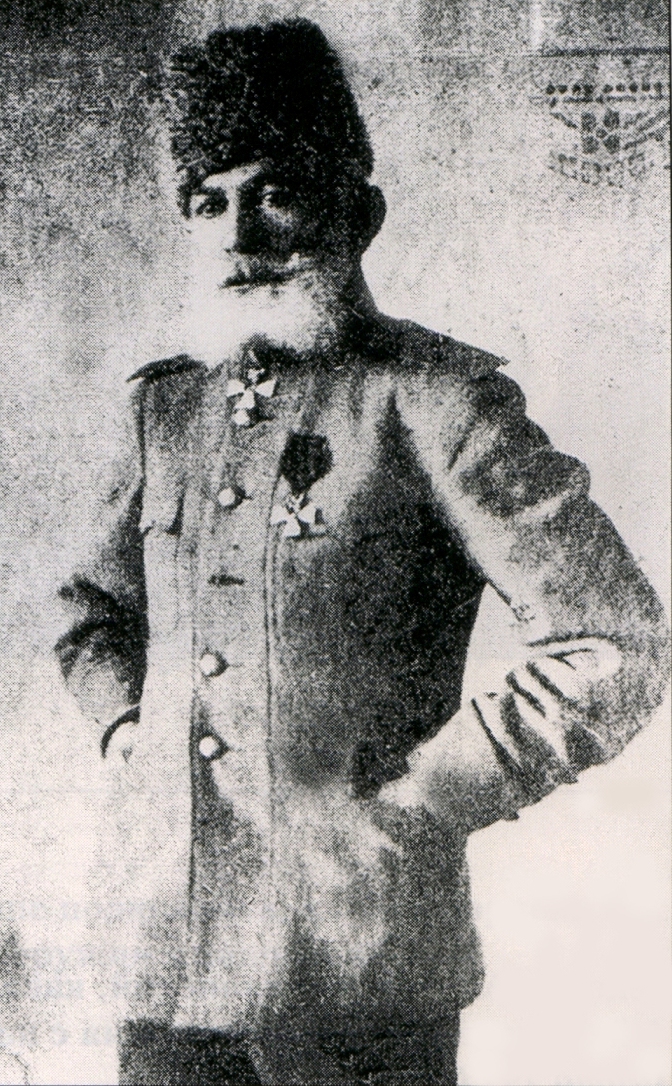
A number of contracts and agreements were signed with Iran and introduced to the Parliament in times of the Democratic Republic of Azerbaijan. The most important party of the activity of the Azeri Parliament and the government were the issues of the contacts with neighboring countries and borders. Though the relations with Georgia stabilized after a tense work, Armenia’s great territorial claims made the improvement of contacts between Azerbaijan and Armenia impossible.
At that time the parliamentary system of Azerbaijan gradually strengthened and developed, thus forming the most up-date parliamentary system. The parliament conducted 155 sessions in a period of the Democratic Republic of Azerbaijan, ten of them were conducted in times of the National Council of Azerbaijan (May 27-November 19, 1918), and 145-in period of the Parliament’s activity (December, 1918-April 27, 1920).
The parliament introduced over 270 laws for discussion with only 230 approved. The laws were discussed actively in the business atmosphere and approved only in their third reading.
The national representatives of eleven fractions and groups also participated in the development, discussion, and confirmation of the laws.
The Parliament of the Democratic Republic of Azerbaijan accounted for 11 commissions.
The activity of the parliament was controlled on the basis of the regulation of the Parliament of Azerbaijan prepared especially for the purpose.
M.E.Rasulzade gave the following assessment to the activity of the Azerbaijani Parliament:
« The National Assembly represented all the classes and nations of the country and fully controlled the fate of the state. No order came to power, no expense was made, no war was initiated and no reconciliation was signed without its participation. The government that gained the trust of the Assembly stayed while the one that failed -was overthrown. The country was not ruled by a single person. The power of the parliament was absolute ».
Though ss a result of the military intervention of the Societ Russia that thus violated the international norms and the hostilities launched by the eleventh Red Army in the country North Azerbaijan was again annexed to Russia the Democratic Republic of Azerbaijan entered forever the history of our people. Though existing for only 23 months, the Democratic Republic of Azerbaijan proved that neither bloody tyranny nor the regime of suppression could not terminate the independent state system establishment and concepts of freedom of Azerbaijani people.
Though the Democratic Republic of Azerbaijan survived only for 23 months in a complicated and tense socio political situation, it will always stay in the the memory of future generations as one of the brightest pages of our history. Though it was not able to implement fully the measures undertaken in spheres of the state system establishment, economics, culture, education, public health, military policy yet those measures implemented played a great role in the history of our country and in the restoration of the national state system establishment. The most important matter is that the Democratic The Republic of Azerbaijan strengthened our democratic views though it existed within a short period of time. The people of Azerbaijan will always honour the memory of the prominent state officials that served to the establishment of that republic as Mamed Emin Rasulzade, Alimerdan bey Topchubashev, Fatali khan Khoyski, Nasib bey Usubbeyov, Mehdi bey Hadjinsky, Mamed Yusif Djafarov, Khudavat bey Rafibeyov, Akper Agha Sheykhulislamov, Teymur bey Madjinsky, Samed bey Mehmandarov, Aliagha Shykhlinsky, Sultan Medjid Ganizade, Khalil bey Khasmamedov, Ahmed bey Papinov, Shafi bey Rustambeyov.
Heydar Aliyev
The first Parliamentary Republic of the Azerbaijani people at the same time was the first legal and secular state of the entire East and especially of the Turkic-Muslim world.
The Democratic Republic of Azerbaijan did not lay behind the traditional democratic republics of Europe by its state system, democratic state establishment measures as well as the objectives and tasks it undertook.
COUNTRY OF AZADYSTAN — NATIONAL GOVERNMENT OF SOUTH AZERBAIJAN (April-September 1920)
In the historical situation generated by the First World War, both in Northern Azerbaijan and in Southern Azerbaijan, the people rose to fight for the revival of their national traditions of statehood.
During the war, the territory of Iran, including the lands of South Azerbaijan, which covered the northwest of the country, was turned into an arena for military operations by foreign states. Iranian reaction and the domination of foreign conquerors brought internal contradictions to the limit and further worsened the already difficult situation of the people. Despite the fact that the tsarist autocracy in Russia was overthrown as a result of the February revolution, Russian troops still held southern Azerbaijan under occupation. After some time, the popular movement against the Shah’s regime and foreign conquerors, which swept the whole of Iran and the struggle for the constitutional system and democratic changes, began to take on the character of a national liberation movement in South Azerbaijan.
The events that took place in Russia, the victory of the liberation movement in the north of Azerbaijan, the revival of national traditions of statehood, and the reforms carried out by the People’s Republic of Azerbaijan, further strengthened the national liberation movement in the south of the country.

The national liberation movement in South Azerbaijan was led by an active participant in the Iranian revolution of 1905-1911. Sheikh Mohammed Khiyabani (1879-1920).
Along with the struggle against internal reaction and foreign conquerors, the freedom fighters led by Sheikh Mohammed Khiyabani demanded renewal, that is, the implementation of democratic changes throughout the country, strove for the victory of the people’s revolution throughout Iran, the elimination of the Shah’s regime and the creation of a democratic republican state. and fought for the granting of autonomy to South Azerbaijan within the democratic state of Iran, which was to be created. The Azerbaijan Democratic Party (ADP) played an important role in the rise to the liberation struggle of the population of South Azerbaijan in the form of a united front. The ADP Central Committee was headed by Sheikh Mohammed Khiyabani.
The democrats, acting under the leadership of Khiyabani, raised the population of Tabriz, Ardabil, Khoy, Urmia, Sarab, Zanjan, and other cities to rallies, demanded the resignation of the pro-British government of Iran and the implementation of democratic reforms in the country.
With the expansion of the national liberation movement in Iran at the beginning of 1918, Russian troops were withdrawn from South Azerbaijan. England, taking advantage of this, began to deploy its military forces in South Azerbaijan. The British were eager for Baku oil. The British government additionally sent new military forces to Iran under the command of General Densterville. General Densterville was instructed to seize Anzeli, Rasht, and Baku.
The seizure by the British of the regions of South Azerbaijan, bordering with Turkey, ostensibly for the purpose of « outstripping the Turkish danger » and thereby taking all of Iran under their control, further strengthened the national liberation movement in South Azerbaijan.
In such a situation, detachments of Armenian bandits, armed with Russian officers, began a genocide against the Azerbaijani Turks in the border regions of South Azerbaijan, as was the case in Eastern Anatolia and North Azerbaijan. Aysors and Kurds, incited by French officers and American missionaries, also took an active part in this bloody massacre against the Azerbaijani people. In this difficult situation, the military forces of fraternal Turkey arrived in time to help the Turks of South Azerbaijan. Turkish military units, which began in March 1918 to cleanse Maku, Urmia, and Salmas from the Armenian-Aisoro-Kurdish bandits, entered Tabriz. Thus, the genocide against the Azerbaijani people was suppressed in the territory of South Azerbaijan, as it was in the north of the country. However, in the very difficult international situation created at that time for Turkey, in November 1918 the Turkish military forces were forced to leave South Azerbaijan. The British, taking advantage of this, conquered all of South Azerbaijan, including Tabriz. Thus, the territory of Iran completely came under the control of the British interventionists.
On August 9, 1919, under pressure from the conquerors, an agreement was concluded between Iran and England. On the basis of the terms of this agreement, Iran turned into a country dependent on England. The August 9th agreement inflamed the popular movement in the country even more. All Iran, including South Azerbaijan, rose up against this humiliating treaty. Mass rallies and demonstrations began in all parts of South Azerbaijan. The fighters of Tabriz, who rose to the uprising in October 1919, drove out of the city the Iranian wali (governor — Ya.M.). After some time, at the request of the population of Tabriz, British military units were also withdrawn from the city.
Gradually, the national liberation movement took on a more consistent character and entered its decisive stage. On April 7, 1920, an armed uprising under the leadership of Sheikh Mohammed Khiabani began in Tabriz. The entire population of Tabriz rose to defend the rebels. The police units sent from the center to suppress the uprising did not dare to do so and left the city. As a result of the unprecedented activity of the people, the uprising on April 7, 1920, won a victory without bloodshed. Sheikh Mohammed Khiyabani, speaking before the people on the day of the victory of the uprising — April 7, announced that from that day the name of Azerbaijan would be renamed Azadistan (Country of Freedom).
The Tabriz rebels immediately began their practical activities. Government officials and military personnel sent from the center were removed from office. All state administration passed into the hands of ADP activists. Thus, the movement for democratic change and renewal, which began throughout Iran, ultimately turned into a national liberation movement. The revival of the traditions of the independent statehood of Azerbaijan began. The people strove for freedom and the creation of their own independent national state.
After the victory of the armed uprising in Tabriz, uprisings took place in Khoy, Ardabil, Astara, Marag, Ahar, and Zanjan. The national liberation movement, which took place in South Azerbaijan, was met with sympathy by all forces, dissatisfied with the internal reaction and the British and elsewhere in Iran.
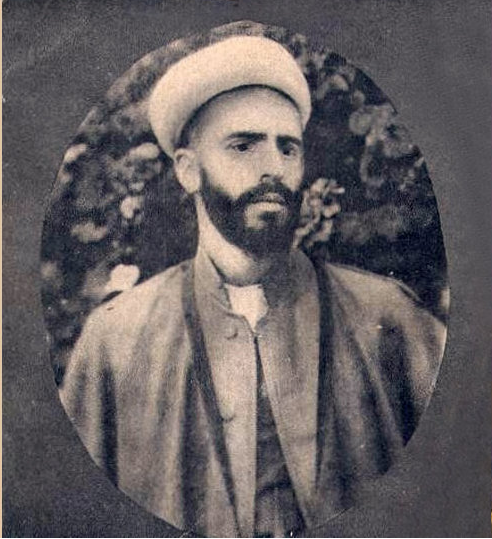
In conditions when the whole of Iran was gripped by popular discontent against reaction and British rule, the Tabriz rebels began to take more decisive steps. On June 23, 1920, the National Government was established in Tabriz under the leadership of Sheikh Mohammed Khiyabani. The national government, which included ADP activists, consisted of representatives from various segments of the population.
The day of the beginning of the activity of the National Government — June 24, turned into a national holiday in Tabriz. Work was suspended in all institutions, educational institutions, markets were closed. By the decision of the National Government, all officials of the center, including the Iranian wali, were expelled from Tabriz. In fact, this meant the overthrow of the reactionary Shah’s regime — the Iranian power — in South Azerbaijan and the revival of the traditions of national statehood. The national government, headed by Sheikh Mohammed Khiyabani, actually performed the function of a democratic republic.
Nevertheless, opposing the desire of the people to live completely freely, the National Government continued the line of the struggle for the democratization of all Iran and the creation of a constitutional system in the country, against internal reaction and British rule, and opposed the policy of discrimination against South Azerbaijan.
Thus, despite the people’s desire for complete independence and the actual creation of their own independent democratic republic, the National Government fought not for the complete independence of South Azerbaijan, but for the right to obtain autonomy within future democratic Iran.
The leaders of the National Government believed that after Tabriz the whole of Iran would rise, the Shah’s rule would be overthrown, the people would come to power and a democratic-republican system would be established throughout the country. And the Azerbaijanis will play an important role in the formation of the future all-Iranian people’s government. Khiyabani was confident that « Tabriz will save all Iran! »
The national government, which did not set itself the political task of separating Azerbaijan from Iran and creating an independent Azerbaijani state, began reforms in the economy, education, health care, and other areas. First of all, various changes were made to improve the plight of the poor, including Tabriz residents. The elimination of illiteracy began. National schools and hospitals were opened. A free school for girls from poor families has started operating in Tabriz. Teachers from Baku, Turkey, and even from Tiflis were invited to teach in the newly opened schools. Preparatory work began for the creation of a regular army — the National Guard. The National Government’s own gendarme and police units were created. A police school was opened. At the same time, preparatory work began for the creation of new jobs, the implementation of monetary and land reforms, municipal elections, and the creation of a financial and banking system. For this purpose, new departments, institutions, ministries were created.
As you can see, all the measures carried out by the National Government, as well as the envisaged reforms, were essentially aimed at creating an independent democratic-republican state in South Azerbaijan. The independent Azerbaijani state that was being created was called Azadistan memleketi (« Country of Freedom »). In accordance with this, on all official documents, letterheads, as well as signs with the names of ministries, departments, and institutions, the name of Azerbaijan was changed to Azadistan.
Khiyabani constantly called on his people to enlightenment, to fight for progress. He believed that this was the only way to achieve freedom. At meetings organized in the Tabriz City Park, he promoted progressive ideas. In the speech of Sheikh Mohammed Khiyabani, delivered on June 15, 1920, the main ideas of his struggle were reflected:
“Self-awareness is a natural and general law. Every person, every living being loves himself more than others. Therefore, any society should not expect an improvement in its well-being from another. It is especially inappropriate to wait for help and service from someone who is not close. Respect for one’s own personality and faith in it should be on a par with self-esteem. Any people or society should not be arrogant and distrustful of themselves.

A person should not accept baseness, shaking the basis of his own trust and modesty, equal to weakness. Humanity needs joint activities and mutual assistance. It cannot be imagined that small people living in the world cannot give humanity any benefit, and one can treat its existence with disdain. It is a pity that we do not value ourselves enough and may not even know that we have our own pride. This has been tested in the activities of individuals. Individuals with high specificity, serving high ideas, evaluating their level and their honor, have always reached heights. It is for this reason that many writers and philosophers, for the sake of their personalities, reached the highest level and forced even padishahs to respect their work and strength. They had the highest influence in palaces. Nations can also make progress and development by revealing this greatness, morality, strength, pride, and trust in their existence. A person who wants to be free and independent cannot remain indifferent to their life and social problems. In order to stand on a par with progressive nations, we must also raise our thoughts and feelings to their level.
The first condition for the honor of a nation is its independence.
A people without freedom are devoid of will and respect. The independence of the people can preserve their spiritual wealth. The independence of every nation is guarded by its courage and courage ».
The national liberation movement in South Azerbaijan continued to deepen. In fact, the Azerbaijani people began to create their own republican state in the south of the country.
The successes of the country of Azadistan set the whole of Iran in motion. The trembling Shah’s regime, as well as the British, who were trying to keep Iran in a dependent position and striving for Baku oil, faced a real threat. Therefore, the Iranian reaction and the British who helped it began in Tehran to prepare a conspiracy against the National Government of Azerbaijan.
With the aim of misleading the National Government, the Tehran regime, on the one hand, negotiated with Sheikh Mohammed Khiyabani, made various promises, and on the other hand, prepared a plan for an attack on Tabriz. After the completion of all the preparatory work, on September 12, 1920, the reactionary forces, armed to the teeth, attacked Tabriz. The Tabriz rebels put up heroic resistance for two days. However, numerous, well-armed, and well-organized forces of the government managed to gain the upper hand. On September 14, Khiyabani was killed and the uprising was drowned in blood. Thus, another glorious page of the struggle for the independence of the Azerbaijani people has sunk into history. Just as in Northern Azerbaijan the bloody Bolshevik regime of Soviet Russia put an end to the existence of the Azerbaijan People’s Republic, so the reactionary Shah’s regime of Iran in South Azerbaijan drowned the country of Azadistan in blood. The reactionary forces, which at one time divided Azerbaijan between themselves in Gulustan and Turkmenchay, did not allow it to gain state independence. Once again, the north of Azerbaijan remained part of Russia, and the south — part of Iran.
COMMUNIST REGIME IN NORTH AZERBAIJAN (April 28, 1920-October 18, 1991)
THE PERIOD OF DIFFICULT TESTS (1920-1969)
The establishment of the Soviet Socialist Republic of Azerbaijan was declared on April 28, 1920. The whole control over the country was transferred to the Temporary Revolutionary Committee and the Council of National Commissars of the ASSR. N.Narimanov was appointed the head of the Council. Beware of the national revolt the occupants included only Azerbaijanis into the Temporary Revolutionary Committee and the Council of National Commissars. Yet this process was a formal one and in fact, the real government was already established in February of 1920 and was concentrated on the Communist Party of Azerbaijan which acted conjointly with occupants.
The Communist Party of Azerbaijan was an integral part of the Communist Party of Russia and reported directly to Moscow. In fact, the activity of the Communist Party of Azerbaijan was fully controlled by A.I.Mikoyan. The leadership of the party was also composed of Armenians, Georgians and Russians. Therefore the Armenians and other nations played a great role in the destruction of the state structures of Azerbaijan Democratic Republic as in case of all previous genocides, including the bloodshed of March 1918 and the intervention of April 28, 1920.
The Revolutionary committees were established in all the regions of the country and they were invested with quite expanded powers for the destruction of the state structures of the republic. Bolsheviks tried to create hostility and partition among the population of the country and caused a clash between different strata of society. They propagandized their activity as if aiming to create the government of farmers opposite to that of exploiters to get the support of the population.
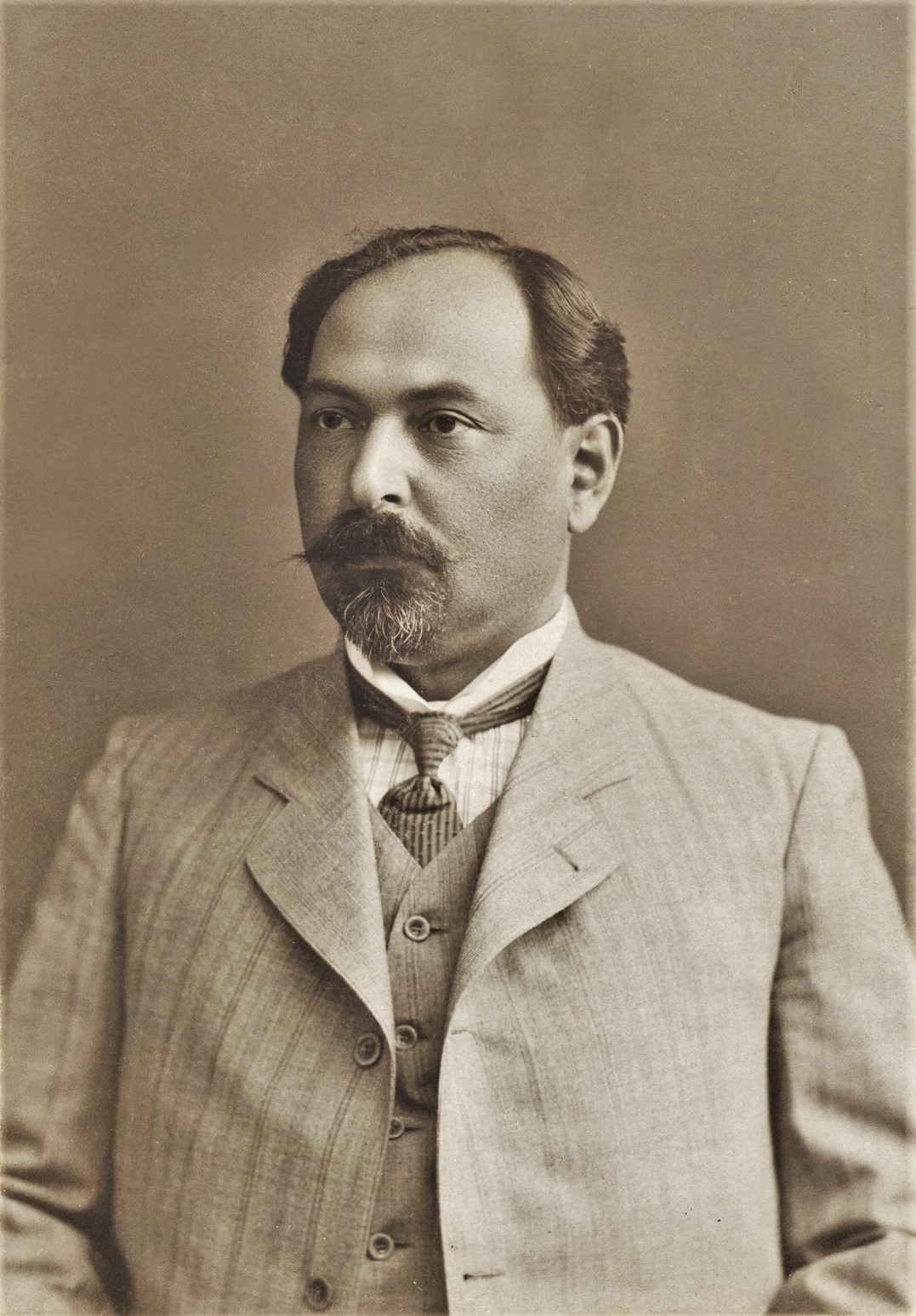
Yet the external propaganda and real actions did not coincide at all. In fact, everything was done for establishment if the bloody communist dictatorship that aimed to destroy the state system establishment and the national independent consciousness of the people. Local revolutionary committees also acted for the purpose.
For that very purpose, the Bolsheviks created new power structures in place of the destroyed national state structures in the centre and at the local levels. The first step undertaken in this sphere was the establishment of the farmers’ militia (the red militia) after the destruction of the former police. Extraordinary Commission and the Supreme Revolutionary Tribunal started operating along with the Red Militia.
The Extraordinary Commission and the Supreme Revolutionary Tribunal had unlimited extraordinary powers. Their resolutions were executed immediately. Both two structure, screened by the struggle against the counterrevolution and diversion started the termination of the leading people, especially the intelligentsia of the country, that was the carriers of the national self-consciousness and the traditions of state system establishment.
The red terror raised in all the regions of the country, everyone able to resist the consolidation of the Bolshevic regime was immediately terminated by the red terror as the enemy of the people, counterrevolutionist and saboteur.
Thus, the new genocide of the Azerbaijani people after that of March 1918 was initiated. The difference was that the second genocide targeted the prominent state officials of the Democratic Republic of Azerbaijan, generals, military officers of the National Army and famous scientists, leading intellectuals, religious workers, party leaders, politicians. At that period the Bolshevic-Dashnak terror removed the elite of national society purposely in order to leave them without control. This bloodshed was, in fact, more horrific than that of March 1918. It should be noted that all these mass carnages were committed by the Supreme Military Tribunal, Extraordinary Commission, red militia and the special department of the eleventh Red Army and the Communist Party of Azerbaijan without permission of the Temporary Revolutionary Committee of Azerbaijan. All these bodies were headed by Russian, Armenian and Georgian despots.
The bloodshed that targeted the leading sons of Azerbaijan were committed by the instruction of such bolshevik-dashnak executors as Ordjonikidze, Kirov, Mikoyab, Sarkis, Mirzoyan, Lominadze, Yegorov and others. Armenians that strengthened their positions in all the state structures of the country played a special role in the commitment of the Red Terror. Participating in the power bodies of the country they executed Azerbaijanis by shooting without investigations or trials. On the whole, nearly 50 thousand leading people of Azerbaijan were shot within a year since April 28, 1920, and the nation was deprived of its elite.
During the occupation and Red terror, Bolshevic and dashnak executers confiscated the property of those shot and not satisfied with that robbed the whole population and even the indigent and took away even the family jewels and valuable things of the people. Russians, Armenians and representatives of other nations were moved to the emptied flat of Azerbaijan The population was inflicted reprisals.
The armed forces of the country were immediately transferred under the control of the Red Army of Moscow under the shelter of the restoration of the Army and Marines. The people were deprived of their Army. Thus the independence of Azerbaijan was, in fact, destroyed.
The Bolshevic regime also tried to influence the national self-consciousness for suppressing the ideas of the national dignity and the traditions of independent state system establishment. Once the state language the Azerbaijani language was brought to bay and the training of national specialists was reduced to the minimum level. The government launched the policy of russification. The classes, class, religious and civil privileges were eliminated and the usage of such words as « bey », « khan », « agha » was prohibited. The religion was separated from the state and education. The fulfilment of religious ceremonies and lessons of shariate were abolished in the secondary schools. Religious schools were shut down. The ancient architectural memorials -mosques, minarets-were ruined. The period of attacks to the self-consciousness and national culture of Azerbaijanis started.
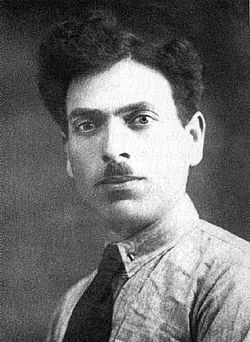
One of the principal parts of the tyranny state system was the establishment of the committee, consisting only of the poor people in the regions. These committees had to become the support of bolsheviks, to deteriorate the counteraction in villages and to help the government to remove counterrevolutionists from Azeri villages.
Soon the revolutionary and poor committees were replaced by the councils. The socialization of North Azerbaijan was completed with the session of the first councils of the Azerbaijan SSR on May 6, 1921. The first Constitution of the Azerbaijan SSR was adopted on May 19. Though stipulating for wide rights for the citizens, the constitution that took after that of RSFSR was of formal nature as the activity of the councils was regulated by the Communist Party of Azerbaijan, instructed by the Russian Party of Moscow. Moreover, the activity of all political parties operating in the country was suspended. Thus the dictatorship of the proletariat, in fact, turned to that of the party. Besides, the deprivation of the right of the country’s intellectuals to be elected to the councils, under the shelter of the establishment of the reign of farmers, turned to the instrument of governing for the Communist Party and Moscow.
Thus within a year after the occupation bolsheviks formed the state bodies as if based on the constitution and established the state socialist democracy in North Azerbaijan through the implementation of aggressive measures. In fact, the newly established democracy was a formal and a false one and was in the most real sense the dictatorship of communism compared with the Democratic Republic of Azerbaijan and its Parliament.
Yet the dictatorship depended on the one of Moscow. Therefore, the overthrow of the Democratic Republic of Azerbaijan that was a leading and secular state system standing on the similar level with other democratic republics and was one of the most worthy achievements of the nation became the hardest tragedy of the Azerbaijani people.
After the abolition of the independent state of Azerbaijani people, its national wealth was misappropriated. The special property on lands was eliminated. The whole natural wealth of the country was nationalized in other words was transferred to the state. The Oil Committee of Azerbaijan was created for controlling the oil industry and it was headed by A.P.Serebrovsky, sent to Baku by V.I.Lenin. Thus, V.Lenin achieved his aim stated in the telegram sent to the Military-Revolutionary Council of the Caucasus front on March 17, 1920, as follows « The control over Baku is too important for us. » The Baku oil was used by Soviet Russia.
The Caspian Trade Fleet, banks, operating in the country, fish industry and another field of the economy were nationalized following the oil industry. Nationalization stroked a hard blow to the economy of Northern Azerbaijan, developing with increased speed in late XIX-early XX centuries. People’s deprivation of property law caused weakening of national independence consciousness. Industry and economy were mainly focused in hands of Russians, Armenians, Jews and representatives of other nations. Resources of Azerbaijan, particularly Baku oil began to be transported to Russia. Soviet Russia overcame fuel crisis. Northern Azerbaijan became a fuel and raw material source of Russia. Besides, occupation troop, stifled Northern Azerbaijan in blood, was kept at the expense of Azerbaijan people as well.
N.Narimanov and his followers, protecting native people in the condition of mass carnages and plundering, were branded as « nationalists » and removed from the management of the country in fact. Armenian-Russian-Georgian leadership, predetermining the fate of the country, did not trust « Moslems with musavat ideas », even tried to abolish formal independence of Azerbaijan and include it into the RSFSR. But N.Narimanov managed to prevent their terrible plan. Bolshevik-Dashnak group succeeded in sent N.Narimanov away of Azerbaijan in response.
Nevertheless, occupiers could not break down Azerbaijan people’s resistance easily. Armed rebellion against the Bolshevik regime took place in Ganja on May 25-26, 1920. Ganja rebels, active members of the former National Army, defeated elements of the XI Red Army repeatedly. New divisions were brought into the town. Armenians, living in Gandja and adjacent territories, joined occupiers. Rebels sacrifice thousands of people in hard battles for every street, every house. Occupiers managed to take Gandja under control on May 31. The city was subjected to terrible genocide and plundering by occupiers and Dashnak gangsters.

Occupiers met with stubborn resistance in Karabakh after Gandja rebellion in early June. Armenian-Dashnak gangsters actively helped occupiers and organized carnage of civil Azerbaijanis.
Zagatala population began life and death fight against occupiers on June 6. The rebels got Zagatala fortress. Gakh was captured. The whole region rebelled. The rebels defeated divisions of the XI Red Army, brought into the region. By the XI Red Army, strengthened with additional forces, managed to take Zagatala under control eventually on June 18.
Strong resistance was shown to occupiers in Shamkir, Guba, Davachi, Gusar, Lankaran, Astara, Kurdistan, Javanshir, Gurgashin, Khachmaz, Nakhichevan, Ordubad, Sharur and other places following Ganja, Karabakh, Zagatala. Even women and children took part in the battles against the occupier XI Red Army in Shamkir.
The stubborn resistance of the whole country testified that depriving Azerbaijan people of independence ideas and statehood traditions was not easy.
Soviet government, seized with fear about the strengthening of the resistance movement, brought new divisions into Azerbaijan. More terrible tragedies were waiting for Azerbaijan in future.
The hardest crime, committed by Bolshevik regime against Azerbaijan people at that time, was rendering help to Armenians in their occupation policy. Bolshevik Russia continued the policy upon the formation of Armenian state at the expense of Azerbaijan territories as Soviet Russia and made any intrigue to separate Azerbaijan from Turkey.
Armenians managed to take Iravan away from Azerbaijan and declared its capital, began new aggressions during the Azerbaijan Democratic Republic. Dashnaks attempted to occupy Nakhichevan, Zangazur, Sharur-Daralayaz and Nagorny Karabakh.
Dashnak gangsters, supporting by Bolsheviks, committed bloody carnages, reduced thousands of villages to ruins. Hundred thousands of Azerbaijanis were exiled from native lands. Armenians sought whole Western Azerbaijan instead of Bolshevik power’s recognition. This deal was profitable for Bolshevik occupiers.
But this criminal policy caused strong protest most of all in Nakhichevan. Dashnaks could not occupy Nakhichevan thanks to people’s resistance and the help of Turkey.
Bolsheviks gave Sharur-Daralayaz to Armenians under the agreement, signed with them on August 10, 1920, without participation and consent of Azerbaijan. This tempted Dashnaks still more and struggle for Nakhichevan and Karabakh inflamed.
Armenians proceeded to the occupation of Zangazur with support of the XI Red Army after getting Sharur-Daralayaz. Southwestern Zangazur (Mehri) was annexed to Armenia and communication between main territories of Azerbaijan and Nakhichevan was severed.
Mehrinin işğalı nəticəsində Ermənistan, həm də, özü üçün İrana dəhliz açmış oldu. Daşnakların İranla maneəsiz əlaqə saxlamaları üçün əlverişli şərait yarandı.
Armenia opened a corridor to Iran in the result of the occupation of Mehri. The favourable condition was created for Dashnaks’ communication with Iran.
At the same time, Armenians achieved the decision on annexing of Nagorny Karabakh to Armenia under pressure of Ordjonikidze and Kirov, the executioner of Azerbaijan people, at the plenary session of the Caucasia bureau on July 4, 1921. But this decision was annulled in the result of stubborn resistance and demand of Narimanov. The Caucasia bureau had to take a new decision on the next day – July 5. Nagorny Karabakh was remained as a part of Azerbaijan with capital Shusha and given wide regional autonomy. Though Armenians could not achieve their purposes concerning Nagorny Karabakh, they strengthen their position in this region of Azerbaijan.
Nevertheless, Plans of Armenians and Bolsheviks upon Nakhichevan failed. Nakhichevan was given autonomy under the protection of Azerbaijan under the Moscow agreement (March 16, 1921), signed between the RSFSR and Turkey in the result of a decisive position of Turkey. According to the agreement Nakhichevan did not have the right to yield its status to the third state. Gars agreement (October 13, 1921), signed between Turkey and Southern Caucasia republics in summer, confirmed it once more. Thus, Bolsheviks could not give Nakhichevan, called « Turkish gates » by Ataturk, and it remained as a part of Azerbaijan forever.
It should be noted that Bolsheviks used different means to take Islam East under the influence of Soviet Russia. They declared that Azerbaijan would turn into « blooming soviet socialist republic » at the gate of the East. But Eastern states, soon understood the essence of Bolsheviks’ policy in Azerbaijan, did not succumb to deception of Soviet Russia. Therefore the formal independence of Azerbaijan has put an end. Azerbaijan, Georgia and Armenia were unified in the unit Transcaucasian Soviet Federative Socialist Republic. Armenian-Georgian leadership of the TSFSR gained favourable condition to direct economic potential of Azerbaijan, owning rich natural resources and more developed economy, to the development of Armenia and Georgia.
Thus, national and religious discrimination policy against Azerbaijan people in The Southern Caucasus legalized. The formal independence of the country was definitively put an end with annexing of the ZSFSR to the USSR on December 30, 1922. Process of plundering of Azerbaijan resources began in wide-scale.
National colonization policy strengthened and became more merciless in 1920-1030s. Azerbaijan economy was made completely dependent on the centre in the result of industrialization and compulsory collectivization. Economic policy, carried out by the centre was directed to depriving Azerbaijan of economic independence. The main purpose of this policy was to turn the republic into the raw material source and auxiliary production province.
Attacks to national-spiritual values of the people increased. Training of national personnel was preventing with different artificial hinders, any condition for the flow of Russians, Armenians, Jews and other nations was created, they were provided with proper jobs and flats in the best parts of the capital.
Russification and Armenification policy were carried out. This policy speedily developed in Baku propagated as « International » city. Russian language ousted Azerbaijan language and became the official language.
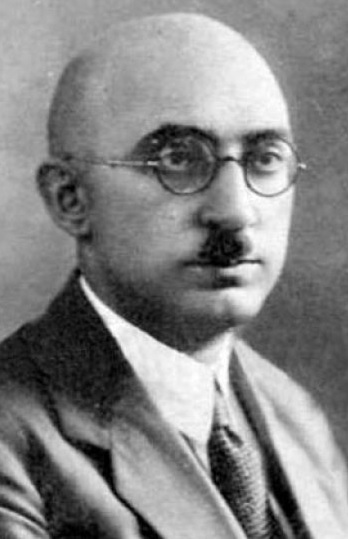
Distribution of Azerbaijan territories to neighbours was continued. Azerbaijan Central Executive Committee declared the establishment of Nagorny Karabakh Autonomy Republic (NKAR) under pressure of Ordjonikidze and Kirov, backed by Stalin, on June 7, 1923. Finally, the plenary session of the South Caucasus State Committee of the Russian Communist Party confirmed resolution on Nagorny Karabakh of June 5, 1921, of the Caucasus Bureau of the Russian Communist Party on June 27, 1923. Armenians and their Moscow supporters prepared the foundation for new territorial claims against Azerbaijan.
Armenians’ ruses related to Nakhichevan, the legal status of which was decided to the good of Azerbaijan thanks to Turkey, failed. The Nakhichevan Autonomous Republic was established within Azerbaijan on February 9, 1924. Nevertheless, Bolsheviks continued the policy of territorial expansion of the Armenian SSR at the expense of Azerbaijan lands and 3 villages of Zangilan region were given to Armenia in 1929. At the same time, Georgians seized Azerbaijan lands on the bank of the River Ganikh (Alazan).
Collectivization, taking people’s property away, the abolishment of kulak strata, carried out since late 1920, exasperated people. The country was enveloped in the resistance movement. New rebellions began in Shaki, Zagatala, Nakhichevan, Khizi, Shamkir, Jabrayil and other places.
The strong rebellion began in Bash Goynuk village, Shaki region, in 1930. The residents of Bash Goybuk, overturned soviet power in their village, attacked Shaki. The residents of Shaki joined them and power transmitted to rebels. Neighbour Zayzid village stirred up a rebellion and came to help Shaki. Divisions of the Red Army were brought into the town. Despite stubborn resistance, divisions of the regular army strengthened with new forces, captured Shaki. The population was subject to mass shooting day by day. Armenians rushed into the Central Committee, took an active part in this bloody carnage. Hard measures were taken against Goynuk rebels. They were shot right in front of the population without any investigation or court and were buried in the ditches, dug by their own. Thus, Armenians revenged upon the Goybuk residents, who hindered Dashnaks in 1918. Afterwards, these mass burial places and the grave of Turk Ahmad, one of the leaders, turned into places for pilgrimage. Bolshevik regime noted strengthening of the resistance movement and national awakening, carried out terrible repressions in Azerbaijan in the 1930s. Armenian Dashnak gangsters, come to power in Azerbaijan, began to clean the country off Azerbaijan Turks. Armenians themselves were the main executors of the « cleaning » operation.
Central and regional structures of the KGB (State Security Committee) and People’s Commissariat of Internal Affairs were in Armenians’ hand. Armenians were at the head in more than half of the regional structures of the PCIA. In this point of view, Bolsheviks continued the historical tradition of Russia and annihilated Azerbaijanis by Armenians’ hands, but applied new tactics in the new condition.
Tens of thousands of Azerbaijanis were shot and exiled in the result of false investigations under the name of « criminal cases », « courts », « exposures of public enemies ». 29 thousand worthy persons were subject to repression only At that period Azerbaijan lost such rare intellectuals and thinkers as Guseyn Djavid, Mikail Mushfig, Ahmed Djavad, Salman Mumtaz, Ali Nazmi, Taghy Shahbazi and others. The intellectual potential of people and their prominent persons were terminated. Azerbaijani people could not recover for years from this hard blow.
Armenian-Dashnak group, that headed Baku government and leadership of Armenian party acted conjointly. Like once Shaumyan and Andranok did! Armenian-Dashnak regime, backed by Stalin and Beriya and doing everything wished in Azerbaijan, returned our South Azerbaijan compatriots, residing in Baku and in North Azerbaijan to Iran.
As a result of these cruel actions, our compatriots that found refuge in North Azerbaijan to escape from the cruelties of the shah regime again became subject to persecution by the Iranian shah regime. Thus, Russian colonialists, Armenians and Iranian reaction acted conjointly against the people of Azerbaijan like in previous years. The actions aimed to establish North Azerbaijan without Azerbaijanis and later to return its lands to RSFSR. Surely, a share for dashnaks and Georgian nationalists had also been stipulated!
The repressions of 1937-1938 stroke a hard blow to the science and culture of Azerbaijan. Through that period over 50 thousand people were executed by shooting and over 100 thousand were sent to Siberia and Kazakhstan. Such prominent people as Huseyn Javid, Mikail Mushfig, Taghy Shahbazi, Salman Mumtaz was terminated.
Heydar Aliyev
Everything determining the national and moral wealth of the people was destroyed under the shelter of the establishment of culture « National in form and socialist by content ». The transfer to the Cyrillic alphabet stroke one more blow to Azerbaijan in 1939. The people which was gradually used to the Latin alphabet that replaced the old one had to transfer to a new alphabet that meant the artificial separation of people from the national and moral wealth, reflecting its historical past. At the same time, that was again discrimination policy conducted against Azerbaijan and other Turkish-Islam people. By the way, the alphabets of Azerbaijan’s neighbour country remained unchanged. The national moral values of the people were also destroyed along with mass bloodshed and repressions. The people were deprived of their roots and national and moral traditions through brands pan-Turkism and pan-Islamism. Cultural attacks against the national moral values of the people that were declared the remnants of the past such as tar and kamancha were conducted in all the regions of the country, the Society of Godless operated at that time for fighting against religion.
In the period of repressions of the 1920s-1930s the most prominent sons of Azerbaijani people had to leave the country and run abroad to escape from the KGB prisons. Most of them continued the struggle for the independence of native Azerbaijan which turned to the prison of Bolshevic-Dashnaks. The National Center of Azerbaijan headed by M.E.Rasulzade played an important role in the unification of the struggle of political migrants to a single trend.
Yet neither Bolsheviks nor Armenian-Georgian nationalists that conducted the policy of Bolsheviks on the South Caucasus could destroy ancient and rich traditions of state system establishment through cruel repressive measures and bloodshed. The democratic ideas and the habit to rule rather than to be ruled still lived in the hearts of Azerbaijani people. Azerbaijani people managed to survive even more cruel and bloody ordeals more than once. Azerbaijan, the father of Javids, Mushfigs, Ahmed Javads, did not die. It will again make its presence felt.
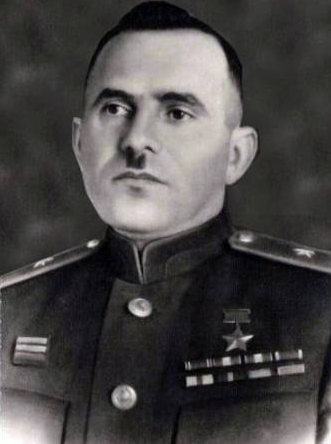
The oil of Baku played a decisive role in the USSR’s victory in the Great Patriotic War. The plans of Armenian-Dashnaks that settled in the Kremlin under the leadership of A.I.Mikoyan and tried to drive Azerbaijanis away from their houses did not come true. World War Second proved Azerbaijan people to be a heroic nation that managed to overcome hard ordeals and win the battle. The self-conscience of the people that was much hurt in a period of repressions was restored again. The hard Soviet regime and the period of persecutions conducted by the communist dictatorship did not manage to suppress creative genius and the creative talent of the people. Soon Azerbaijan became leading among all the states of USSR. A new rise occurred in the oil industry of Azerbaijan that supplied USSR with fuel. Baku turned to the oil academy of the USSR. A great number of new industrial enterprises and electric stations started operating, roads, canals and bridges were constructed at that time. Industry, agriculture and culture started to develop rapidly. The mass illiteracy came to its end. Secondary schools, research institutes, public health and culture and education centres were established in the country. On the eve of the World War Second Azerbaijan accounted for 16 high schools, 18 theatres. The establishment of the affiliate of the Academy of Sciences in 1938 was a significant event in the scientific life of Azerbaijan. The rise was registered in culture as well. In the period of the World War Second, Azerbaijani people showed great courage in the battles against fascism in the rear and in the anti-fascist movements of different European countries. At that time over 170 of 600 people taken to the military service were awarded orders, 130 people have attached to the title of the hero of the Soviet Union. During the war, Azerbaijan started the production of high-antiknock fuel on the basis of a new technology worked out by academician Yusif Mamedaliyev.
The Second World War clearly demonstrated the ability of Azerbaijani people to overcome all barriers blamelessly and to display unrivalled courage and valour.
Heydar Aliyev
Repressions targeting Azeri people continued after the Second World War. The National government established in south Azerbaijan was cruelly overthrown by the Iranian shah regime (December 12, 1945-June 14, 1946). All democratic reforms conducted by the National Government of Azerbaijan were annulled.
Significant progress was registered in different spheres of industry and agriculture within the first five years following the war. New steps were taken for the development of culture. Baku oil played a great role in the development and rehabilitation of USSR economics. Owing to Azeri specialists oil fields were discovered and put to operation in Tatarstan, Bashkiria, Tumen and other regions. Representatives of Azerbaijani people took an active part in the restoration and development of the economics of the Soviet Union. The new stage of driving Azerbaijanis out from their historical land West Azerbaijan (called Armenia SSR) started again in 1948-1953. Armenian nationalists encouraged by Stalin, Beriya and Mikoyan, governing from the Kremlin, again inflicted reprisal to Azerbaijani people and strengthened their position in West Azerbaijan. They dominated these lands.
HEYDAR ALIYEV AT THE HEAD OF THE STATE:
THE FIRST PERIOD TURNING POINT TOWARDS THE INDEPENDENCE AND BEGINNING OF NATIONAL AWAKENING (1969-1982)
Despite the important successes Azerbaijan achieved due to the creative will of the people, in the 1960s one could notice a certain regression in many spheres of the economy, both in industry and agriculture, caused by the subjective and the objective facts. The Republic was gradually weakening and this found its negative reflection in the social life of the people. Azerbaijan remained behind the Soviet Union for the general exponent of the production, especially that of industrial production, for the amount of the national income and the rate of labor efficiency augmentation. The process was constantly on. The condition of agriculture was unbearable. There was nearly no application of scientific-technical achievements.
The 60s of the 20th century might be evaluated as the period of deep and long crisis for the economy of Azerbaijan. We needed to think over the alternative, to find out new conceptual methods of approach for the development of the economy, to carry out serious structural reforms in agriculture, and apply new methods for industrial and economic stimulation.
Heydar Aliyev
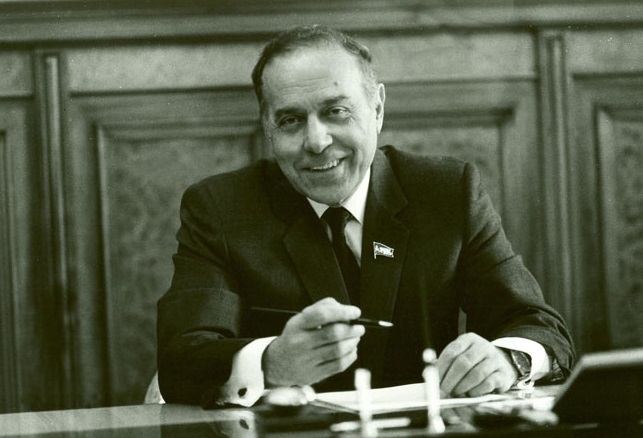
In 1969 Heydar Aliyev came to the head of Azerbaijan and gave start to the first period of his leadership. To make Azerbaijan one of the progressive states of the Soviet Union, in the complicated period of the totalitarian regime, the great fanatic of his people Heydar Aliyev started a program of extended reforms in all the spheres of life.
For more than 50 years the 20th century Azerbaijan witnessed the personality and the activity of Heydar Aliyev. HEYDAR ALIYEV IS THE FOUNDER OF A NEW AZERBAIJAN. His building activity has started earlier than in 1969. In the 40s of the 20th century, Heydar Aliyev started to work at remedial organs of Azerbaijan and despite the obstacles created on his way, he raised to the position of the chair of Azerbaijan State Committee on Security-the main support of USSR in Azerbaijan. Under his intensive and efficient activity during that period, the State Committee on Security made important steps to clean our country of enemies and collected the deserved people for the activity at the Security Services.
The staff of the State Committee on Security (SCS), full with the Armenians and the representatives of other nations since the 20s-30s of the 20th century, the author of the bloody repressions against our people was fully replaced with the Azerbaijanis by Heydar Aliyev. Each Azerbaijani should realize and never forget that after the March genocide of 1918 dashnaks participated in the Soviet occupation of 1920. Next time dashnaks murdered our people under the mask of the Soviet builders. They took important chief positions at the State Committee on Security and (SCS) and the National Commissariat on the Internal Affairs (NCIA). Under the false name of « crimes » Armenian ‘chekists’ carried out mass repressions against our people in the 20s-30s of the 20th century, murdered the prominent representatives of Azerbaijan such as Javid, Mushfig, and others. So involving patriotic and honorable Azerbaijanis into SCS was not an ordinary fact; this policy prevented our people from the following pursuits.
I am the witness of the national fanaticism of Heydar Aliyev in the implementation of such an important act.
…In the early 60-s, I was a student of the faculty of the History at Baku University. I was the secretary of the Komsomol organization of the faculty. After Nikita Khrushov came to power, he started the company against China. A talented second-year student protested it with leaflets. SCS started to study the affair on him. We all worried. I was ordered to hold a close meeting of comsomols of our faculty. At the assembly hall of the former building of the University (today- the building of the Institute of the Economy), we held the meeting of Komsomol’s. Heydar Aliyev(he didn’t occupy a high position at that time) participated in the meeting. He took the chair and made a speech full of advice to the youth. Then followed disputes and ‘Komsomol critics. Everything was smooth at the beginning of the meeting. All the speakers determined beforehand criticized the student and then asked for his ‘forgiveness’. I was about to close the meeting that our rector, under the influence of the previous speeches decided to hear the opinion of other students. I was obliged to do obey. Hands raised up one by one and the meeting excited. The students began to criticize the existing regime. When we were in desperate Heydar Aliyev again took a chair and advised the comsomols to assume the reeducation of their mate. He got us out of a tight spot. We all admired his courage!
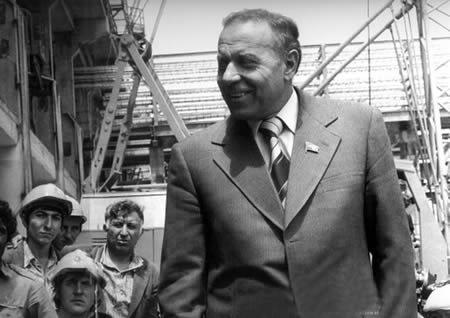
The late 60-s of the 20th century gave start to a new period of Heydar Aliyev’s activity. In 1969 when deep decay surrounded all the spheres of life in Azerbaijan SSR, Heydar Aliyev was chosen the First Secretary of the Central Committee of the Communist Party of Azerbaijan and shouldered the control of the state. The history of Soviet Azerbaijan witnessed the period of turn. Further historical development proved, that laid the foundation of today’s independent Azerbaijan at that time.
Heydar Aliyev had full knowledge about all peculiarities of the Soviet Regime. Having wide management experience, he decided to take decisive steps. He ordered to prepare complex development programs for long-term, dynamic and thorough development of the state and immediately started their implementation. Heydar Aliyev gained people’s support from the very beginning. Azerbaijan witnessed the PERIOD of HEYDAR ALIYEV. Heydar Aliyev started the policy of progress using rich economic potentiality and extended facilities of the Soviet Union.
Great politician raised the questions on different spheres of the economy (as well as the agriculture) and culture so important for the development of his people, firstly at the Political Bureau of the Central Committee of The Communist Party of the Soviet Union, at the plenums of the Central Committee and the sessions of the Communist Party. Then he achieved their confirmation and mobilized our people to the execution of those decisions. His struggle for Azerbaijan’s development continued day and night. He wanted Azerbaijan to freely provide itself, be capable for independent life, highly developed in scientific and technical sphere country (or as with that time term ‘administrative-economic unit’). In a word, Heydar Aliyev stood at the head of the way leading to the Independence of the country.
During his leadership, Heydar Aliyev managed that the Soviet government adopted 5 main decrees for the benefit of the thorough development of Azerbaijan and supplied their implementation. Azerbaijan focused all its power on its own development. The period between 1970 and 1985 turned to be the brightest period of the reformation in the history of Soviet Azerbaijan. One could witness progress in all the spheres of the economy and agriculture. The economy of the Republic exercised important structural changes, such as the creation of new and progressive spheres, development of in the sphere of scientific research. The application of scientific-technical achievements and modern technologies to the process of production took Azerbaijan to the first position in the USSR. The quality of production highly rose.
Prescient policy and professional management took Azerbaijan to the most advantageous agricultural state in the Soviet Union. Azerbaijan also distinguished for cotton-growing and vine-growing. The social-economic position of the farmers considerably improved. The province was enlivened with constructive and renovation works and cultural reformation.
The period between 1970 and 1985 are the brightest moments in the history of Azerbaijan reformation. The 9th, then 10th, and the 11th 5-year period occupy a particular position in the History of Azerbaijan for the amount of changes, the character of carried out deep structural reforms in economical and social spheres, improvement of financial conditions of the people
Heydar Aliyev

Hundreds of plants, factories, and other production swatches established over the whole republic during 1970-1985. 213 great plant facilities started to function. In many important industrial spheres, Azerbaijan won first place in the Soviet Union. 350 kinds of products made in Azerbaijan were exported to 65 foreign countries. The amount of industrial production for these years was equal to the previous 50 years period. During those 50 years, Azerbaijan was a great construction square. Baku and the regions of the republic were completely changed.
Hundreds of dwelling houses, hotels, social apartments, schools, culture houses beautifying Baku and Azerbaijan regions today, factories, plants, huge industrial objects, great production complexes, water reservoirs, pools, Kur water pipeline, green zones, roads, Baki-Balaken railway relating the capital and north-west of the country, railway in Khankendi and other works carried out to relate Nagorny Karabakh with Baku and to re-establish there Azerbaijan traditions. All the abovementioned is the result of Heydar Aliyev’s constant activity and fanaticism to his Motherland.
One of the achievements of Azerbaijan from 1970 until 1985 was establishing trained personnel, as well as specialists on rare professions for future support of the people. Coinciding quick and multilateral development of the economy during that period it was necessary to extend the system of high and professional education. 3500 younger Azerbaijanis were sent to 170 advanced schools of the USSR. Each year about 800 students were sent abroad to Azerbaijan. military education was under particular attention. The absence of Azerbaijani representatives at the center of space flight training of the USSR made Heydar Aliyev take under personal control training of youth at high schools for pilots.
…I remember it well. It was the late 70s. I was invited to the usual conference held at the Central Committee concerning entrance exams to high schools. After the minister of education and rectors of several high schools, Heydar Aliyev invited to word the chief of the General Forces Commanders School. His question was about the quantity of local (Azerbaijani) students. The answer of the chief dissatisfied Heydar Aliyev-the quantity of Azerbaijanis interested in military education was very few. Heydar Aliyev criticized the chief of the General Forces Commanders School and gave him concrete orders. The next year I participated at the same conference again. The chief of the General Forces Commanders School was again invited to the word. Heydar Aliyev was interested in the percents of representation of the native people. Despite the fact that there was some progress in the affair, the president still remained dissatisfied. I still remember the words of the great politician: « We should send native people to pilot schools. We should train pilots. Another day I interested in the composition of the team of cosmonauts. The fact dissatisfied me that there was no Azerbaijani in the staff. They said that only the graduates from the pilot school might be included in the team. After some investigation, it was revealed that no Azerbaijanis were represented at pilot schools of the USSR. What are you busy with ?! »
Those matters having strategic importance were personally controlled by Heydar Aliyev. THE GREAT AZERBAIJANI passed ahead the time and founded professionals for 21st century Azerbaijan.
As a result of programs of complex development carried out by Heydar Aliyev in the early 70s-80s of the 20th century turned into progressing industrial, agricultural, and cultural republic in the great USSR, which was regressing. Heydar Aliyev achieved all this by his wise policy.
The best result of Azerbaijan in the Soviet period is that established at that time economic, scientific-technical and cultural potential formed the stable base for the complete independence of our republic.
Heydar Aliyev
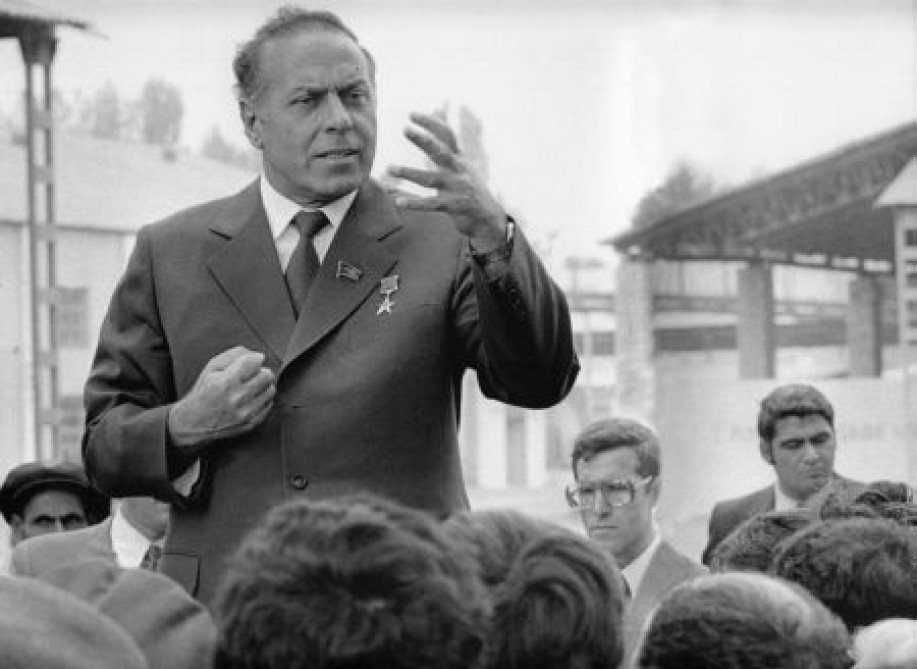
Heydar Aliyev foresaw our independence at that time and got his people ready for these days. The great genius started to form today’s Azerbaijan then.
During the period of domination of the Communist regime, the prominent public official Heydar Aliyev started the struggle against injustice towards his people. Nobody but him was in power to do it. Troubles that his people suffered in the regime of the Kremlin he met with prescient and courageous measures carried out particular importance for the future of Azerbaijan. He founded the monuments of great Azerbaijanis in all the parts of his motherland, returned Javid, the victim of the repression, to his motherland many years after his death. In honor of thousands of Azerbaijanis who died in Kerch and Crimea, he raised the monument near Sapun Gora…
In the years of Heydar Aliyev’s leadership in Azerbaijan, a large group of prominent artists of Azerbaijan-the poets, the writers, the composers for the first time was awarded the honored name of the Hero of the Socialist Labor.
He also put the monument for Nariman Narimanov — the great fanatic of his people put in the forefront in Moscow and later killed under the strange circumstances, stamped as a ‘nationalist’, to mention the name of which had been prohibited. Later he achieved to put N. Narimanov’s monument in Ulyanovsk and proved that nothing, even the soviet regime could destroy the feeling of the fanaticism in him.
During the leadership of Heydar Aliyev (late 60-s early 70-s of the 20th century) the past of Azerbaijan also turned to an interesting point in the history of our development; one could notice moral-national awakening in people life. This process has found its reflection in the Azerbaijan Encyclopedia published under the editorship of the great intellectual Rasul Rza. The chief editorship of the encyclopedia and most of the scientists gathered around it were distinguished by their courageous speech. The decisive role of Turkic ethnic groups in the formation of our people, particular role and objective evaluation of the figures of the Democratic Republic of Azerbaijan, the occupation of April 1920, and other matters were rose by the Encyclopaedists. With the help of Rasul Rza, I managed to issue the maps on Azerbaijan history at the map factory in Kyiv. The chief editor staff of the Encyclopedia published atlas — the maps of Azerbaijan SSR'(in Azerbaijani and Russian) under the editorship of Rasul Rza in 1972. The abovementioned historical maps have been included in the atlas. But native traitors informed Moscow about it and drew the attention of Armenian historians. They brought L.S.Shaumyan to Baku. L.S.Shaumyan was the son of S. Shaumyan famous author of for March 1918 genocide against our people to stamp us as « nationalist », « bourgeois ideologists », and « the enemies of the Soviet power and Russia ». L.S.Shaumyan, the first deputy of the editor in chief and one of the heads of the Soviet ideology, tried to use the situation against the Azerbaijan people. Thanks to the wisdom and courage of Heydar Aliyev he failed, all the Encyclopaedists and the majority of the intellectuals were saved from pursuits of SCS and the punishment of the party.
The historical importance of all the reformation works carried out in the first period of Heydar Aliyev’s leadership in Azerbaijan is that they awoke the feelings of national pride, national consciousness, independence, and freedom in our people. All that meant a new step in the movement of Azerbaijan people for independence in the 70s of the 20th century. There is no need to prove the close logical relation between today and the previous activity. Facts do it better!
One of those facts is that in the period of destruction of the world socialist system and the great Soviet empire Azerbaijan SSR was the second to survive in the union of the USSR thanks to its high level of development and multilateral economy.
Today we can say that state sovereignty and economic independence of Azerbaijan, systematically progressed foreign economic relations, deep integration to the world economy base on the the potentiality of the national industry founded in 1970-1985.
Heydar Aliyev
The next merit of Heydar Aliyev before his people is that North Azerbaijan has already been ready as an independent state when « the constitutional Act of State Independence of the Republic of Azerbaijan » was adopted in October 18th, 1991.
REBIRTH OF STATE INDEPENDENCE IN NORTHERN AZERBAIJAN: THE SECOND PERIOD OF HEYDAR ALIYEV’S RULE IN AZERBAIJAN (1993-2003)
In recent history at the helm of Azerbaijan stood a powerful politician. He was one who easily unravelled all of the tricks and deceitful plans of enemies understood political loops that confused others, one who was ahead of his time for decades and centuries for his political wisdom and easily saw what happened behind thick political walls. This politician was Heydar Aliyev. Only his personality could resist the trickery and modern weapons of our historical enemies that have repeatedly drowned our people in blood.
THE GREAT AZERBAIJANI, A DESPERATE FANATIC OF AZERBAIJAN

Well on its way to entering into the world community with successful internal and foreign policy, Azerbaijan experienced the most honourable and difficult period of its history — the period of transition. All people and countries with moves toward modern progress have passed this exam; each characterized with their peculiarities and difficulties. Azerbaijan’s transition was complicated by the invasion of the important portions of its land, by 1 million refugees and IDPs within a population of a total of 8 million.
The everlasting enemies of Azerbaijan did their best to prevent the Republic of Azerbaijan from a free existence and created obstacles on its way to achieving the level of other highly progressed states. The independence and strengthening of Azerbaijan in the role of the « gold bridge » between Europe and Asia, Russia and countries of the Near and Middle East contradicted their plans. Modern Azerbaijan turned to a cross-point of interests of the great international powers of the world. Rich with full underground and aboveground resources, independent Azerbaijan is constantly exposed to political, military, economic and moral pressures. Those obstacles will always appear along the way.
The « Armenian card » of the shrewd enemies exercised on the Azerbaijan people for centuries have never been so actively and widely used before. Armenian lobby functioning in Russia, France, the USA and other states as well as within international organizations is much stronger today. It possesses powerful means, important positions and great financial support to influence the parliaments and military-political governments of those states, also the activity of some powerful international organizations; influences the foreign policy of the countries it supports, as well as the international organizations and prevents Azerbaijan from improving relations with them.
The tactics to destroy Azerbaijan from the inside, to create ethnic and civil confrontation among its people, to establish religious divisiveness have never been so systematically used before.
Never before have native traitors — « axe with a native handle » (idiom) teamed up with and served for foreign enemies to rob the wealth of the country and to occupy high positions within its territories. As much as their servants hired for foreign countries, pseudo-informers against their country and people, did their best to gain foreign sympathy.
And never before has Azerbaijan become the central point of great interests and opposition.
In addition to all of the abovementioned, the liberty of Azerbaijan means the awakening of this great nation having a rich, ancient history and a long history of a powerful state system establishment. Awakening of the feelings of historical ownership of the piece of the land by piece robbed from the motherland, beginning of the fair struggle for the re-establishment of the justice and national and moral unity — all this means the beginning of the NEW AZERBAIJAN RENAISSANCE. The gradual strengthening of the independence of Azerbaijan is powerful support for rising up, unification and assertion of the rights of the 60 million Azerbaijanis spread out all over the world. The enemies, that once shared our lands among themselves, are troubled over the abovementioned facts.
The enemies of Azerbaijan were mostly bothered with the fact that, drowned in so many problems, Azerbaijani people were ruled by one who easily unravelled all the tricks and trickery plans of the enemies, understood the political loops that confused others, one who was ahead of his time for decades and centuries for his political wisdom and easily saw what happened behind thick political walls. This politician was Heydar Aliyev. Only his personality could resist the trickery and modern weapons of the everlasting enemies of our independence in different historical periods which repeatedly drowned our people in blood.
The enemies of Azerbaijan realized that the time was not 1918-1920s. It is our turn to win. For the struggle for independence of Azerbaijan, the establishment of a new life was led by the personality of Heydar Aliyev. God gave a chance to Azerbaijani people sending us the right personality at the right time.
The personality of Heydar Aliyev is an unrevealed world. This rare genius can be compared with an endless ocean. God endowed him with the talent to find out the right way from unexpected situations. All of the abovementioned caused by the fact that Heydar Aliyev was THE GREAT AZERBAIJANI and a fanatic of the people and the country of Azerbaijan. This rare peculiarity characterized Heydar Aliyev in all of his activities.

Heydar Aliyev was born to an ordinary Azerbaijani family of workers. He is characterized as a person of great talent, thoroughly aware of the problems of his people, witnessed the tricks of the ‘neighbours’ in his youth, a man of perfect education, of deep knowledge of history, wide-outlook and concrete knowledge, with a deep love for his people and country. He had the experience of more than 50 years of rule; was aware of the fine points of ruling systems of a different character and level, a son of a little nation in the Soviet area raised to the level of a leader in covering 1/6th of the world; USSR. Gorbachov’s prosecution and tricks did not scare him. He was a man of strong will and great personality respected by the great leaders of today. And most important, he was the national leader sent by God to save our people from the difficulty of a period of transition.
The activity of the prominent public official Heydar Aliyev in Moscow in 1982- 1987 proved to be a man of iron will. In this period, he was a member of the Political Bureau in the USSR government and occupied the high position of the first chair deputy of the Council of the Ministers of the USSR. In the Kremlin regime, subordinated to velikorus (Great Russia) chauvinism and the psychology of the great state system as well as in the system of persecution and discrimination caused by this regime, he proved that nothing could resist his everlasting talent of state leadership. Heydar Aliyev succeeded in ruling over the most problematic spheres of a regressing great empire and achieved great authority in all of the USSR. He was the only one in the Political Bureau to rule the Soviet state and to prevent the regression of that time. Thus the leaders of the Kremlin, especially M. Gorbachov considered Heydar Aliyev to be a serious opponent. During his leadership in the Soviet period, Heydar Aliyev always kept the development of Azerbaijan as a major priority. The great son of Azerbaijan was the obstacle also regarding Armenian militarists who tried to separate the Nagorny Karabakh from Azerbaijan. That was why the « tool » of Armenians since Stavropol-M. Gorbachov achieved his aim: Heydar Aliyev was estranged from the government of the USSR. It was the worst stab in the back for our people in the period of the Soviet government. Soon Armenian militarists supported by M. Gorbachov started their activity towards the invasion of the Nagorny Karabakh from Azerbaijan. Heydar Aliyev received « stabs » from Moscow and the traitors of Azerbaijan.
The Kremlin regime with M. Gorbachov at its head implemented the persecution against Heydar Aliyev in 1987-1990. As always, Heydar Aliyev continued his attempts to find ways out for his people in the period of Soviet regression and focused all of his experience on the salvation of Azerbaijan from this deep crisis. Obedient to Moscow, unskilled leaders of that time and deceitful policy carried out by them deprived Azerbaijan people of the mental potentiality of that genius.
THE WINNER OF THE STRUGGLE FOR INDEPENDENCE. THE SAVIOR OF AZERBAIJAN STATE
Time passage between the First and the Second periods of Heydar Aliyev’s ruling, the period of the anarchy were the years of regression for our country. The years between 1990 and 1993 were those of survival. Deceitful leaders of our country and followed them unskillful regime of ‘the National Front of Azerbaijan’ faced our country with downfall; Azerbaijan was about to disappear from the map of the South Caucasus. On the 21st of January 1990 (the next day after the tragedy of January 20th ) under the risk of his life, Heydar Aliyev came to the permanent membership of Azerbaijan in Moscow to express his regret and demanded punishment for mass annihilators and thus he started the struggle for independence of Azerbaijan people.

The great politician supported his people in their worst days and came back to his country on July 29th 1990. In Baku he faced with humiliation; he was prohibited to remain in here. Two days after his arrival in Baku he had to leave for native Nakhchivan on July 22nd 1990. Heydar Aliyev led the movement for independence of Azerbaijanis from Nakhchivan, which was in the military-political and economic blockade by Armenians and Russian soldiers. Nakhchivan was deprived of any contact with Azerbaijan. The position of Azerbaijan was complicated by the chair-struggle of that time leaders and our lands including Nakhchivan, where the fate of all the country had been decided were under the danger of occupation. In such a difficult situation that Heydar Aliyev’s political genius and wisdom with the help of the struggle of the Nakhchivan people, could show the way out for Kengerly people. Armenians failed to occupy Nakhchivan.
Our history witnessed many dark pages: unsuccessful Karabakh war, betraying of our sacred lands to the enemy in exchange for power, preventing from the ruling of Heydar Aliyev, saved himself from « Kremlin puzzle » where Narimanov was once killed, efforts to keep him out of the power in Nakhchivan. A question arises: -Could everything be so tragic if he led the government at that time?
During his residence in Nakhchivan, Heydar Aliyev revived national state system traditions, deleted the terms ‘soviet’ and ‘socialist’ from the name of the autonomous republic, adopted the three-coloured flag of the Democratic Republic of Azerbaijan as the state attribute, gave a political evaluation to the abolition in January 19-20th. Besides the abovementioned people of Nakhchivan rejected to participate in the referendum on retaining the USSR, local organs of the Communist Party in Nakhchivan had been liquidated; December 31st declared the Day of Solidarity of all Azerbaijanis in the world and separated and blocked Nakhchivan released from the enemies.
Again the question arises: What happened in Azerbaijan when Heydar Aliyev was far from the motherland?
The real picture was as follows. On the eve Heydar Aliyev came back to the ruling, Azerbaijan lived the most terrible period of its history. Suffered losses, betrayals, parricide, sell off the lands in the exchange of the post. All these turned to be usual. Anarchy embraced the country. Armed gangster groups dominated in provinces, regions and separate districts of the capital. The sound of firing bothered and scared people. As soon as the situation complicated the unmanageable leaders of that time left the ‘scene’ on always-ready plains. A group of careerists robbed people of wealth gathered during the Soviet period. There was no hint to the existence of the state. A group of ‘work rests’ unaware of rules of government and behaved only under the instructions coming from abroad, raised Azerbaijan to the level of national tragedy. The civil war and ethnic confrontations approached. The front was free for the enemy. Azerbaijan was losing its authority in the world. All the hopes were exhausted. The most terrible fact was that native traitors united their powers with the enemies abroad. Dashnak’s dreams of ‘Great Armenia’ and enemy plans prepared in neighbouring capitals on the deletion of Azerbaijan from the Caucasus map were on their way to realize. Azerbaijan was on its way to being ethnically broken. The village of Navahi, near Baku, have already heard the first shots calling to the civil war, blood had already been shed…
Heydar Aliyev was in the power to change this terrible picture. Thanks to the will of the Azerbaijan people, a great politician of the world was brought back to the head and crated an obstacle on the way of the enemies. The return of Heydar Aliyev in June 1993 was the conclusive point for Azerbaijan. The wise political leader prevented civil war and destroyed the plan of internal and foreign enemies concerning the liquidation of Azerbaijan. He undertook the government of the state. The danger and tragedy passed by our Motherland and the people. The struggle for independence took the direction of the victory.

What was his next step? And why June 15th 1993 is the day of Salvation? Let us ponder over:
Independence is the most valuable wealth for a citizen and for the whole people. For many years we struggled for our independence and had thousands of martyrs. Achieved independence is much difficult to preserve. No independence is achieved without a strong and powerful state. People without a state are doomed to destruction. For us, the state of Azerbaijan is a matter of life and death.
The great merit of the president before our people and history was that he preserved the state system of Azerbaijan in the period of sharp geopolitical contradictions for owning of our lands and saved Azerbaijan from destruction. Preservation of the state means the preservation of independence; means Salvation!
The encroachments of October 1994 and March 1995 did not confuse the state of Azerbaijan and the obstinacy of President Heydar Aliyev. He proved himself as a president devoted to his oath and ready to die for the independence of his people and Motherland. Our people regained their self-reliance and high spirit, witnessed stability and peace.
As the great statesman, Heydar Aliyev’s second historic achievement was stability. Genius politician, relying on his power and experience proved devotion to his words: « The state independence of Azerbaijan will be eternal, unbreakable and firm… »
He occupied the right position in the problem of war. Taking into consideration the power, the plans of the enemies and their international supporters, analyzing the dangerous situation in which Azerbaijan has been involved, Heydar Aliyev evaluated the situation. He achieved seize-fire and thus save our gene pool, preventing Azerbaijan from the waste of young and healthy forces.
Heydar Aliyev recommenced the ancient and eternal name of « Azerbaijan » over our land, people and language and Islam-Turkic unity, disappeared the risk of an ethical clash.
Azerbaijan witnesses gradually rising respect and authority in the world. Azerbaijan is recognized as a democratic, legal and secular state by the whole world. Our Constitution-the basic law is the work of Heydar Aliyev’s mind and one of the most democratic and perfect Constitutions of the world. Carried out internal reforms and stability in our country positively affect the extension of international relations. The Republic of Azerbaijan bases its foreign policy on the principles of equality and mutual interests. Thus it is an open country to all the countries of the world.
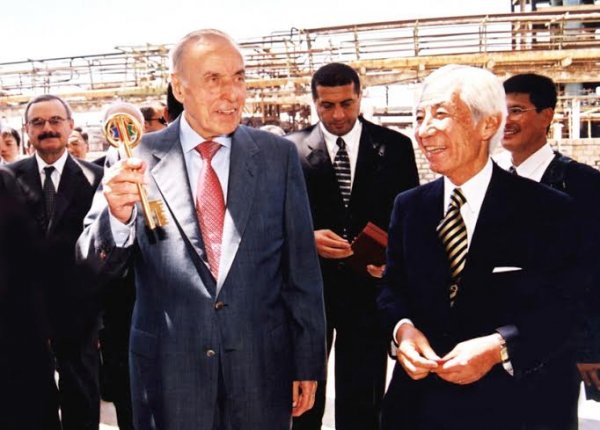
The best achievement of president Heydar Aliyev in foreign policy was that he re-established traditional friendship relations with Kazakhstan, Uzbekistan, Kyrgyzstan and Turkmenistan and the completely Turkic world. The Republic of Azerbaijan is an equal member of the Turkic state’s family and Heydar Aliyev awarded the name of the wise leader, Ataturk of the modern world.
Independent Azerbaijan is gradually gaining authority in the Muslim world.
The Azerbaijan Republic is a member of the international unities and organizations. We may be proud of successful reports at the worthy international assembly of CE made by the well-deserved successor of Heydar Aliyev’s policy Ilham Aliyev and with the superiority over Armenian militarists of deputy group led by him.
The international authority of the Azerbaijan Republic is also proved by the fact that Ilham Aliyev was elected the Bureau Member and the vice-president of the Parliamentary Assembly of the Council of Europe.
Against the « Armenian card » historically used by our traditional enemies to defeat Azerbaijan, president Heydar Aliyev applied the oil strategy, which is stronger than the « Armenian card » in the solution of the Caucasus problem. Today prescient politicians understand the power of the oil strategy against « Armenian card » and the Armenian lobby. The near future will prove to us the deep essence of this policy worked out by Heydar Aliyev.
Only future generations will witness the importance of the product of Heydar Aliyev’s intellect, the work of his tense and insistent activity — Baku-Tbilisi-Ceyhan oil pipeline (to be explored in near future in spite of the obstacles put by foreign and internal enemies) and Baku-Erzurum gas line for the countries of the region and Turkish world.
The supposed amount of infestations on these contracts is about $50 billion and only in the successful implementation of all those contracts. It is surely a great amount. The investment in oil and gas production up today comprises about $50 billion. The planned amount of the investment for the construction of the Baku-Ceyhan oil pipeline is about $ 2.5 billion and for the construction of the Baku-Erzurum gas line is about $ 1billion. In the case of successful exploration in the fields supposed by 21 contracts, we may expect a soon increase in the investments. So the investment of about $ 50 billion will be corrected depending on the situation.
Ilham Aliyev
Against forces pressing the Azerbaijan Republic from the north and the south and prevented it from traditional relations with foreign countries, Heydar Aliyev opened the East-West corridor. To release Azerbaijan from economical blockade he revived the Silk Way. World politicians highly appreciated his policy and at the same time, it worried Armenians. The international conference held in Baku in the famous palace ‘Gulustan’ on the 7th and the 8th of September 1998 with the participation of 32 states and members of 13 international organizations, was a great achievement of the foreign policy of Azerbaijan. The revival of the great Silk Way has a great role in the economic-moral awakening of Azerbaijan and the completely Turkish world.
The great politician of our time Heydar Aliyev led his people through difficult crosses of life and could supply its safety up till today.
There is not any foreign soldier or military base on the territory of Azerbaijan today.
Azerbaijan plays an important role in support of peace and stability in the Southern Caucasus.
Azerbaijan takes active and regular participation in the international struggle against terrorism.

The strategy of Heydar Aliyev concerning the Caspian Sea is successfully implementing even today. To achieve all this at the cross of the international interests, as well as the interests of the great states and bordering countries, the country of important military-strategic position and rich resources- in Azerbaijan is beyond the powers of any politician.
The best merit of Heydar Aliyev for his people in the sphere of foreign policy was normalizing the relations between Russia and Azerbaijan, once spoiled as the result of bloody abolishment carried out by great military forces led by M.S. Gorbachov and Armenians or their supporters in January 20th 1990 in Baku. The historical friendly relations between Azerbaijan and the Russian people re-established thanks to political wisdom and mutual efforts of the presidents Heydar Aliyev and V.V. Putin. Today’s Azerbaijan positively appreciates the extension of multisided friendship relations with its northern ‘neighbour’.
Anytime and everywhere: in country-wide receptions, the meetings of the international level and high-level negotiations the president of Azerbaijan popularized Azerbaijan truth. Today Azerbaijan destroyed the international information blockade once used against it. The world accepts Azerbaijan truth thanks to Heydar Aliyev’s careful activity, national fanaticism and love for his Motherland is a GREAT AZERBAIJANI.
Heydar Aliyev collected a group of progressive youth from different regions of Azerbaijan, who got their education at high schools of Moscow, Leningrad and other cities under his care, focused on the Apparatus of the President and different state structures, trained them and prepared for new powerful Azerbaijan of the future.
The president of Azerbaijan missed no process that happened in Azerbaijan. The most important events he took under his own control, thus implemented his duty with « accuracy of the jeweller ».
…The late June 1994. Separatists under the defence of foreign enemies and native traitors showed themselves in Balaken. With the initiative of the leader of the state, a group of intellectuals left for Balaken. We spent the night in Zagatala, for we have left Baku very late. Early in the morning of the next day, we were in the house of Balaken executive power. We look forward to meeting with people. The head of the executive power was waiting for the ‘guests’ from the Russian Federation (Dagestan). Waiting for officially uninvited by the state ‘guests’ was a sign of negligence for us. We were dissatisfied with such strange behaviour. About 11 o’clock in the morning, we received a call from the government and demanded the state representative from Baku and the head of the executive power to be near the phone. We were waiting for the call of the President. At that time Heydar Aliyev took under his control a very important problem of the country…Being in the hot spot of dangerous events I was for the next time assured and proud that Azerbaijan had a leader. Heydar Aliyev, the author of the words « The state independence of Azerbaijan will be eternal, unbreakable and firm… » is a man of his word; we are saved…
The historical merits of Heydar Aliyev before his native people are endless.
We have a difficult aim: to study and analyze all of his works and correctly present them to the future generation. The historian cannot manage it! This is the work of special research workers and the future. I want to address my contemporaries: Azerbaijan is witnessing a troublesome period of transition different from others. How many great forces are taking notice of our land? How many else are taking notice of our resources and oil? Could a little state have so many enemies inside and abroad? We should remember the experience we gained, bloody movements for independence, the reality of the modern world and the experience of other people: the only way out in the period of transition is a strong individual.
Let us confess that all the progressing people, nations and states of today had great individuals such as Ataturk, Washington, Bismarck, Nehru, De Goll, who showed the way in such a difficult period. Heydar Aliyev was one of them. The time will show it to Azerbaijan people and all mankind.
The 90s of the 20th century is an unforgettable page of Azerbaijan history-‘the Movement for Independence’. Heydar Aliyev was at the head of this movement. As the winner of the Movement for Independence, the great person remained in history as a genius. He that is born to be hanged will never be drawn.
Today at the beginning of the 21st century modern Azerbaijan succeeds in the establishment of the democratic, legal and secular state. The worst remained behind and turned into history. Azerbaijan has once forever saved itself from the enemies and looks forward — to the future thanks to the « Ataturk » of our people — Heydar Aliyev.
Modern Azerbaijan, as well as 60 million Azerbaijanis of the world, are on their way to revival under the leadership of Ilham Aliyev – the well-deserved successor of the way of the world genius — Heydar Aliyev’s way. We are waiting for the renaissance of Great Azerbaijan.
THE SUCCESSOR OF HEYDAR ALIYEV’S WAY
Today Azerbaijan is led by Ilham Aliyev, a worthy follower of the path of Heydar Aliyev. Heydar Aliyev’s politics lives on and wins in Azerbaijan. Expressing the will of the Azerbaijani people, Ilham Aliyev is the president of independent Azerbaijan and the leader of the world’s Azerbaijanis.
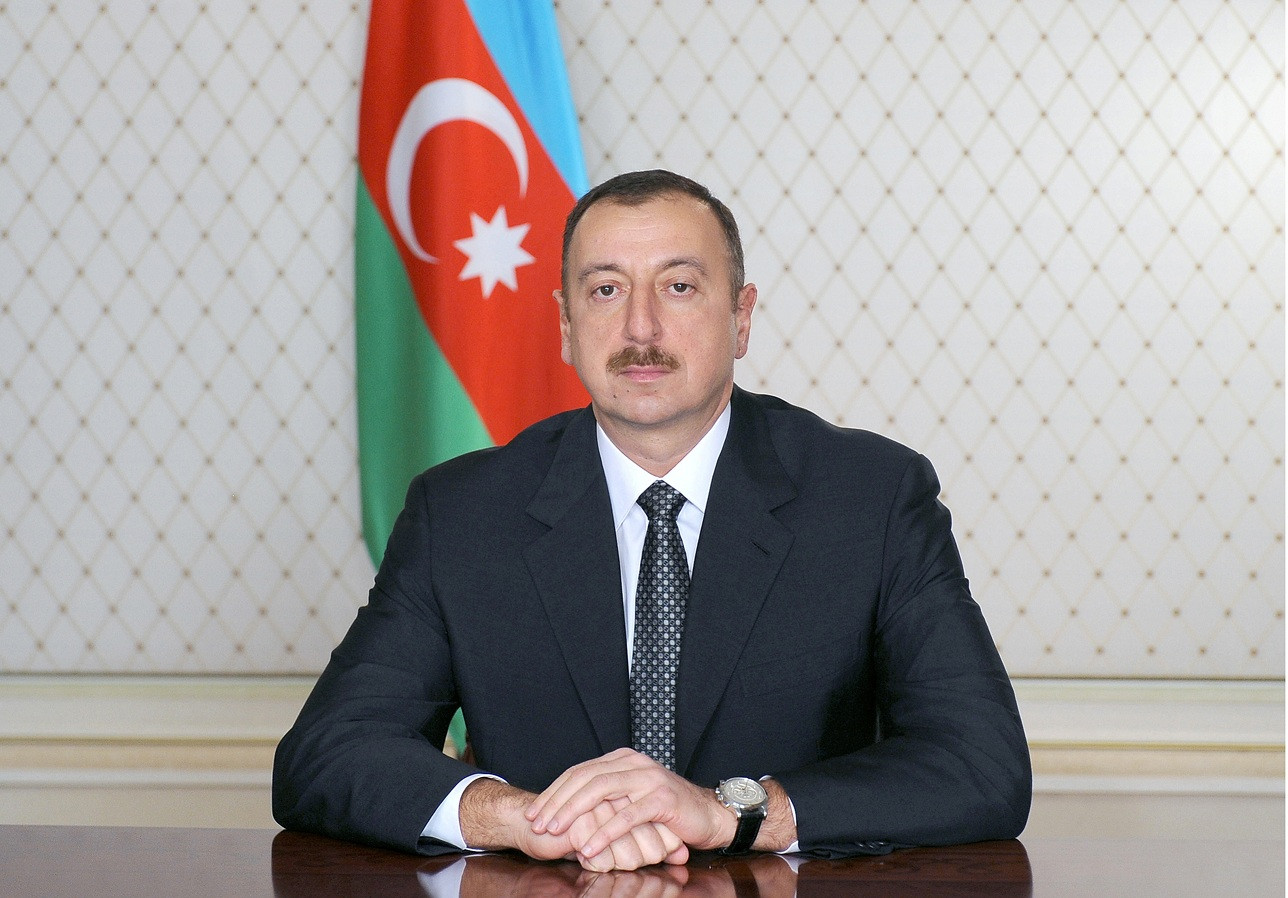
The new President of Azerbaijan, Ilham Aliyev, is a prominent and modern statesman recognized throughout the world. In his native Azerbaijan, he enjoys great respect and authority. Now the political portrait of the President of Azerbaijan is known all over the world.
Prominent political and statesman Ilham Aliyev is the son of the national leader of the Azerbaijani people, genius statesman Heydar Aliyev. He is a professional politician. Graduated from the Moscow State Institute of International Relations in 1982. Here he began his scientific and pedagogical activity (1982), was a graduate student, teacher. Candidate of Historical Sciences (1985). Since 1991, he worked in Moscow as General Director of Orient Company, Vice President for Foreign Economic Relations (since 1994) and First Vice President (since 1997), Prime Minister of the Republic of Azerbaijan (2003). He was the closest ally of Heydar Aliyev in preserving the statehood of Azerbaijan and building a new Azerbaijan.
Ilham Aliyev took an active part in the development of Heydar Aliyev’s oil strategy, the success and implementation of this policy on the world stage, the preparation of various projects in this area, the implementation of very complex diplomatic tasks, played an important role in attracting investment to the country. He took part in the implementation of economic reforms in the country, the expansion of economic and cultural ties of independent Azerbaijan with foreign countries, in particular, the conclusion and implementation of historic agreements with leading oil companies on the joint development of oil and gas fields, including the Baku-Tbilisi-Ceyhan main export oil pipeline. In general, he played an important role in the integration of the Republic of Azerbaijan into the world market. As a result of the implementation of the oil strategy by Ilham Aliyev, who has a great contribution to it, the signing of oil contracts with international companies in 1994-2000, foreign companies provided Azerbaijan with a premium of $ 800 million. More than 30,000 jobs have been created in the oil sector of Azerbaijan.
Ilham Aliyev, who is actively involved in building a democratic, legal and secular state in Azerbaijan, is also a prominent party figure. He is the leader of the country’s leading political party, the Yeni (New) Azerbaijan Party (NAP). Ilham Aliyev was elected deputy chairman of the party at the first congress of the New Azerbaijan Party (1999) and first deputy chairman at the second congress (2001). Having adequately coped with this important task, Ilham Aliyev very effectively mobilized the broad masses of the population for the construction of a new Azerbaijan. In the 2000 parliamentary elections, Ilham Aliyev led the YAP campaign. It was under his leadership that the YAP won a convincing victory in these elections and received a significant majority in the Milli Mejlis.
During his tenure as a deputy of the Milli Majlis, Ilham Aliyev has carried out extensive and multifaceted activities. He was always among the people, studied their problems, regularly showed concern for those in need of social protection. At that time, Ilham Aliyev’s concern for various strata of society, refugees, internally displaced persons, and invalids of the Karabakh war, his great construction work in the Garadagh region and other regions of the country are vivid manifestations of this concern for his native people.
The activity of Ilham Aliyev, a member of the permanent parliamentary commission on international relations and inter-parliamentary relations, as head of the permanent delegation of the Azerbaijani parliament to the Parliamentary Assembly of the Council of Europe (PACE), is an example of determination, courage, and service to his people. His purposeful, decisive, and bold speeches in PACE had a strong impact on the further growth of Azerbaijan’s prestige in the European space. Thanks to the tireless activity and decisive speeches of Ilham Aliyev, the Armenian aggressors were exposed in the Council of Europe, an objective opinion about Nagorno-Karabakh, an integral part of Azerbaijan, and the so-called « Nagorno-Karabakh problem » was formed in the Western world, he was given a correct political assessment and important steps were taken to its permission. Ilham Aliyev played an important role in the recognition of Armenia as an occupying power, proving that Armenian terrorism is an integral part of international terrorism, and conveyed to Europe and the world community that Nagorno-Karabakh, which got out of control, became a transit zone for drug trafficking and an accomplice of terrorism… His activities in the Council of Europe, his objective and constructive speeches in PACE have earned Ilham Aliyev great respect and prestige among Western politicians. He was elected PACE Vice-Speaker and Bureau member (January 2003).
Ilham Aliyev has shown an unprecedented commitment to the implementation of the youth policy of President Heydar Aliyev and continues to work successfully in this area. Appointed as President of the National Olympic Committee of the Republic of Azerbaijan in 1997, Ilham Aliyev soon showed a high level of organizational skills in this area. Thanks to his tireless and hard work, within a short period of time, Azerbaijani sport was revived and gained worldwide fame. The brilliant success of Azerbaijani athletes in international competitions is, first of all, a great political victory of the sports movement headed by Ilham Aliyev.
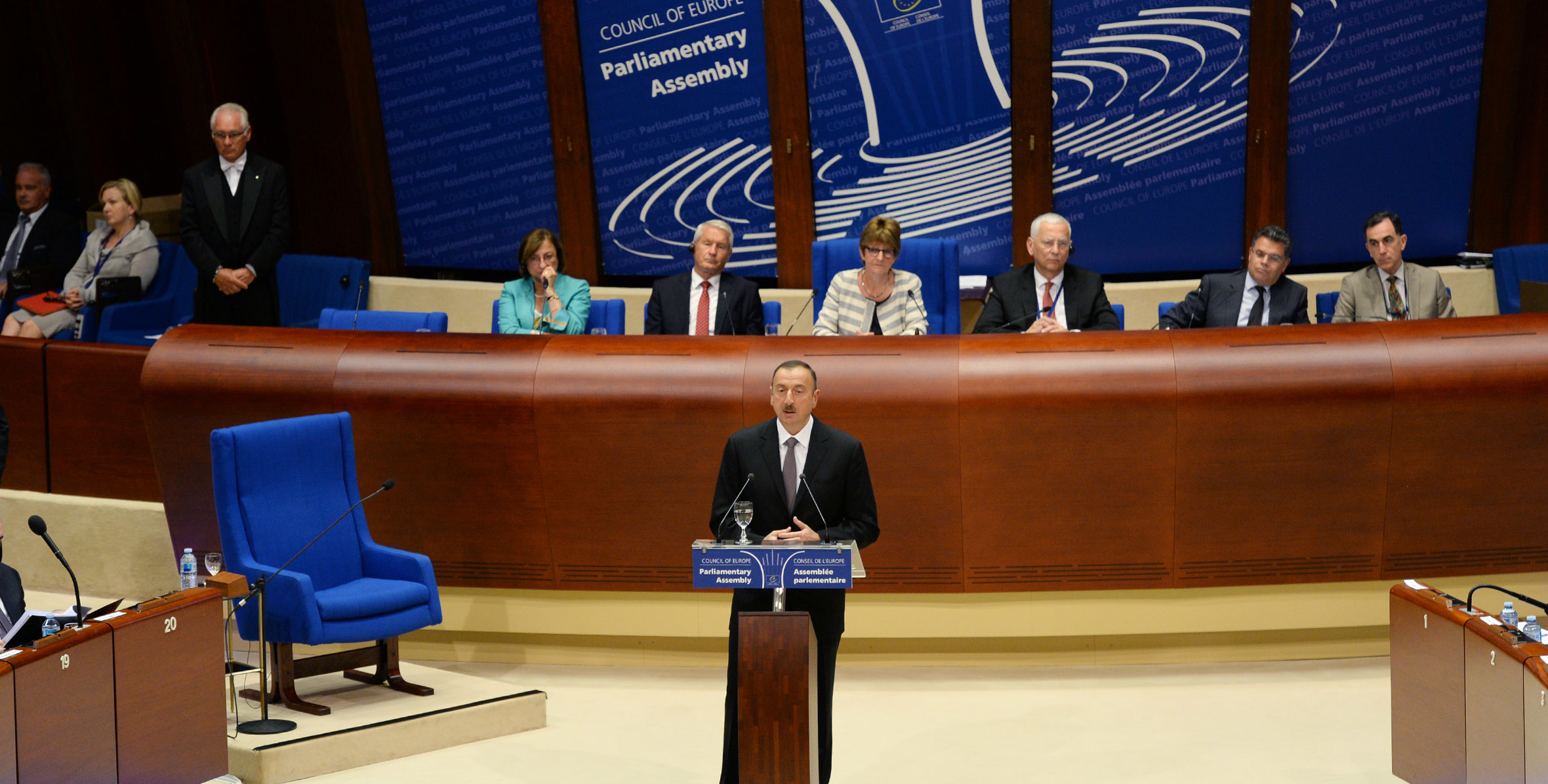
Ilham Aliyev, as a forward-looking statesman and politician, is committed to educating healthy youth and, thus, turning the sport into a nationwide movement to ensure a healthy future for our people. On his initiative, the construction and commissioning of Olympic sports and recreation complexes not only in the capital of Baku but also in the regions, the creation of solid material and technical base for the development of various sports are vivid manifestations of a wise policy aimed at a healthy future.
At present, the leading position of Azerbaijan in international competitions, in various fields of sports, the transformation of Baku into the center of important international competitions in the world further increases the glory of Azerbaijan and has a positive effect on its international reputation. This is one of the greatest successes of Ilham Aliyev’s youth policy.
Ilham Aliyev has won great respect and authority in the world as a professional politician with deep knowledge of the history of international relations. As the head or member of the Azerbaijani delegation, he paid official visits to the United States, Great Britain, Turkey, France, Russia, Ukraine, Switzerland, Kazakhstan, Uzbekistan, Slovakia, Poland, Georgia, and other countries. He has spoken at many international conferences and congresses.
Ilham Aliyev was a deputy of the Milli Mejlis of the Republic of Azerbaijan (1-2 convocations), in fact, he headed the permanent delegation of the Azerbaijani parliament to PACE and the PACE vice-speaker, as well as a member of the bureau. Considering his services to the Azerbaijani people, Ilham Aliyev was appointed Prime Minister of the Republic of Azerbaijan in 2003. He won the 2003 presidential elections and was elected President of the Republic of Azerbaijan by the will of the people.
President Ilham Aliyev successfully continues the policy of building a democratic, legal and secular state of the great son of the Azerbaijani people, Heydar Aliyev. President Ilham Aliyev has always focused on ensuring a fuller provision of human rights and freedoms in the country. It successfully implements the course of Heydar Aliyev on the preservation and further development of the national and moral values of the Azerbaijani people. His Decrees « On the publication of the National Encyclopedia of Azerbaijan » and « Implementation of mass publications in the Azerbaijani language using the Latin alphabet » (January 12, 2004), he personally took over the publication of the National Encyclopedia and signed in this regard decrees increasing the additional salaries of scientists for obtaining academic degrees, scholarships for students, masters and graduate students, the state’s concern for national and universal values is a manifestation of this concern. Ilham Aliyev pays special attention to the historical past of the Azerbaijani people. He highly appreciated the role of the Azerbaijan Democratic Republic in the history of our statehood: “The creation of the Azerbaijan Democratic Republic was a very significant and important event in our history. For the first time in the Muslim world, a democratic republic was established and the Azerbaijani people gained independence. Our country was a member of the world community. It was a very significant event ».
On October 19, 2006, Ilham Aliyev signed a decree on the State Program for the Education of Azerbaijani Youth Abroad, instructing the relevant executive authorities to develop a State Program for the Education of Azerbaijani Youth Abroad. Accordingly, on April 16, 2007, he approved the State Program of Training Azerbaijani Youth Abroad for 2007-2015.
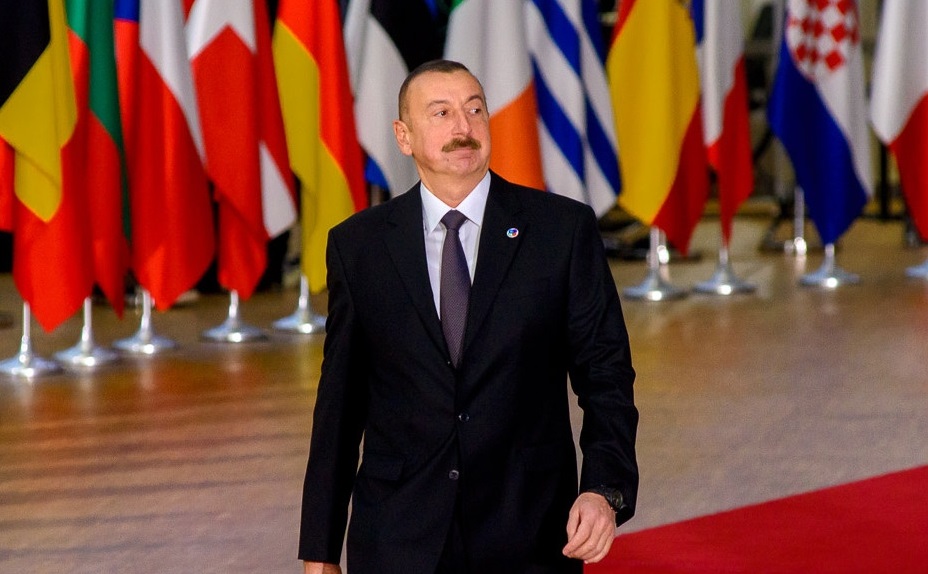
The development concept « Azerbaijan 2020: Vision of the Future » is considered one of the main strategic initiatives of Ilham Aliyev for the future development of the country. The corresponding order on the development of this concept was adopted on November 29, 2011, and the concept was approved by the Decree of December 29, 2012. The concept provides for measures and measures to develop various sectors of the economy and improve the well-being of the population by 2020. When evaluating Azerbaijan’s Voluntary Report on the Implementation of the UN Sustainable Development Goals, the Development Concept « Azerbaijan 2020: Vision for the Future », approved by Ilham Aliyev, was described as a strategy reflecting long-term national interests, opportunities for investors, and key issues. The same approach was noted in the Report prepared for the World Economic Forum 2015 and published in the Journal of Foreign Policy. Business Year magazine, which specializes in economics, characterized the concept initiated by Ilham Aliyev as a smart strategy aimed at protecting Azerbaijan’s national economic interests.
He protects the interests of Azerbaijan at a high level in all spheres in the rapidly changing modern world, in the processes of globalization and integration, at all international meetings and negotiations. Thanks to the successful foreign policy of Ilham Aliyev, the role and prestige of Azerbaijan in solving international and regional problems are increasing.
As a result of the decisive and purposeful activity of President Ilham Aliyev, the Victory Army of Azerbaijan ended the 30-year occupation. Thus, the myth of the « invincible army », created by the enemy of the years, rose to the eyes of the whole world for 44 days, the Armenian army was defeated, and the operation « Iron Fist » ended the Glorious Victory of Azerbaijan. The Supreme Commander-in-Chief, Ilham Aliyev, with a broad outlook, deep and universal knowledge, and high culture, gave dozens of interviews during the war and answered provocative questions from some journalists; answered with historical facts and proofs.
President of Azerbaijan Ilham Aliyev has been awarded honorary titles and awards of many countries and international organizations awarded a diploma and a medal of honorary member of PACE.
Thanks to the wise internal reforms, implemented by President Ilham Aliyev, and far-sighted, purposeful foreign policy, Azerbaijan has become a leader in the South Caucasus.
AZƏRBAYCAN TARİXİ XƏRİTƏLƏRİ
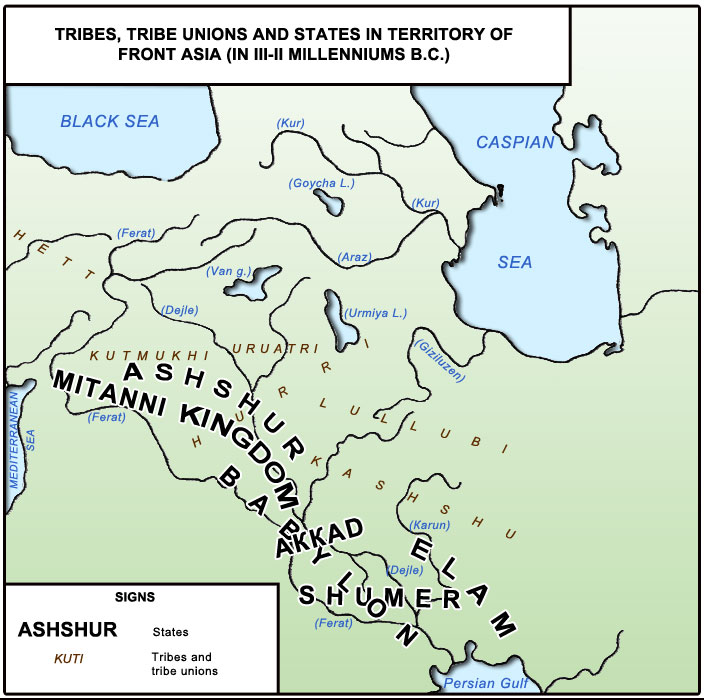


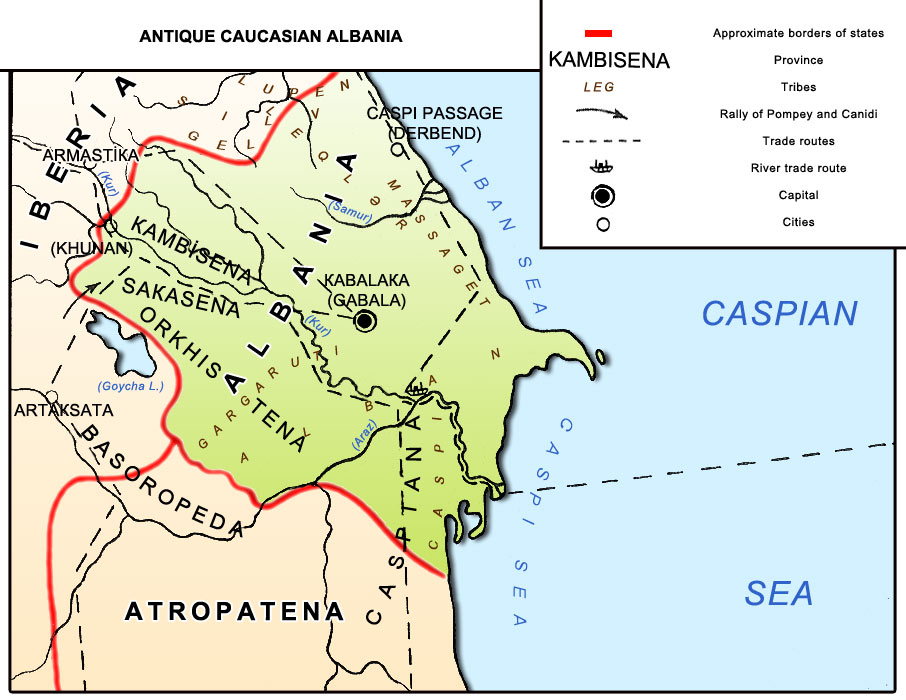


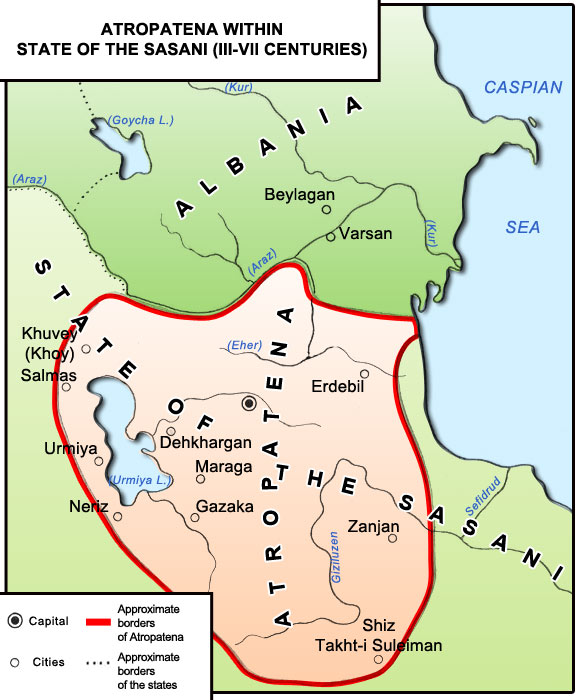
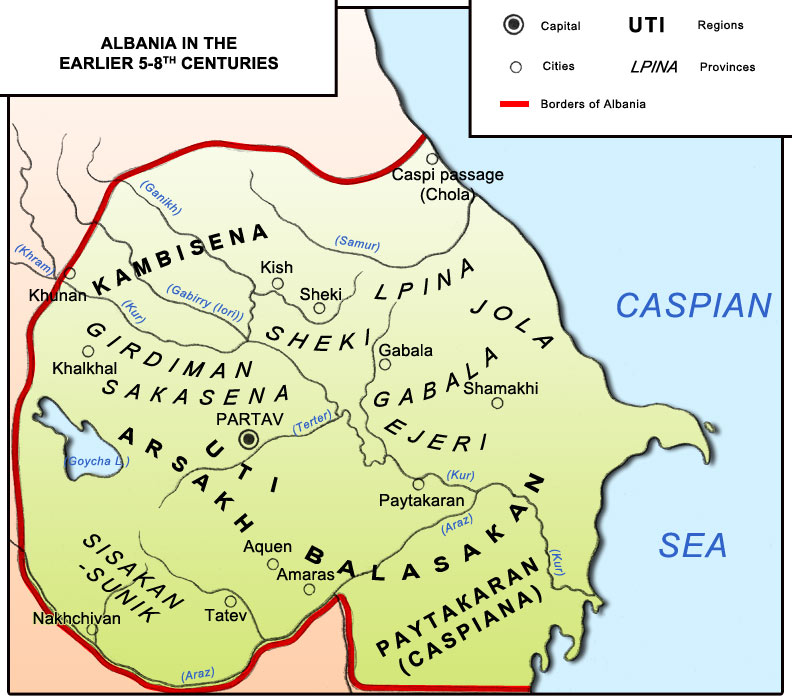

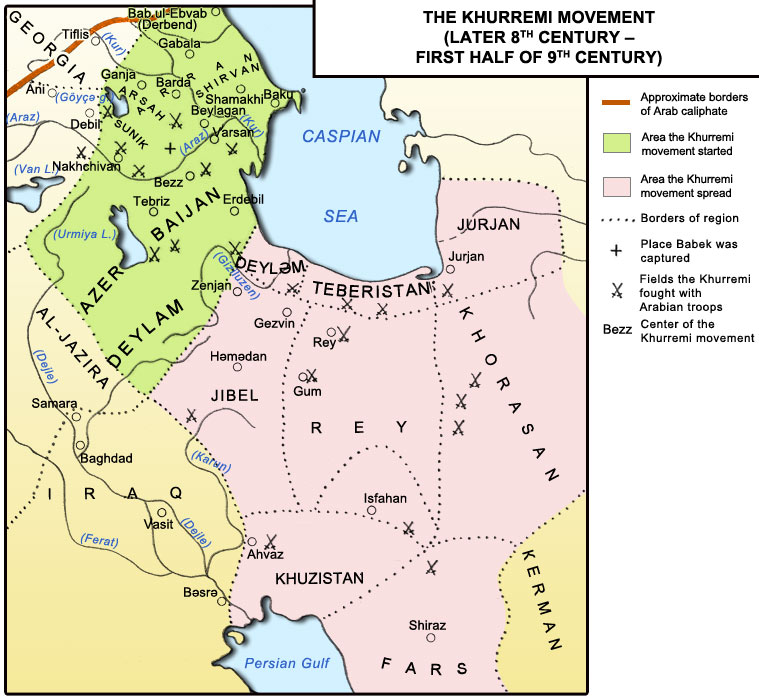
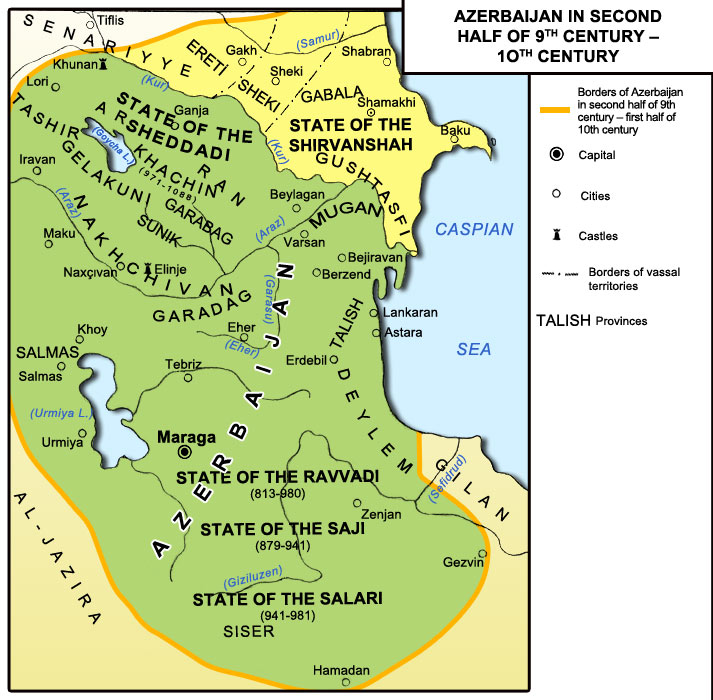
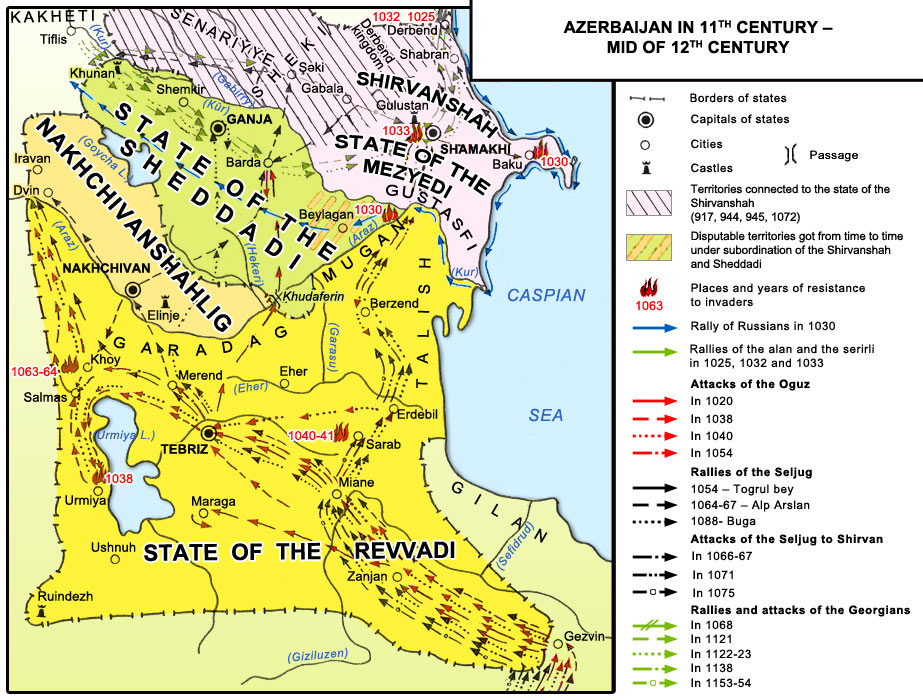
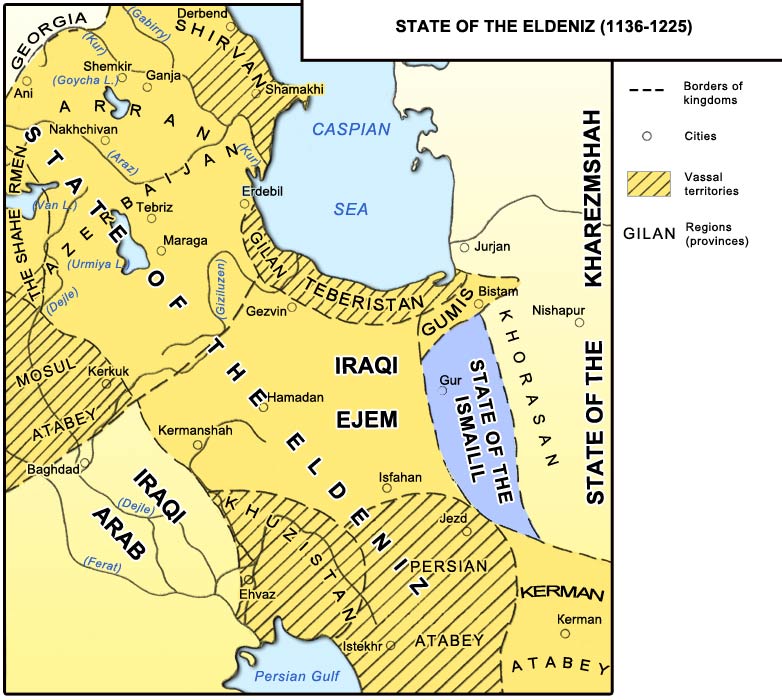
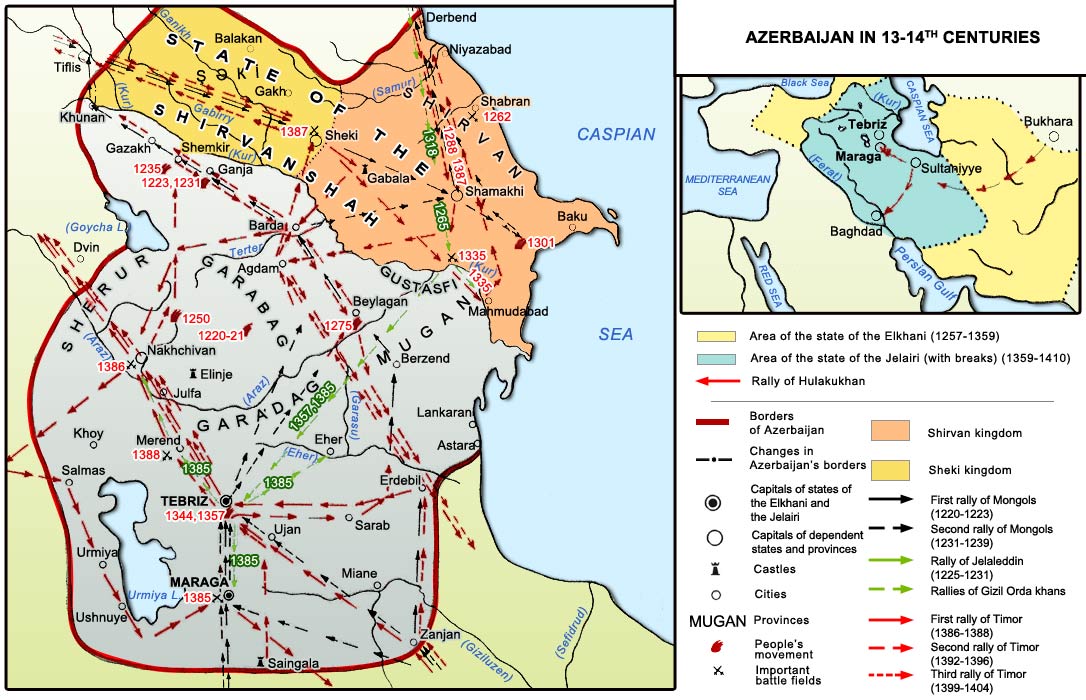
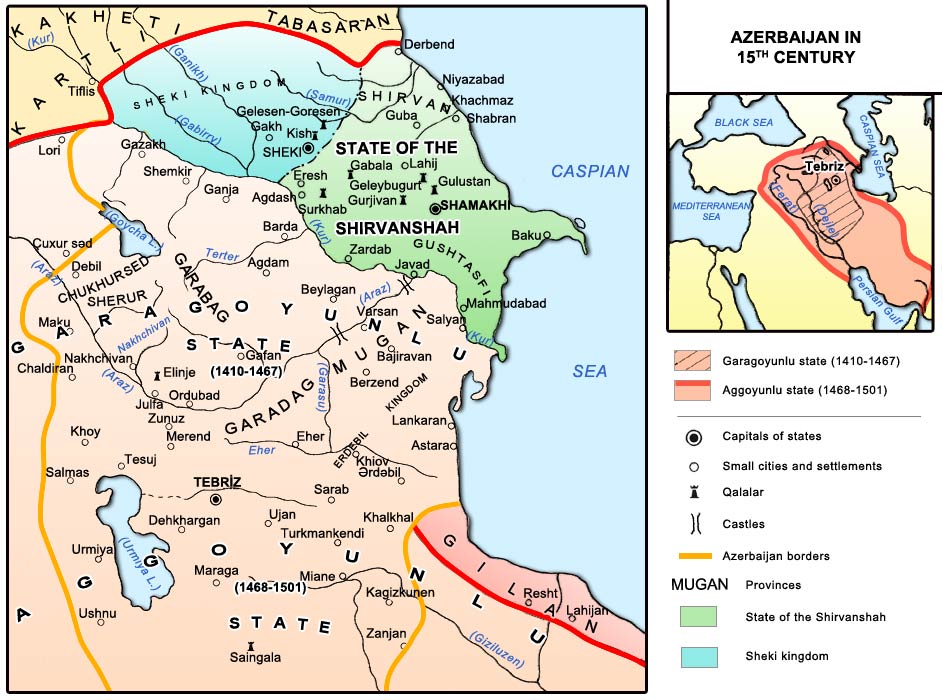



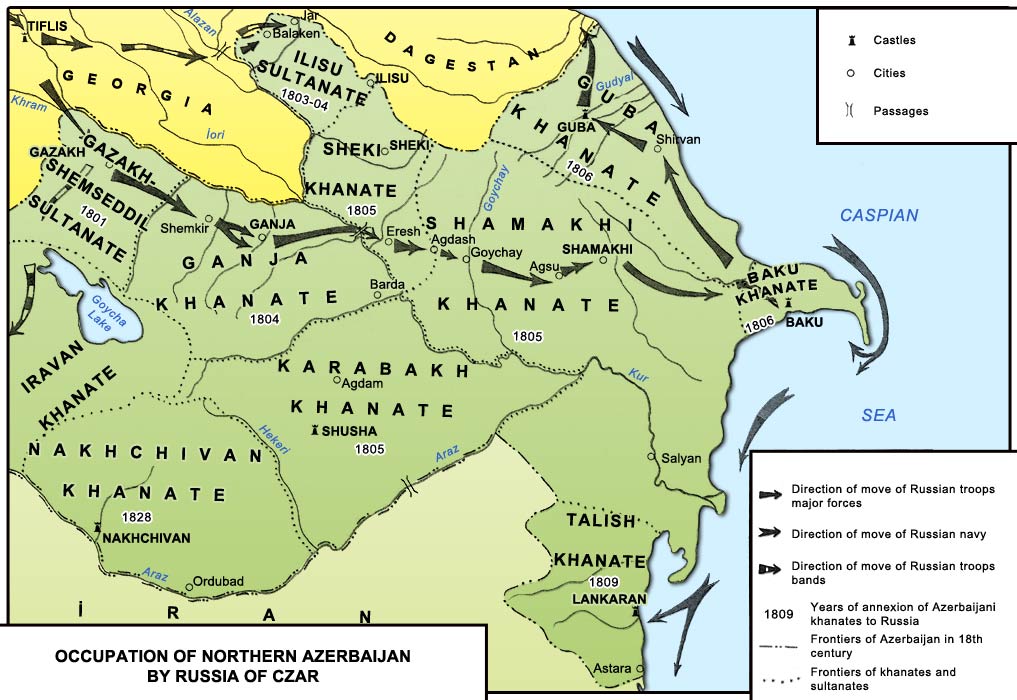
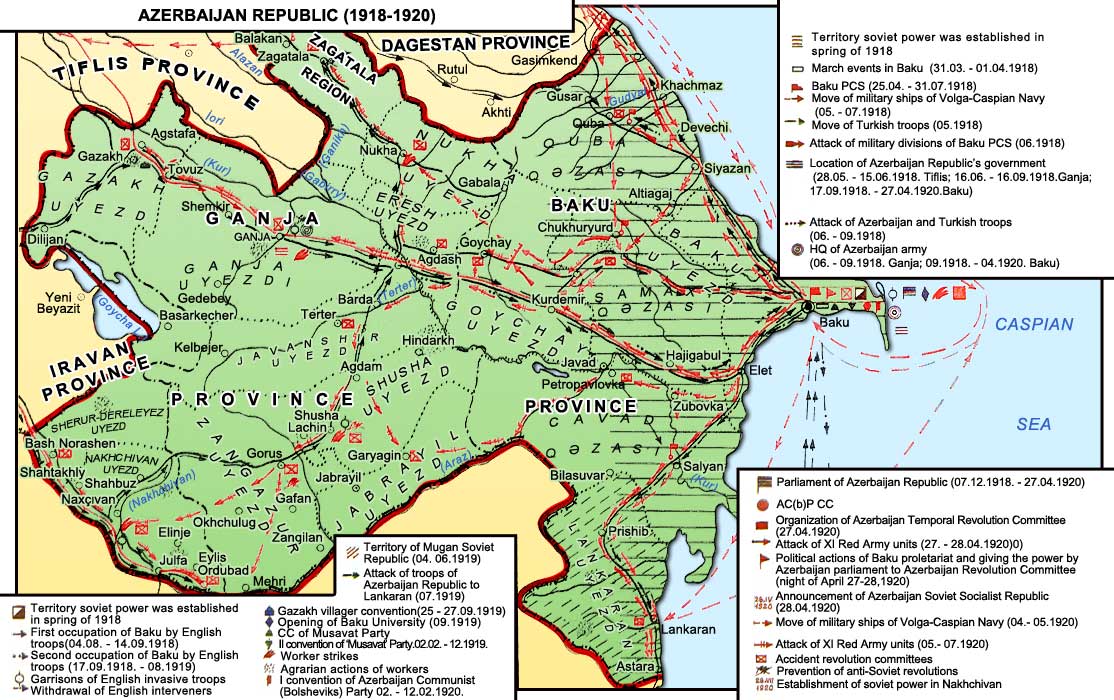
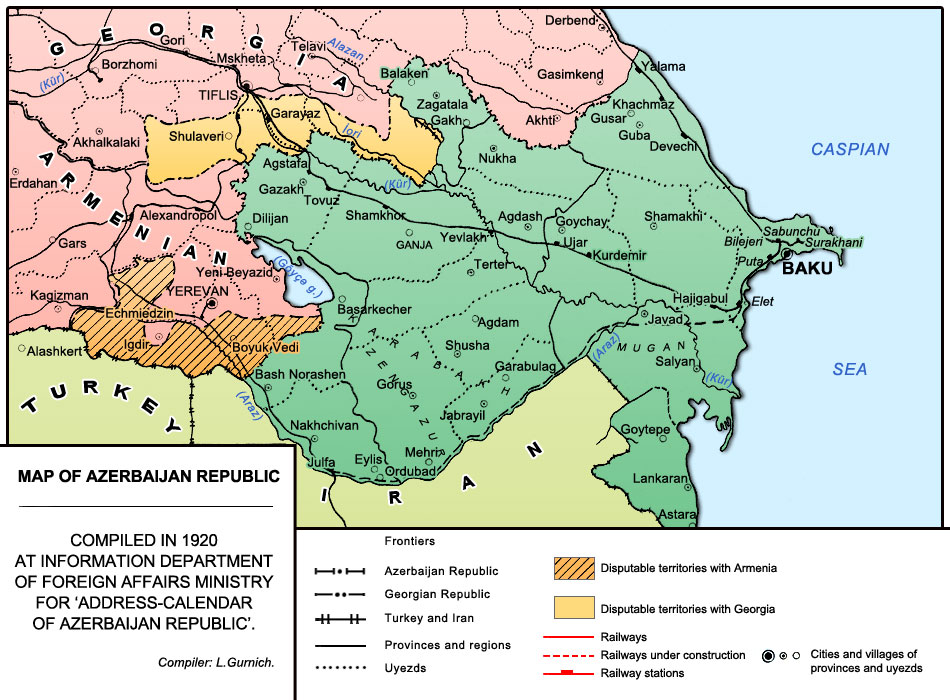
Historical maps of Azerbaijan. Atlas. Baku, 1994
HISTORICAL DOCUMENTS
Azerbaijan Democratic Republic (1918-1920)
The Soviet Socialist Republic of Azerbaijan
- Kars Treaty, 13 October 1921
- The Decree of 7 July 1923 on the establishment of « Nagorny Karabakh Autonomous Province »
- Decree №4083 of the USSR Council of Ministers. December 23, 1947. Moscow, Kremlin.
On the resettlement of kolkhoz members and other Azerbaijani population from the Armenian SSR to Kur-Araz lowlands of Azerbaijan SSR - Decree №754 of the USSR Council of Ministers.March 10, 1948. Moscow, Kremlin.
On the measures of resettlement of kolkhoz members and other Azerbaijani population from the Armenian SSR to Kur-Araz lowlands of Azerbaijan SSR
Republic of Azerbaijan
UN
OSCE
- Conference for Security and Co-operation in Europe, First Additional Meeting of the Council, Helsinki, March 1992, Summary of Conclusions
- Conference for Security and Co-operation in Europe, 1994 Budapest Summit
- Organization for Security and Co-operation in Europe, 1996 Lisbon Summit, 2-3 December 199
PACE

